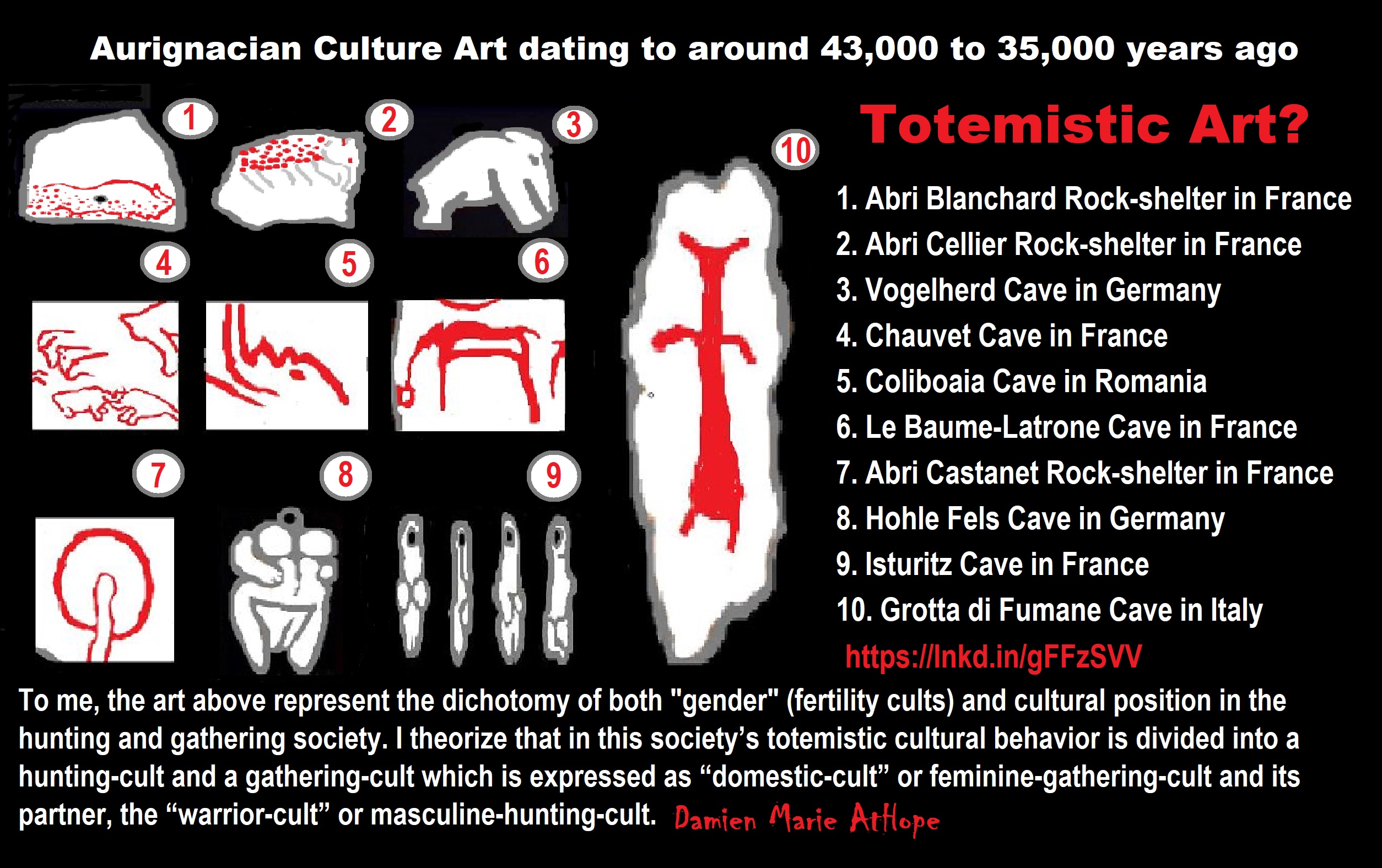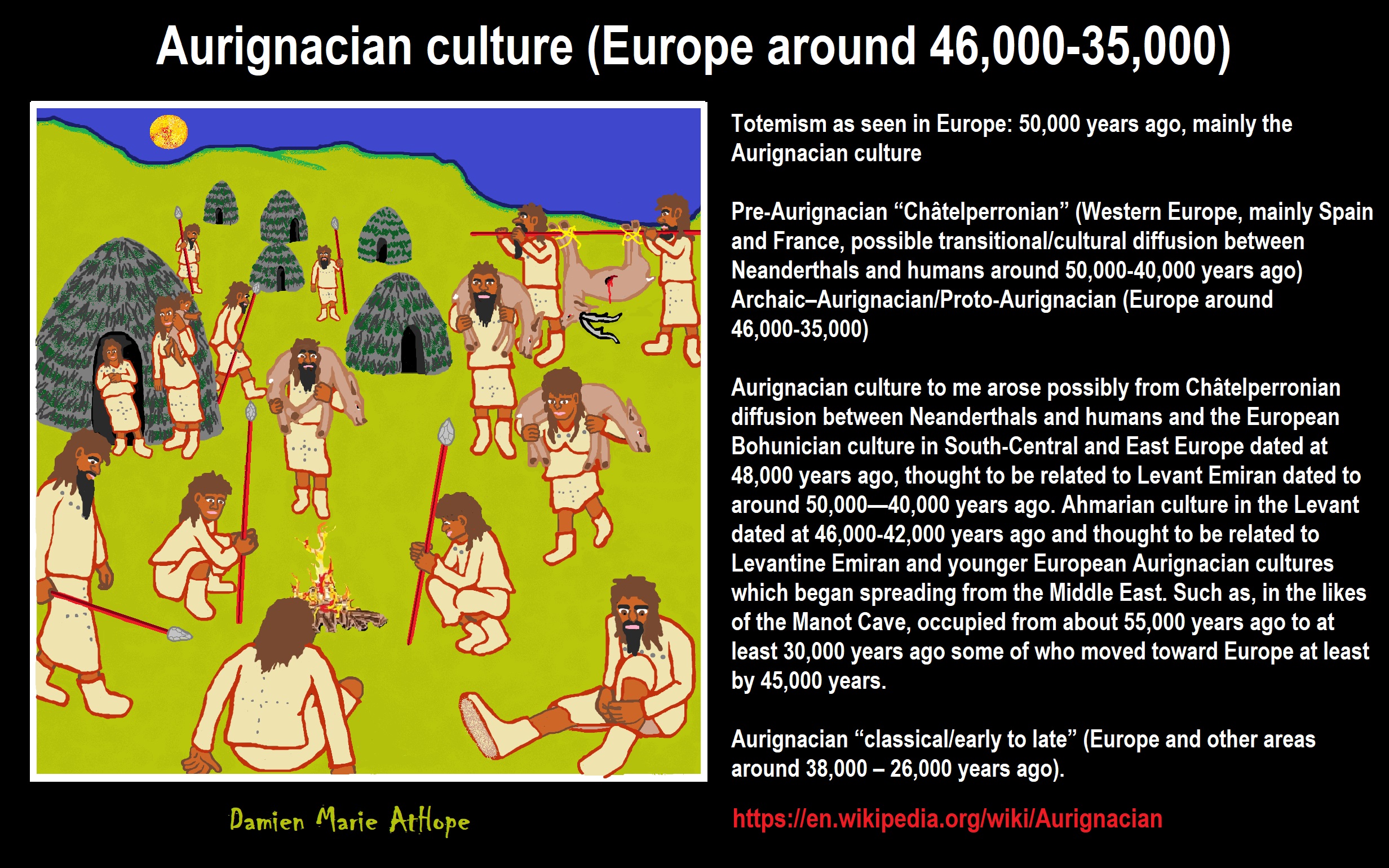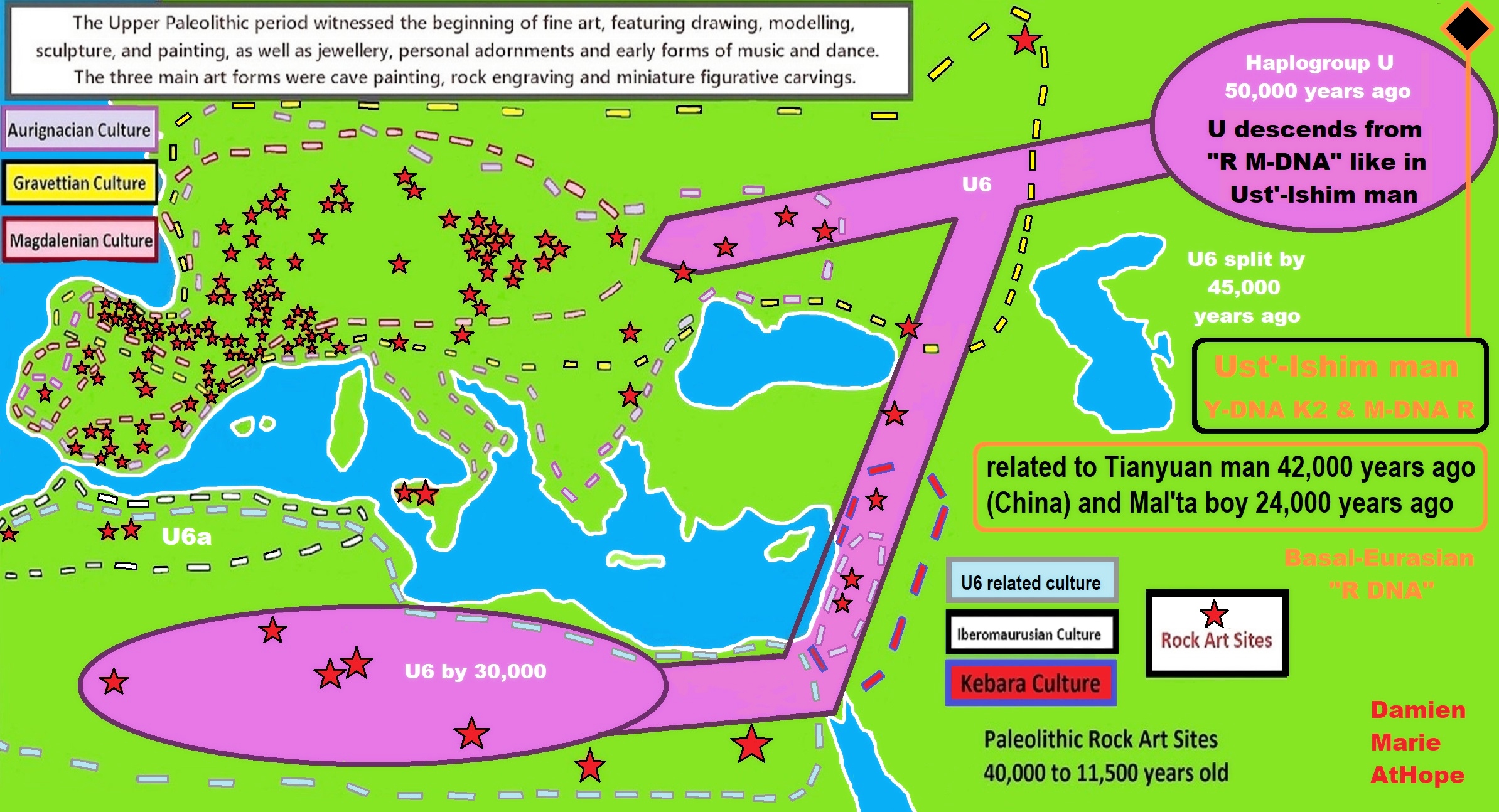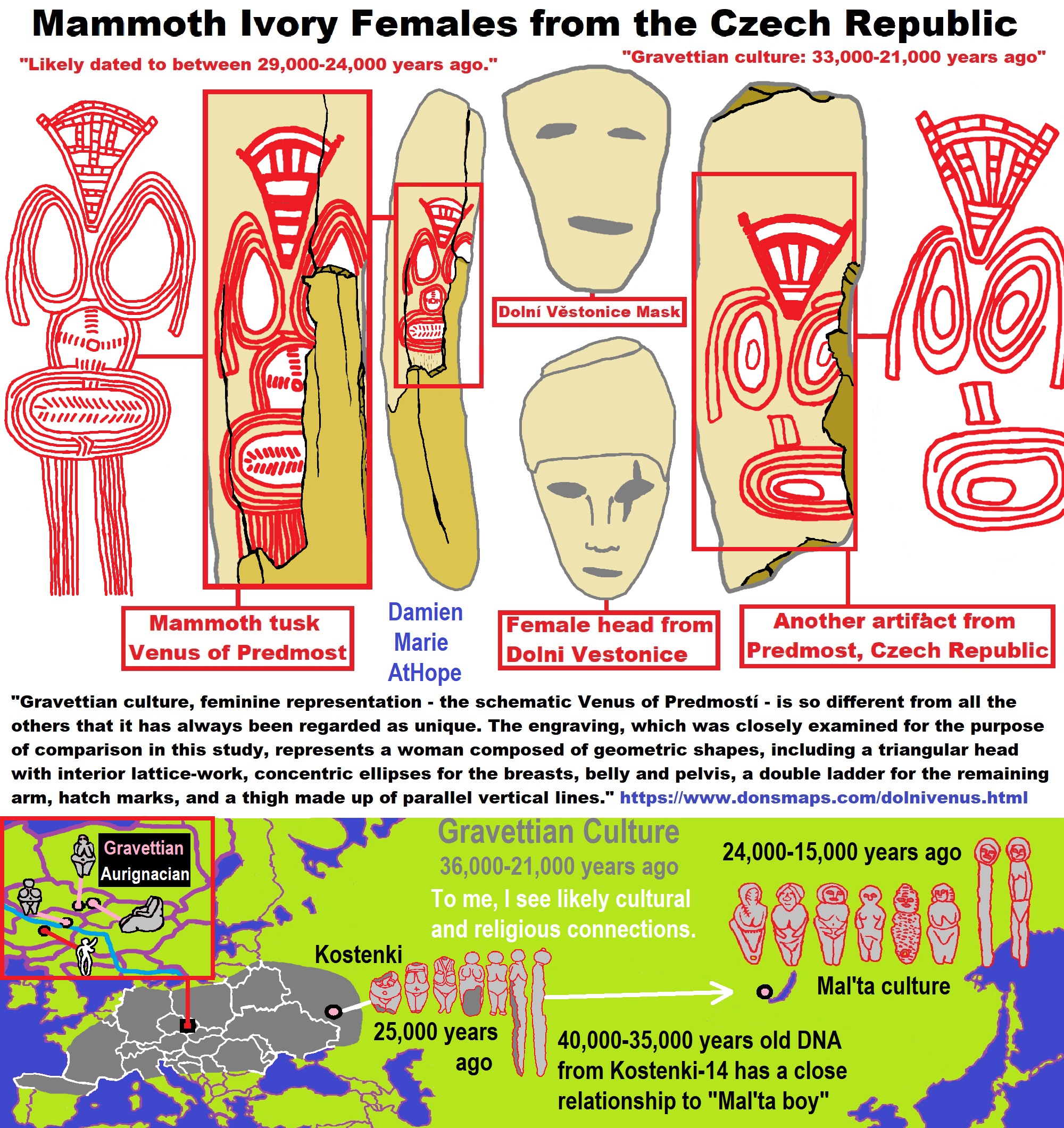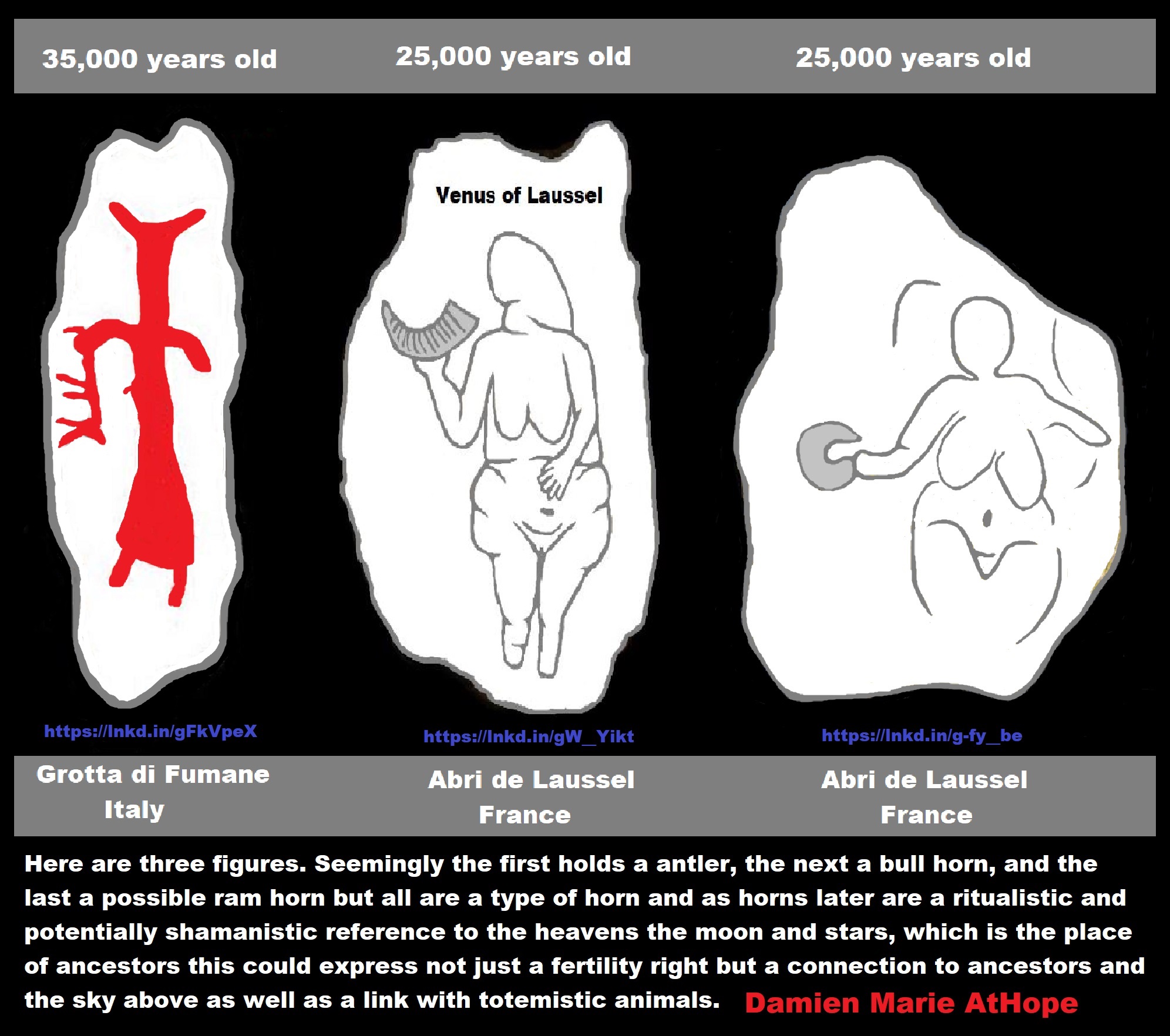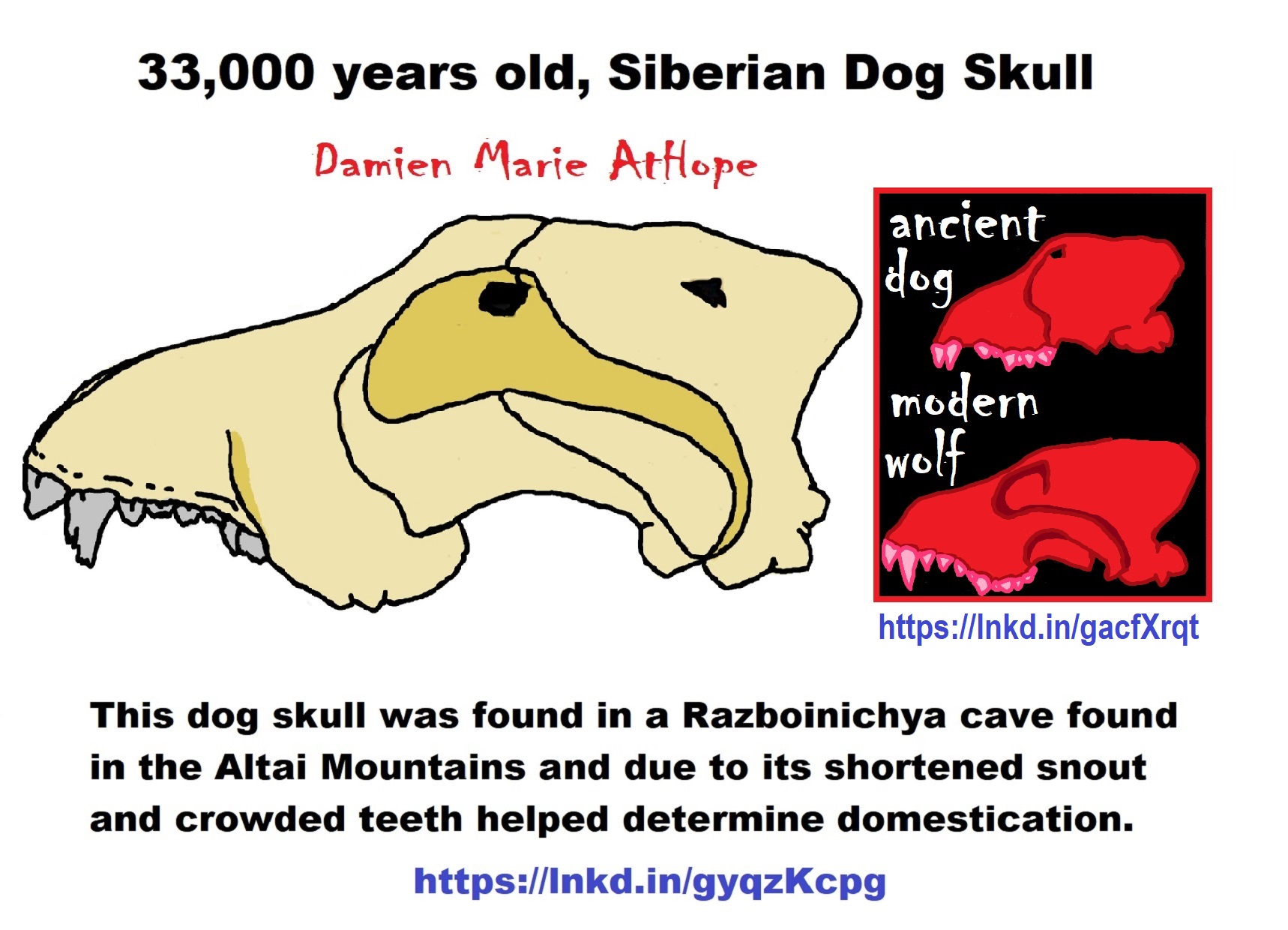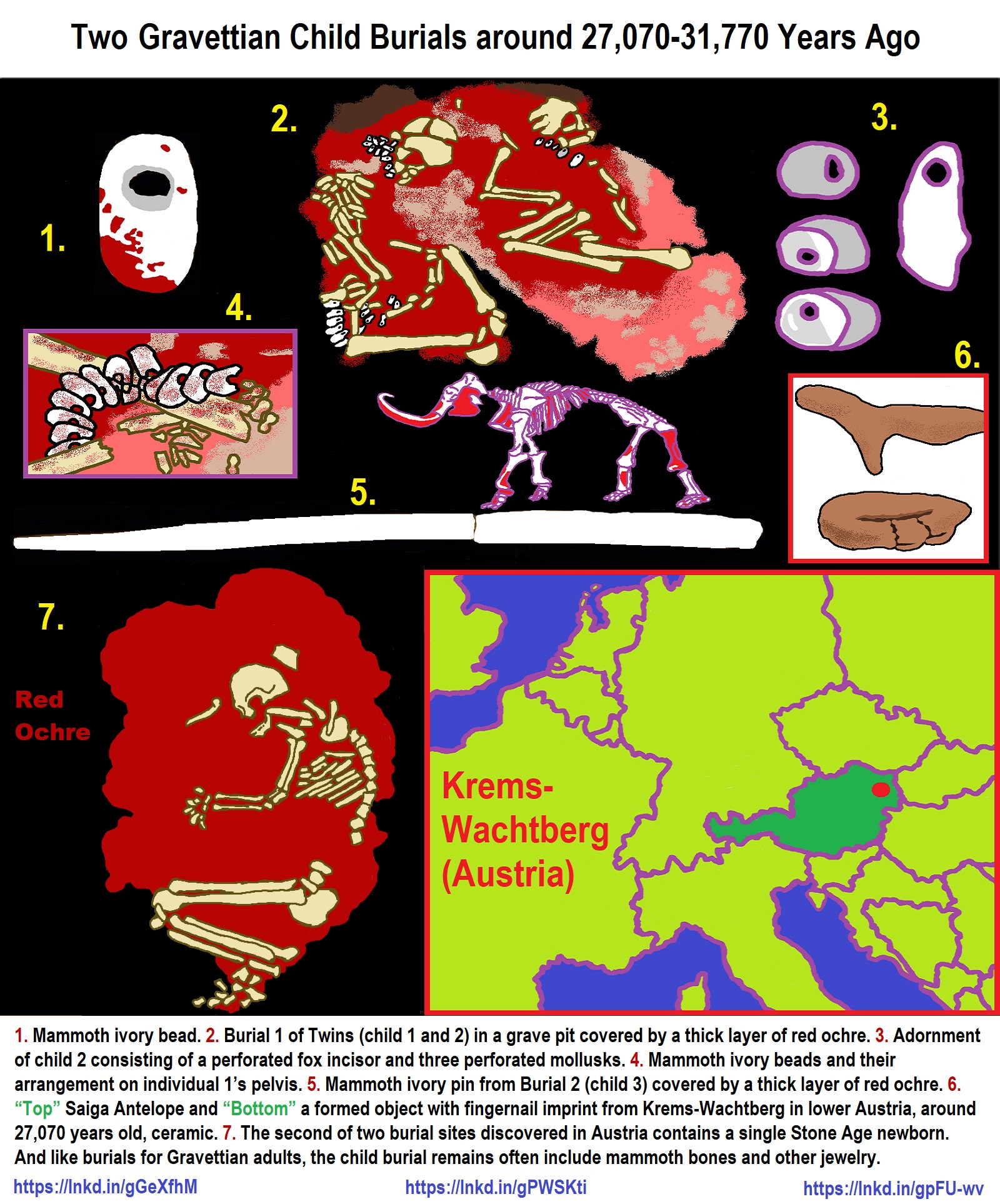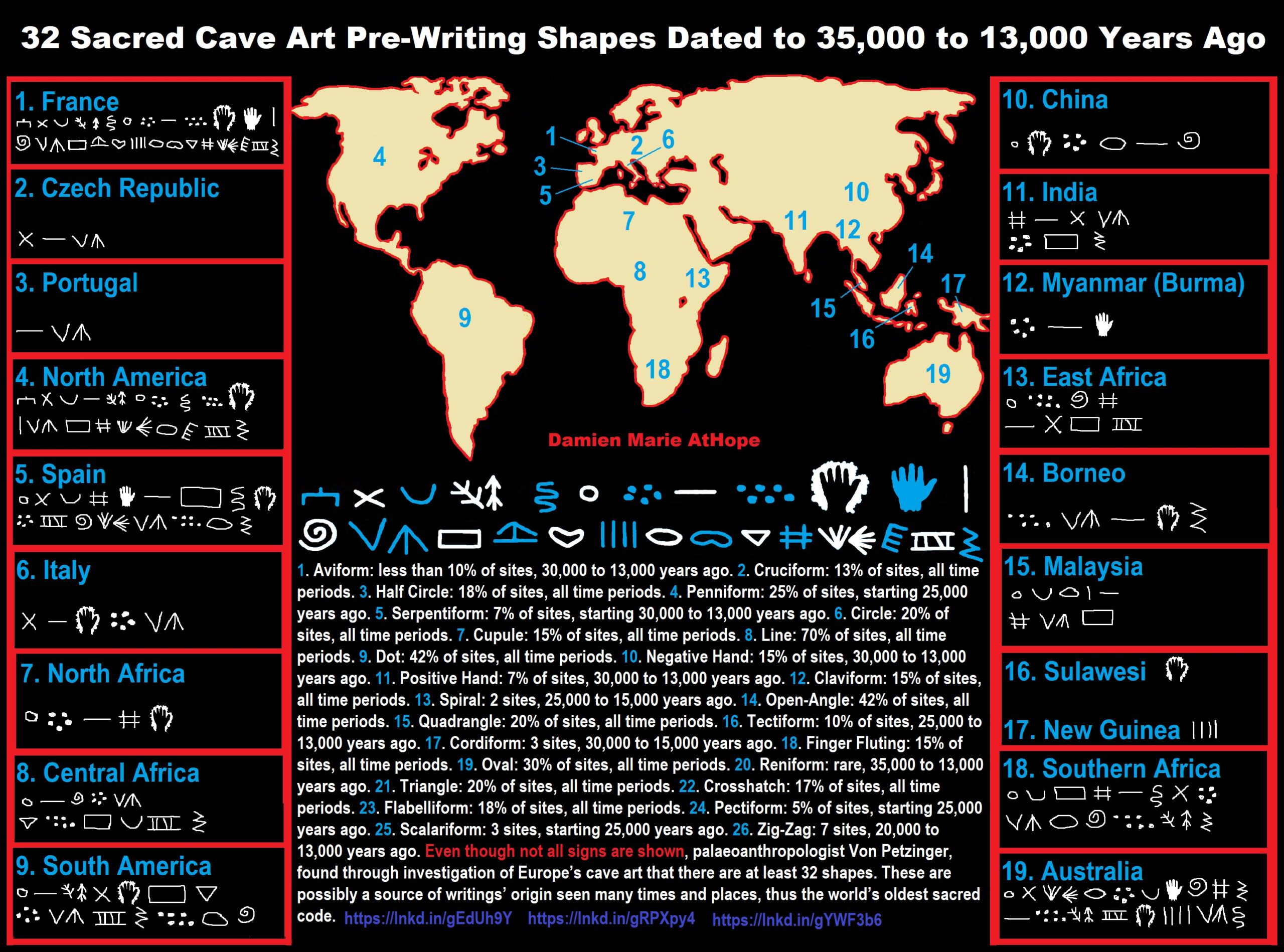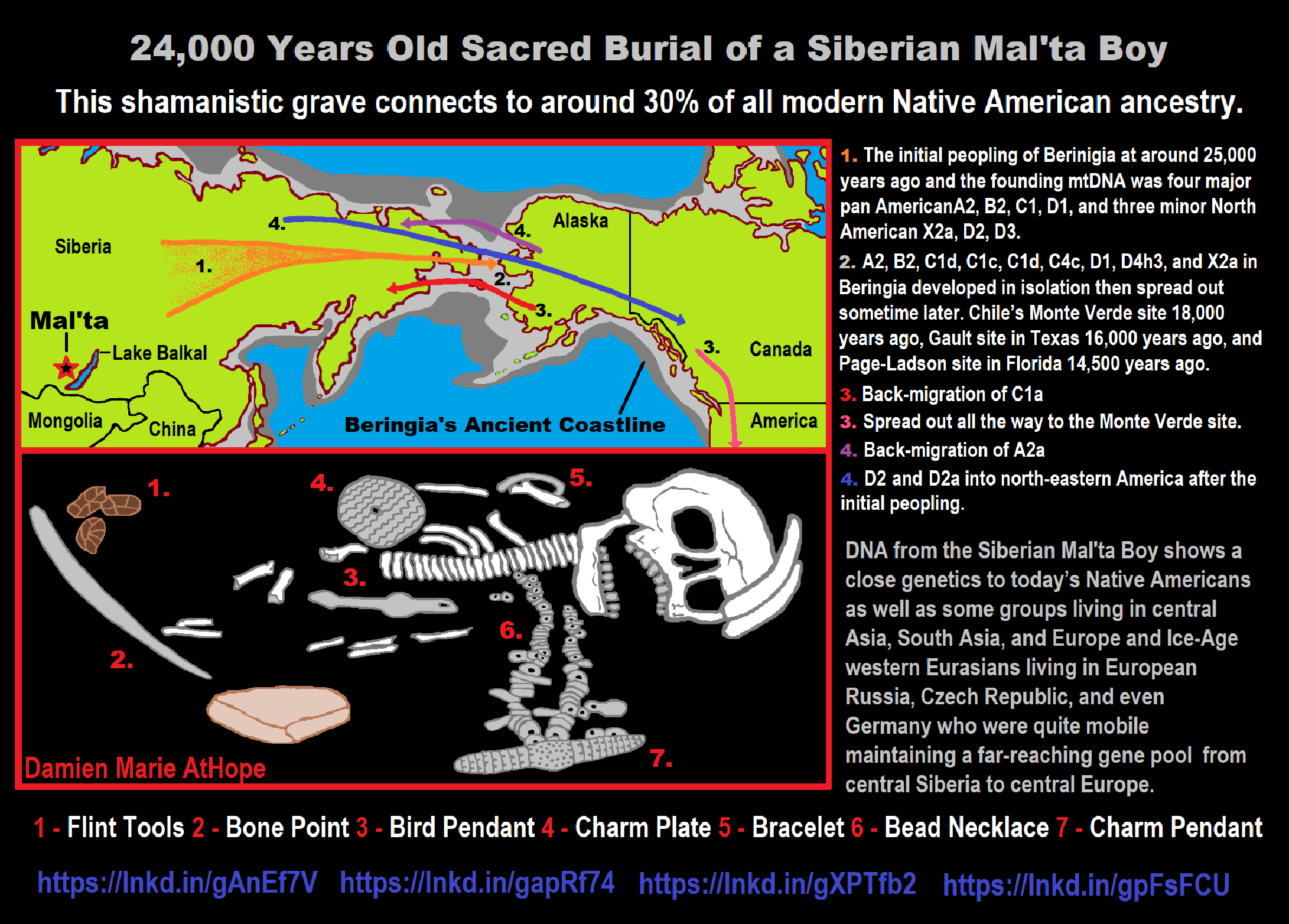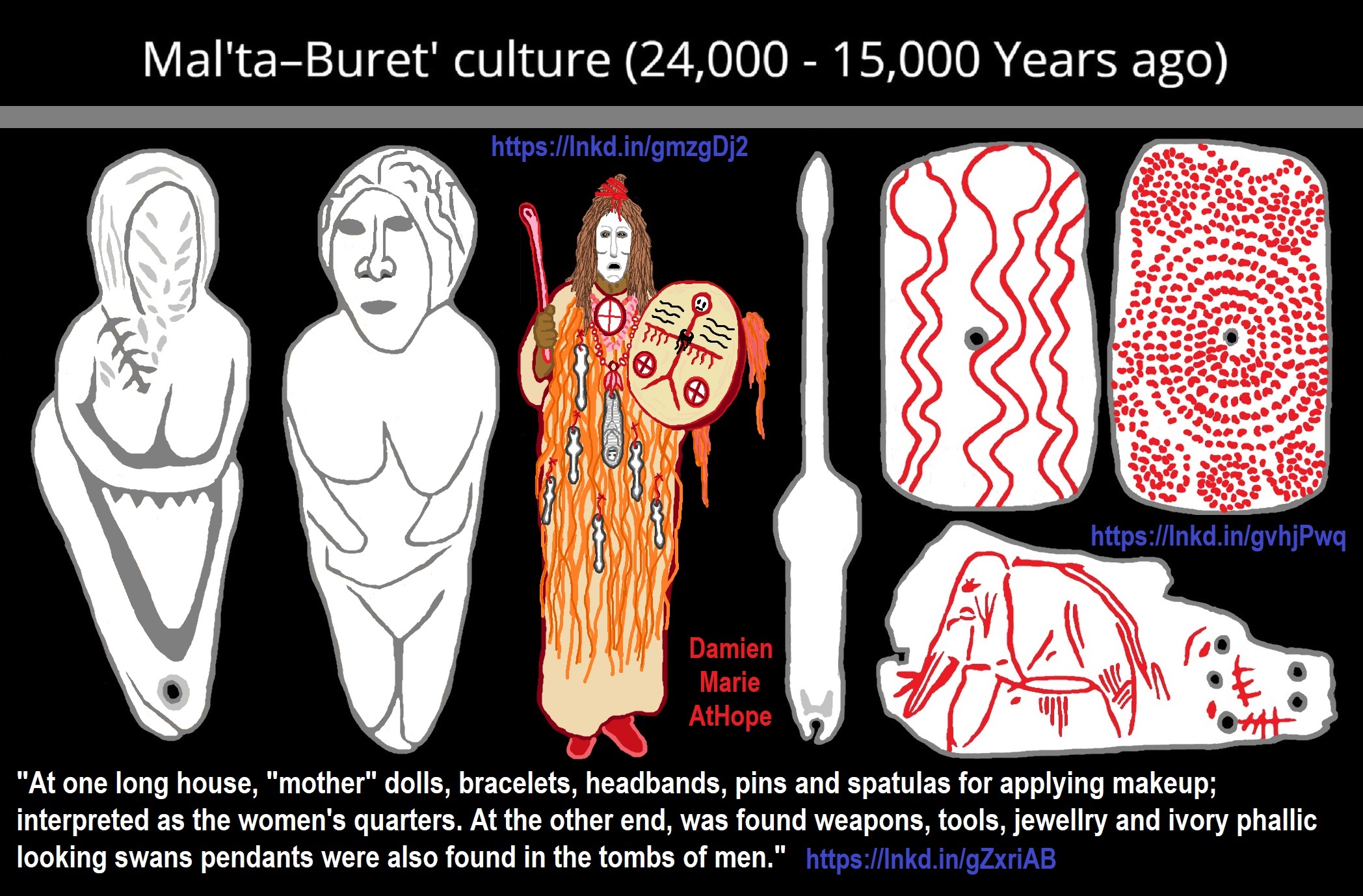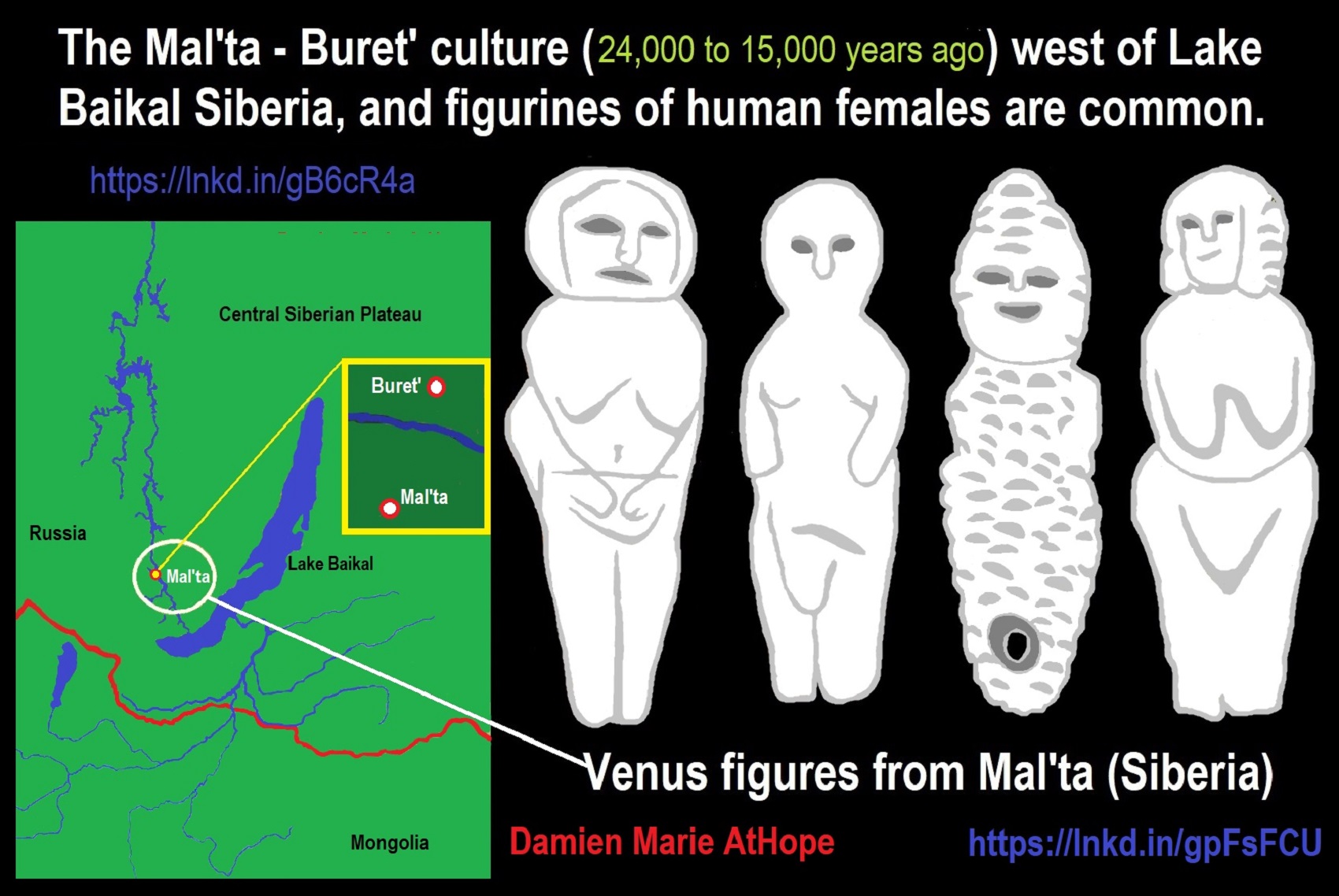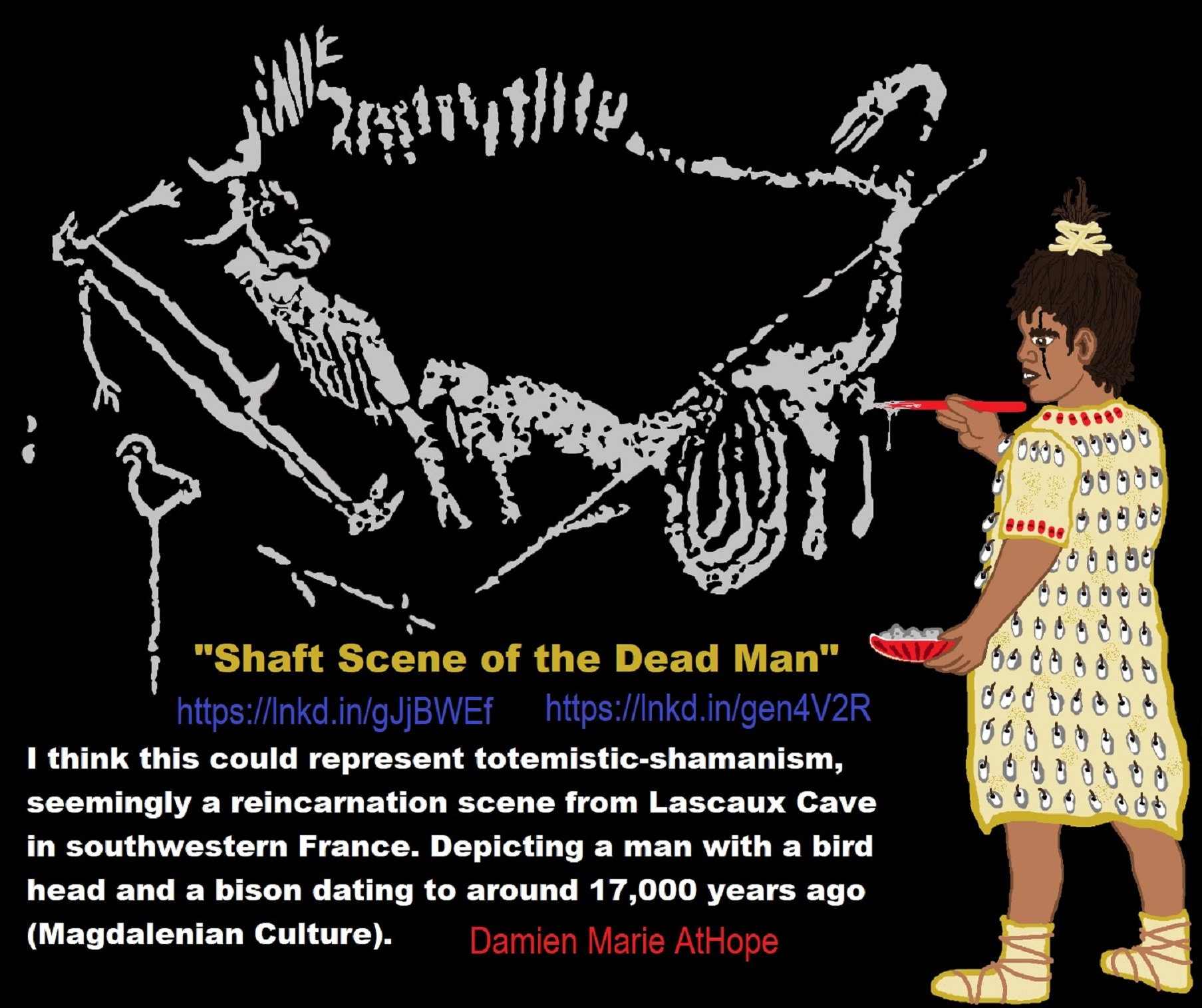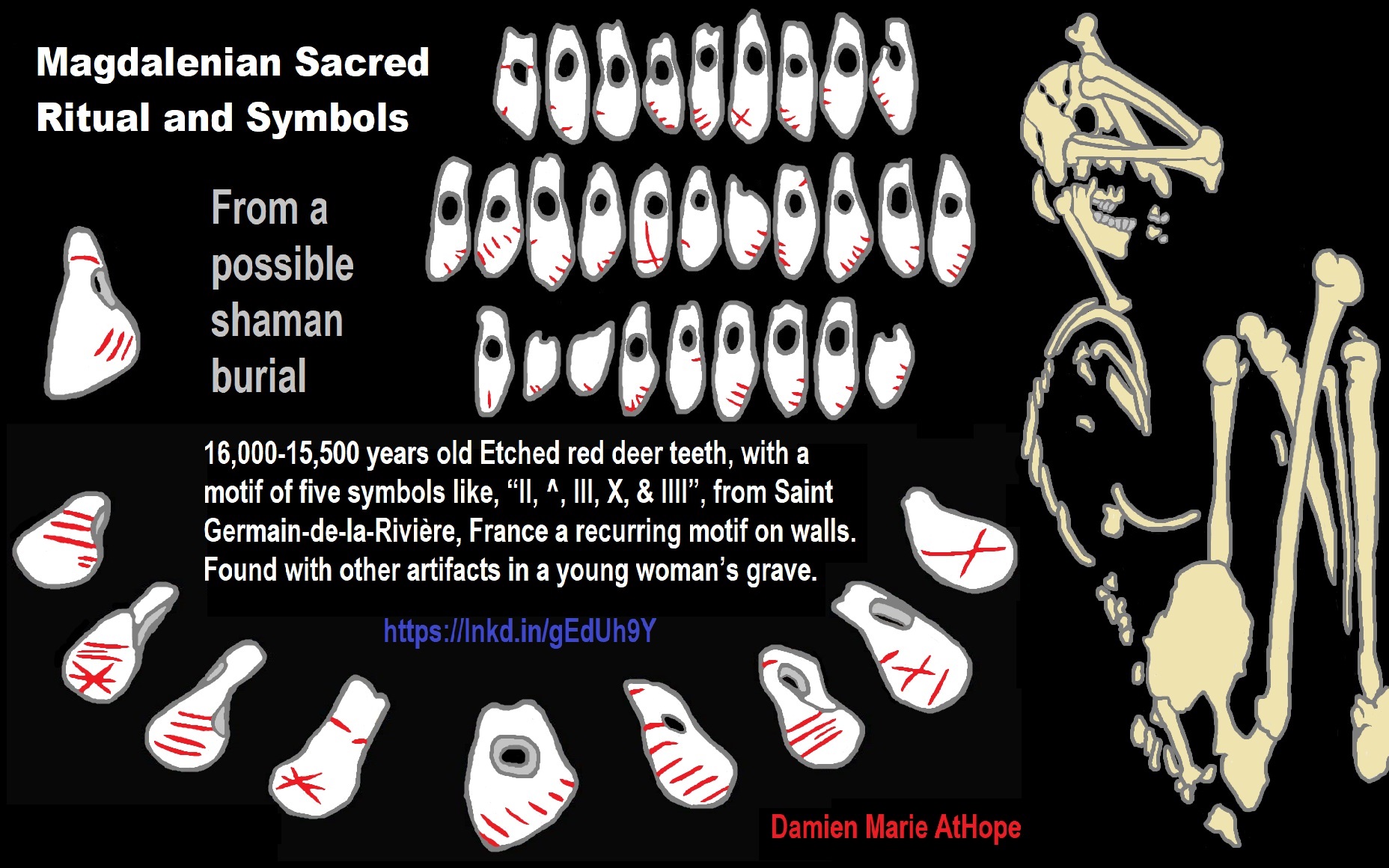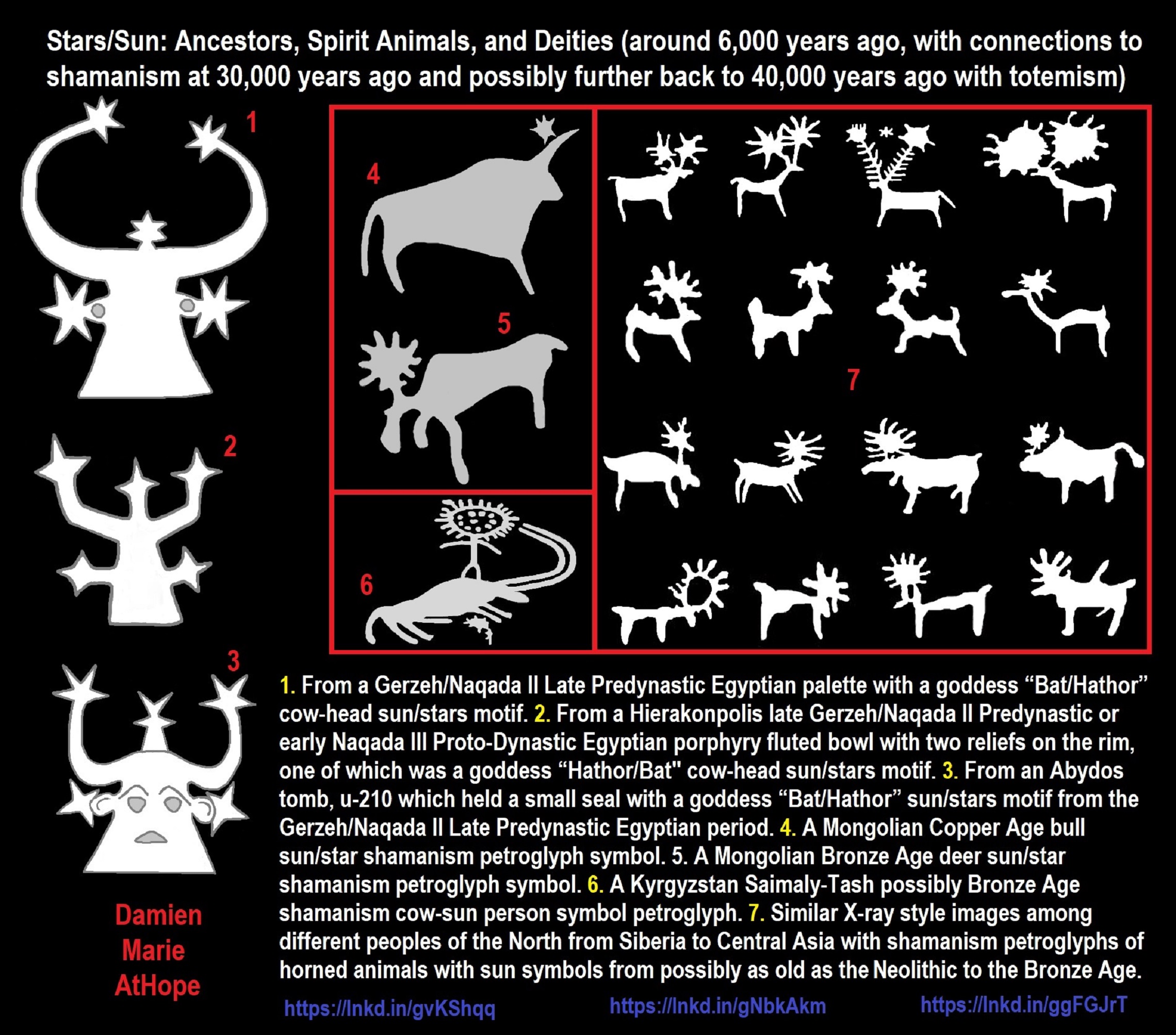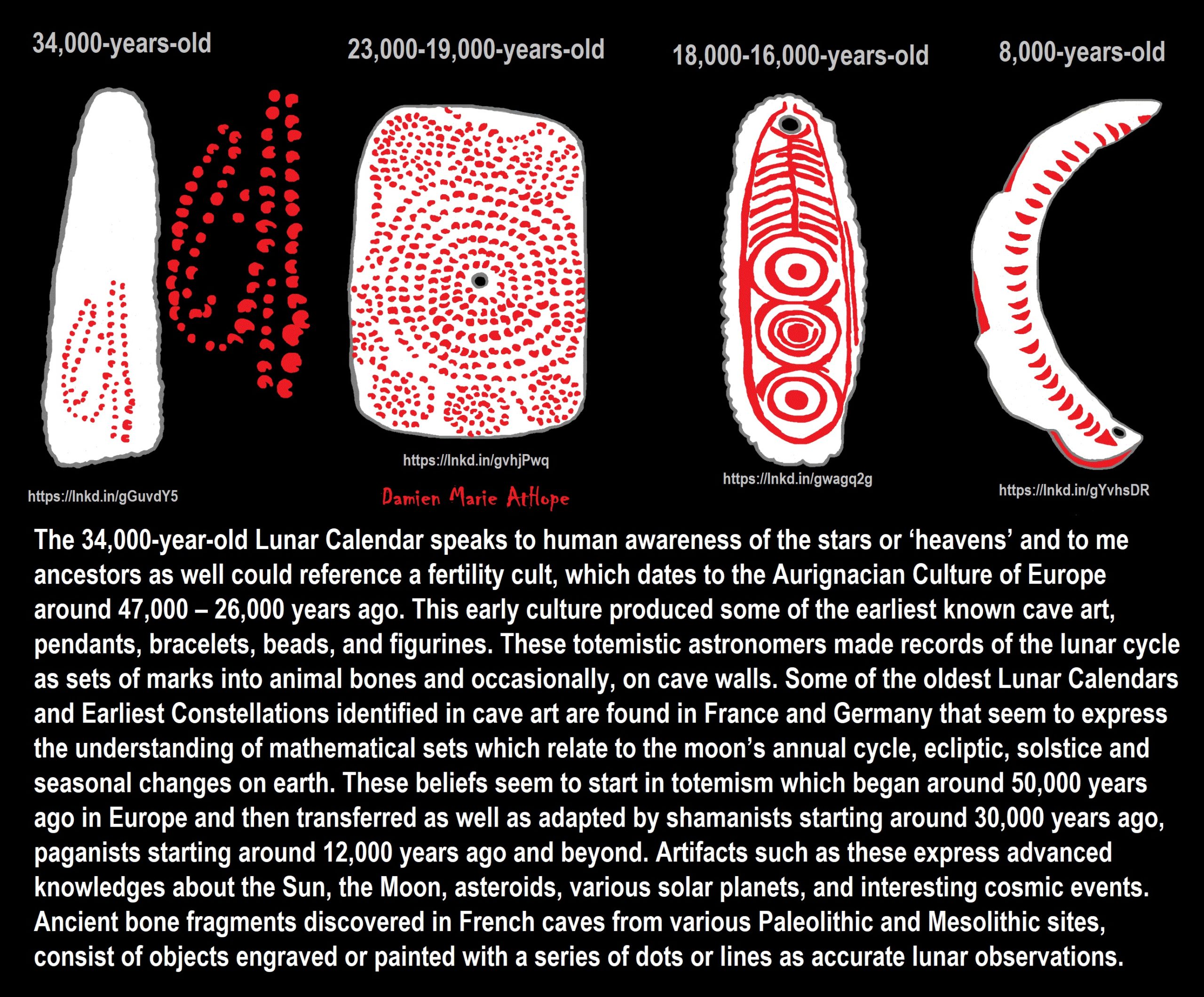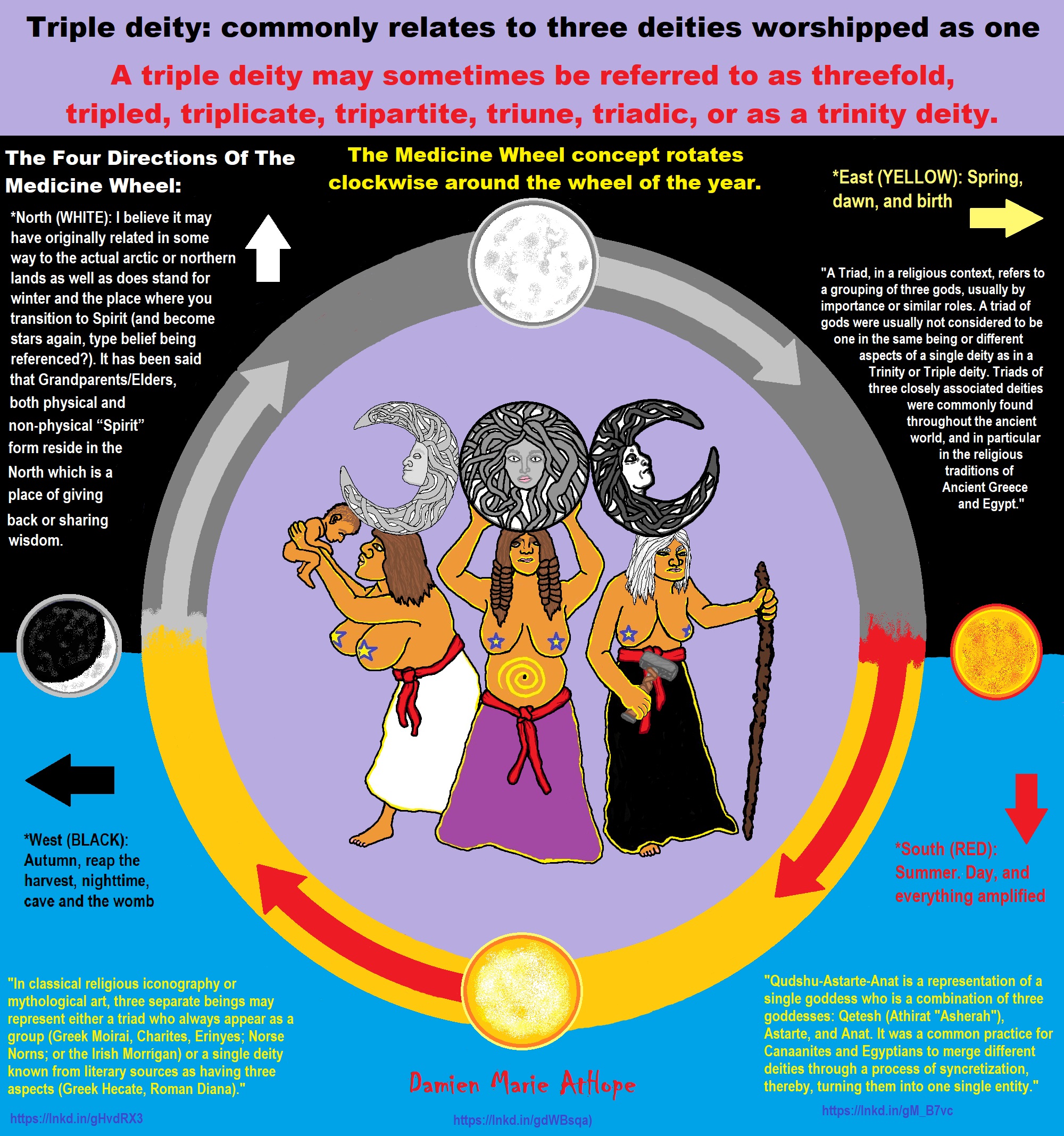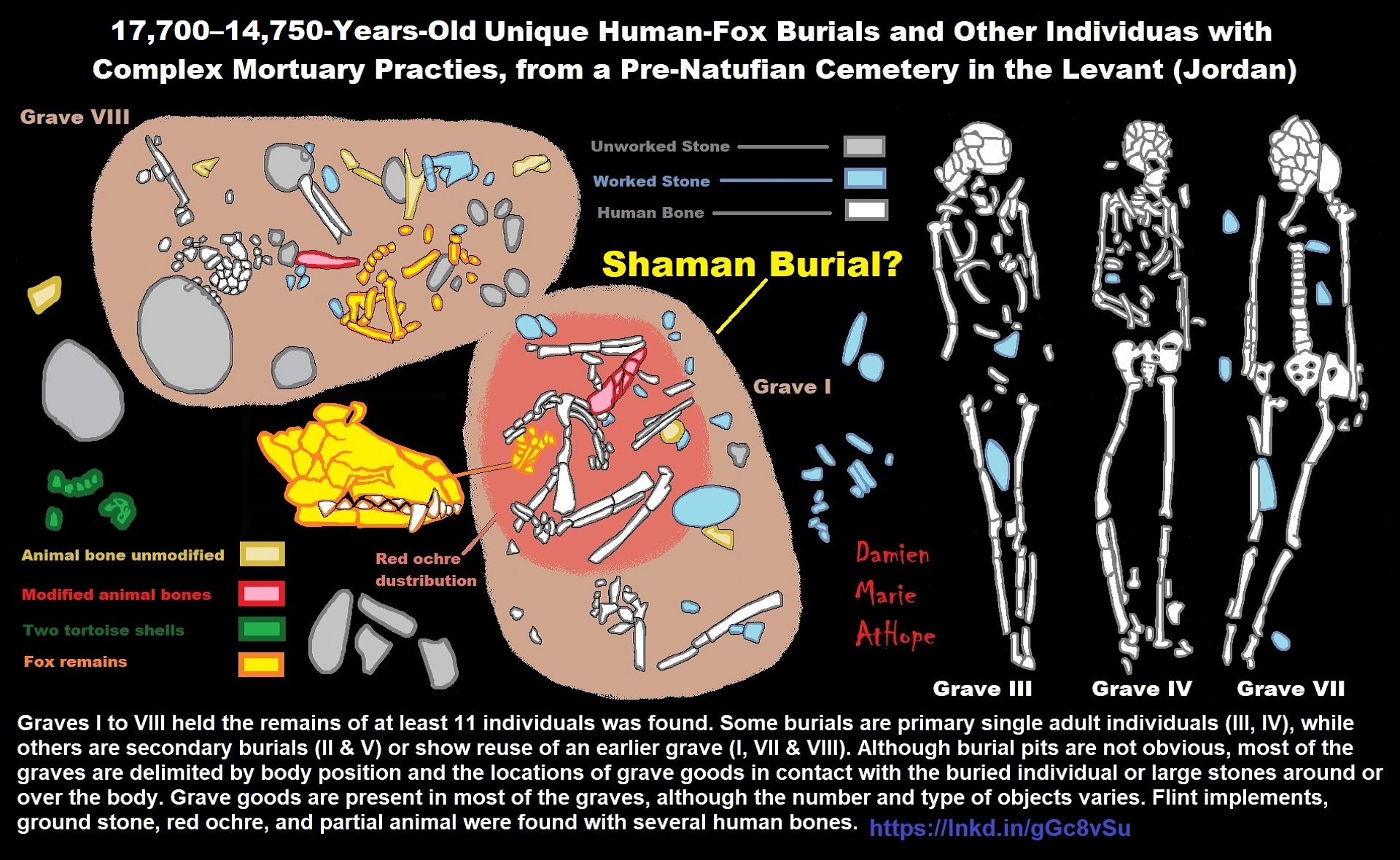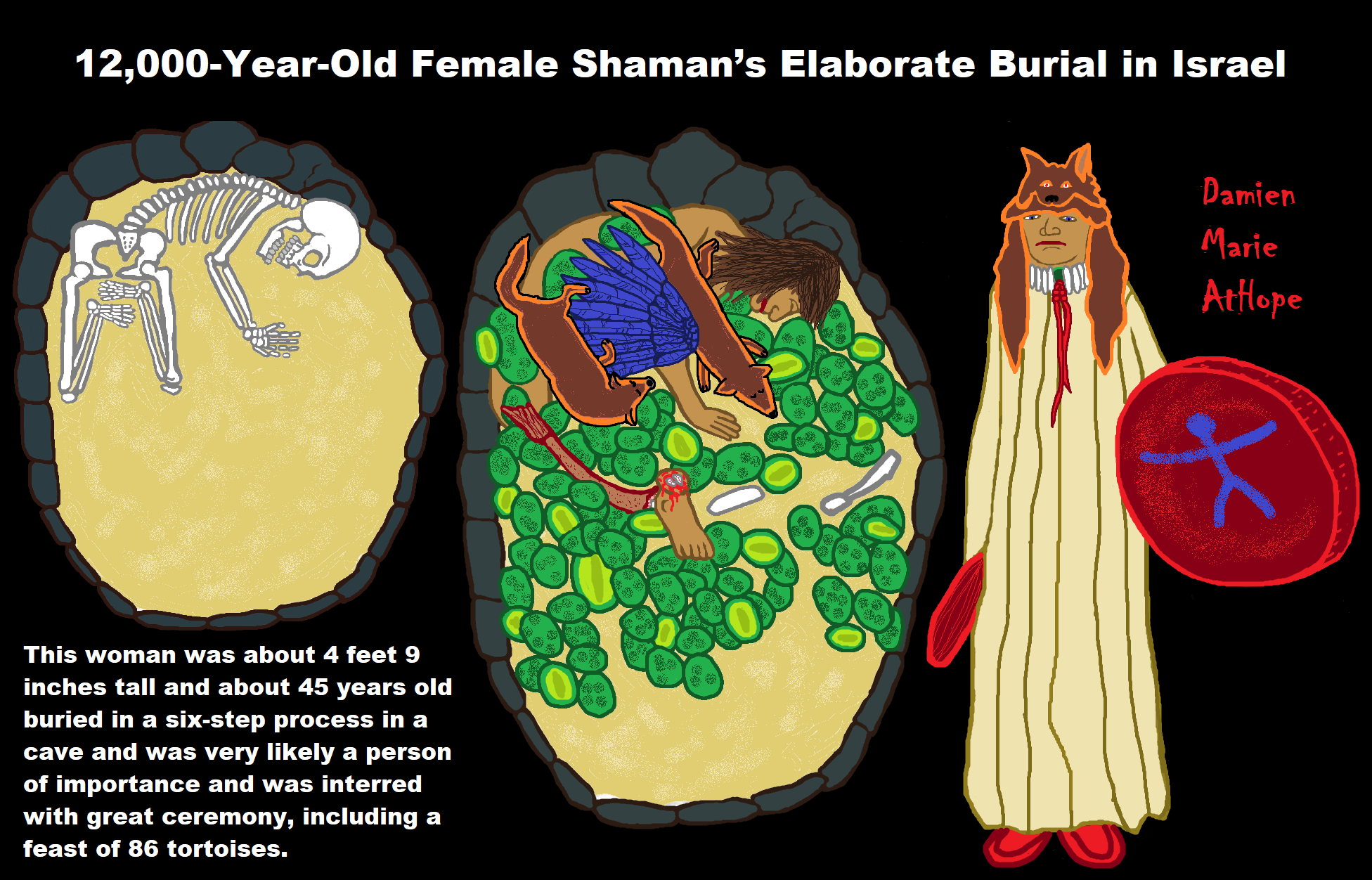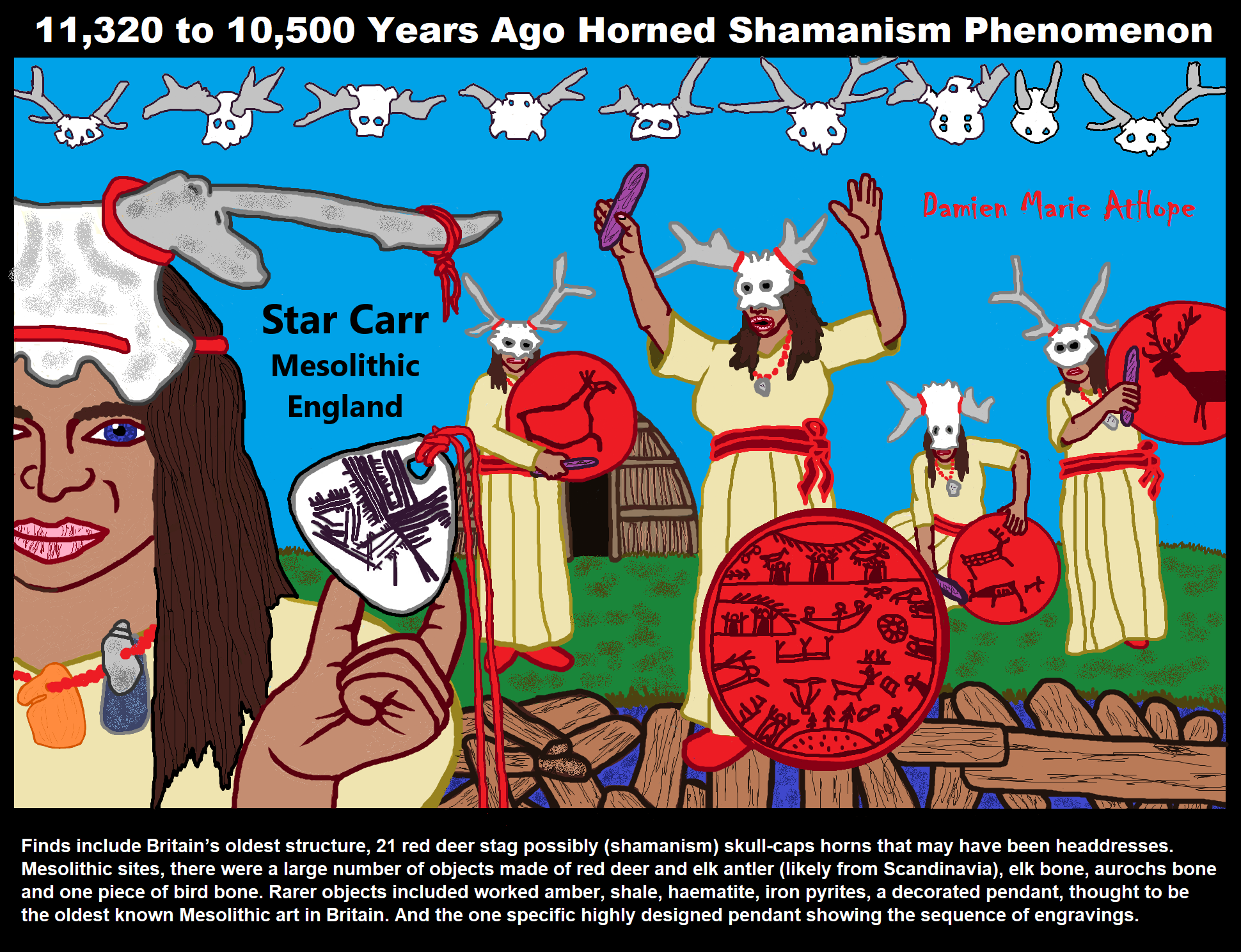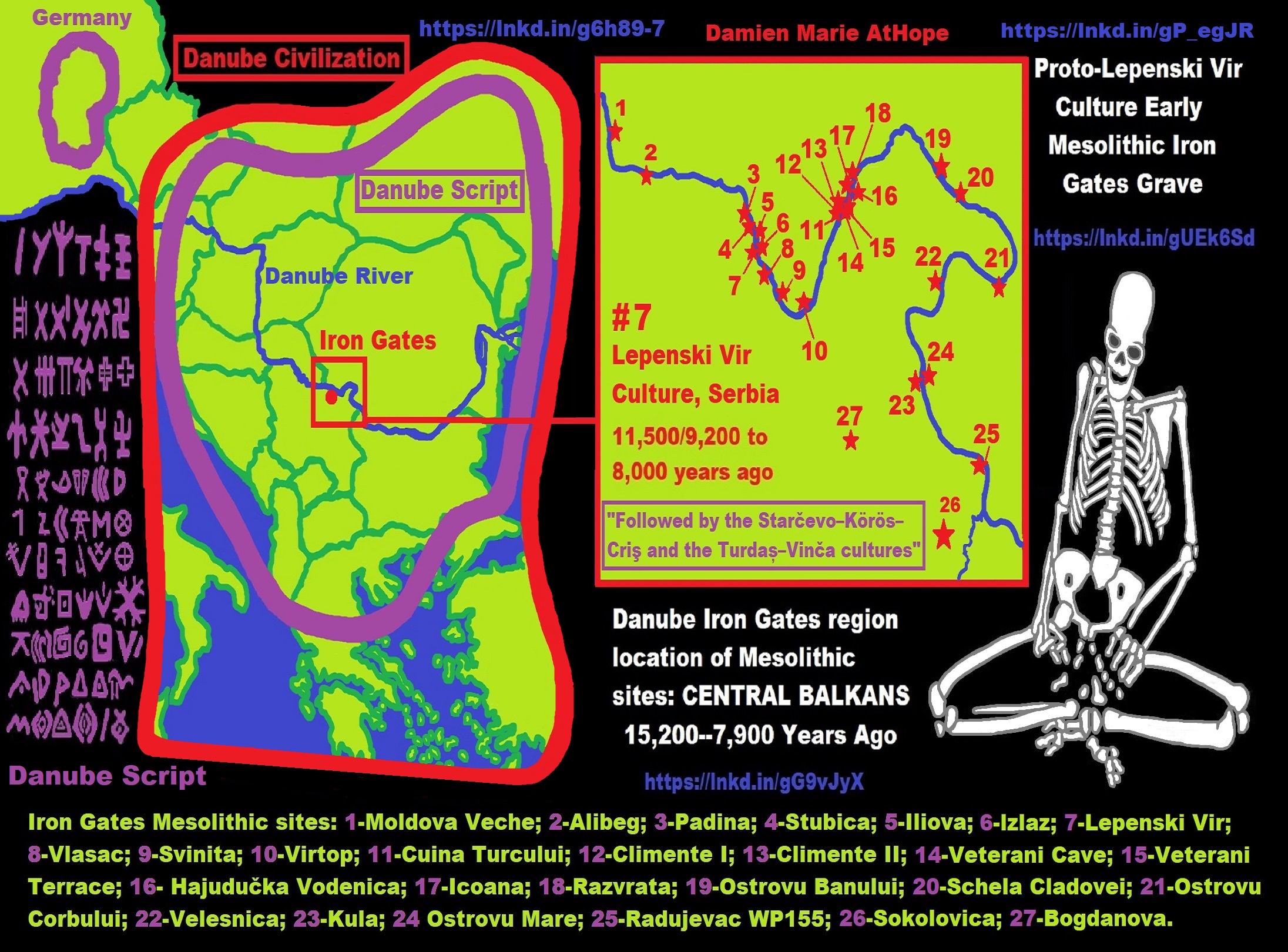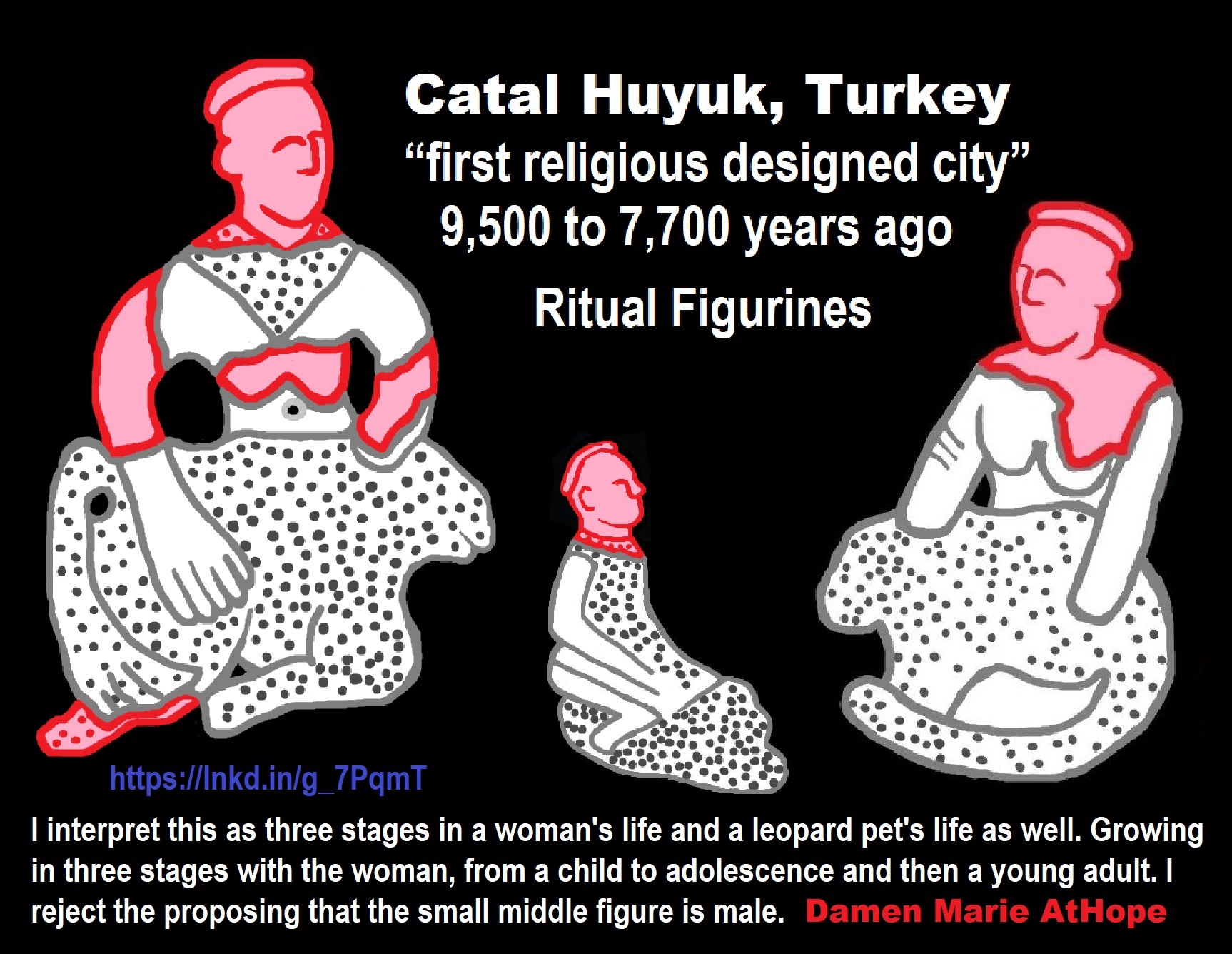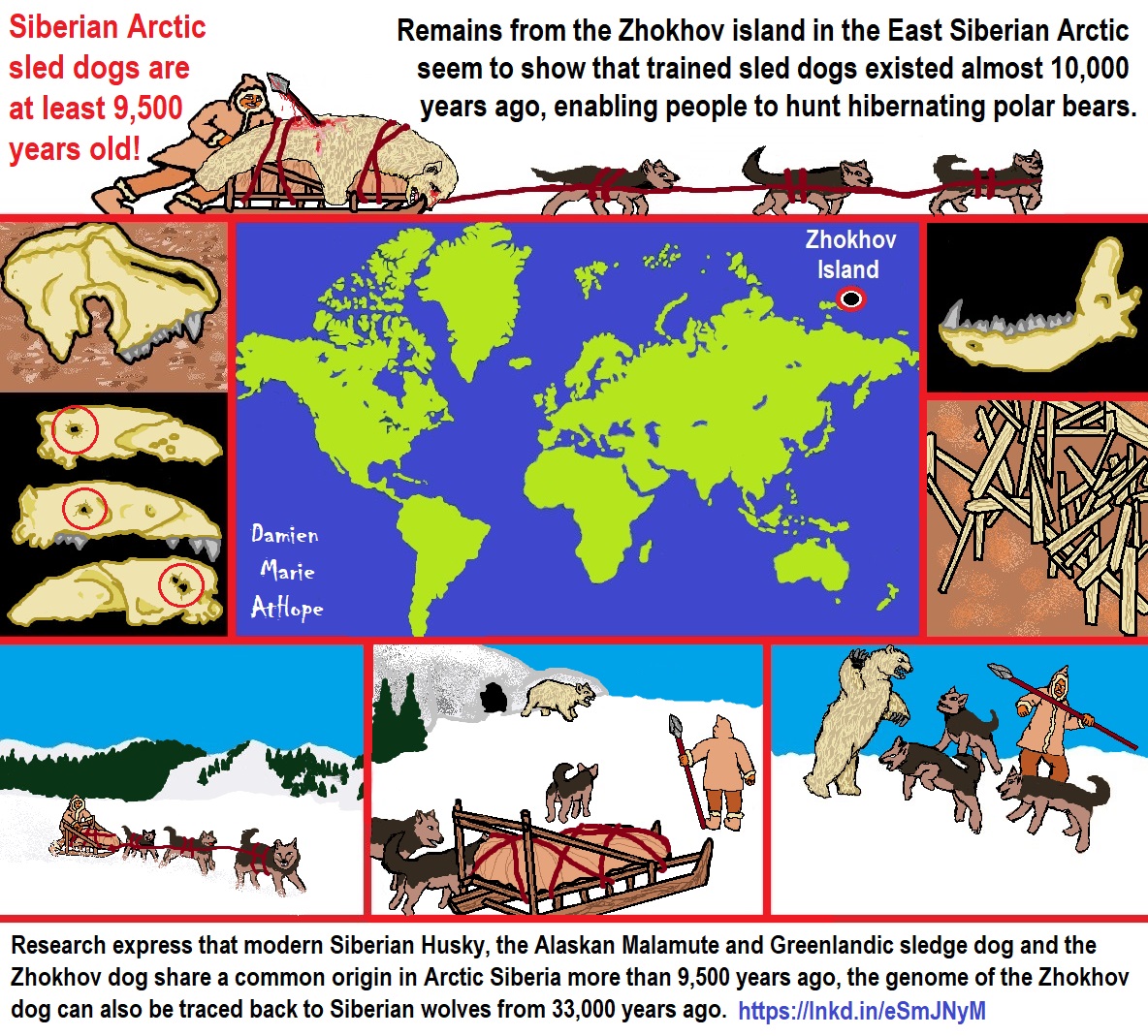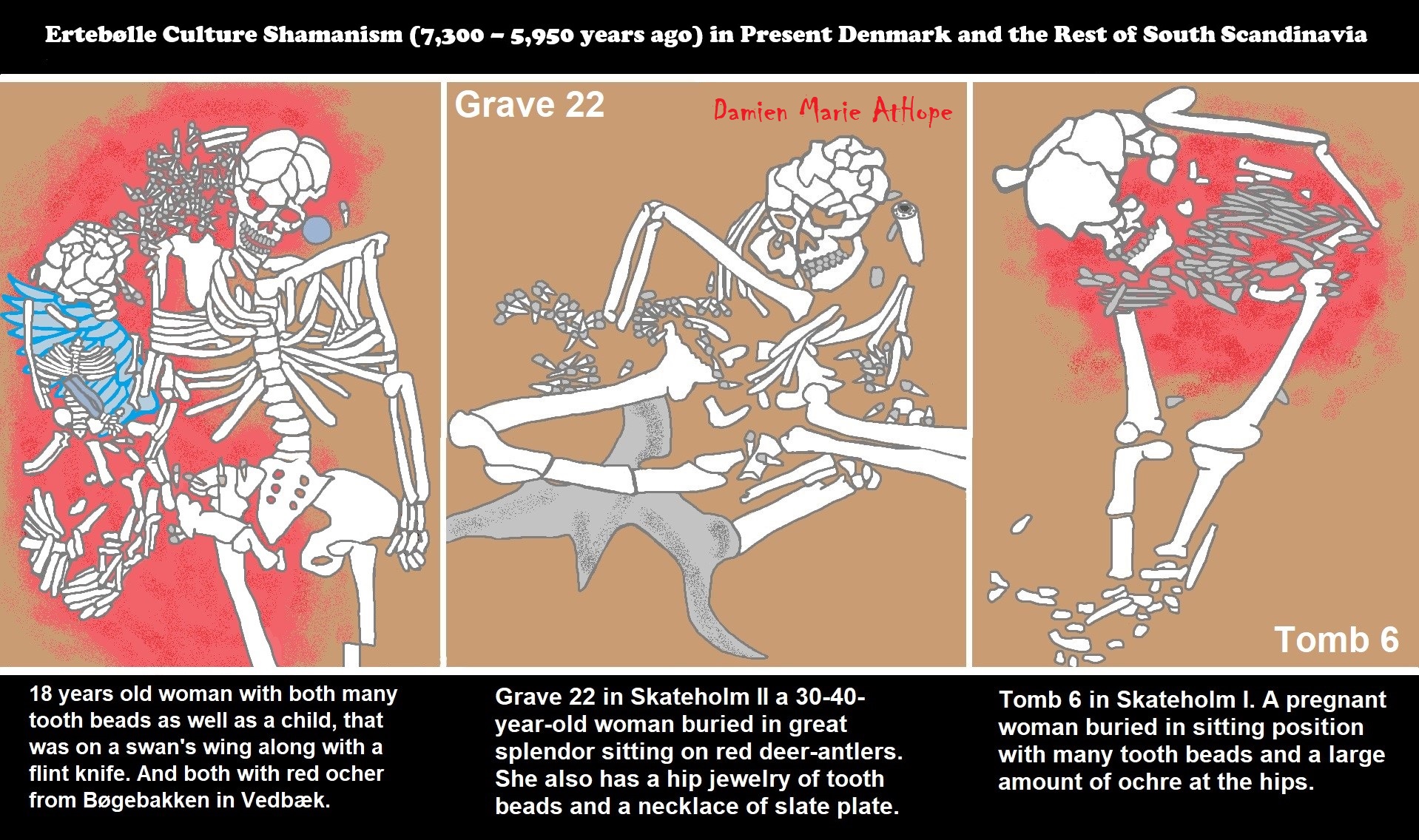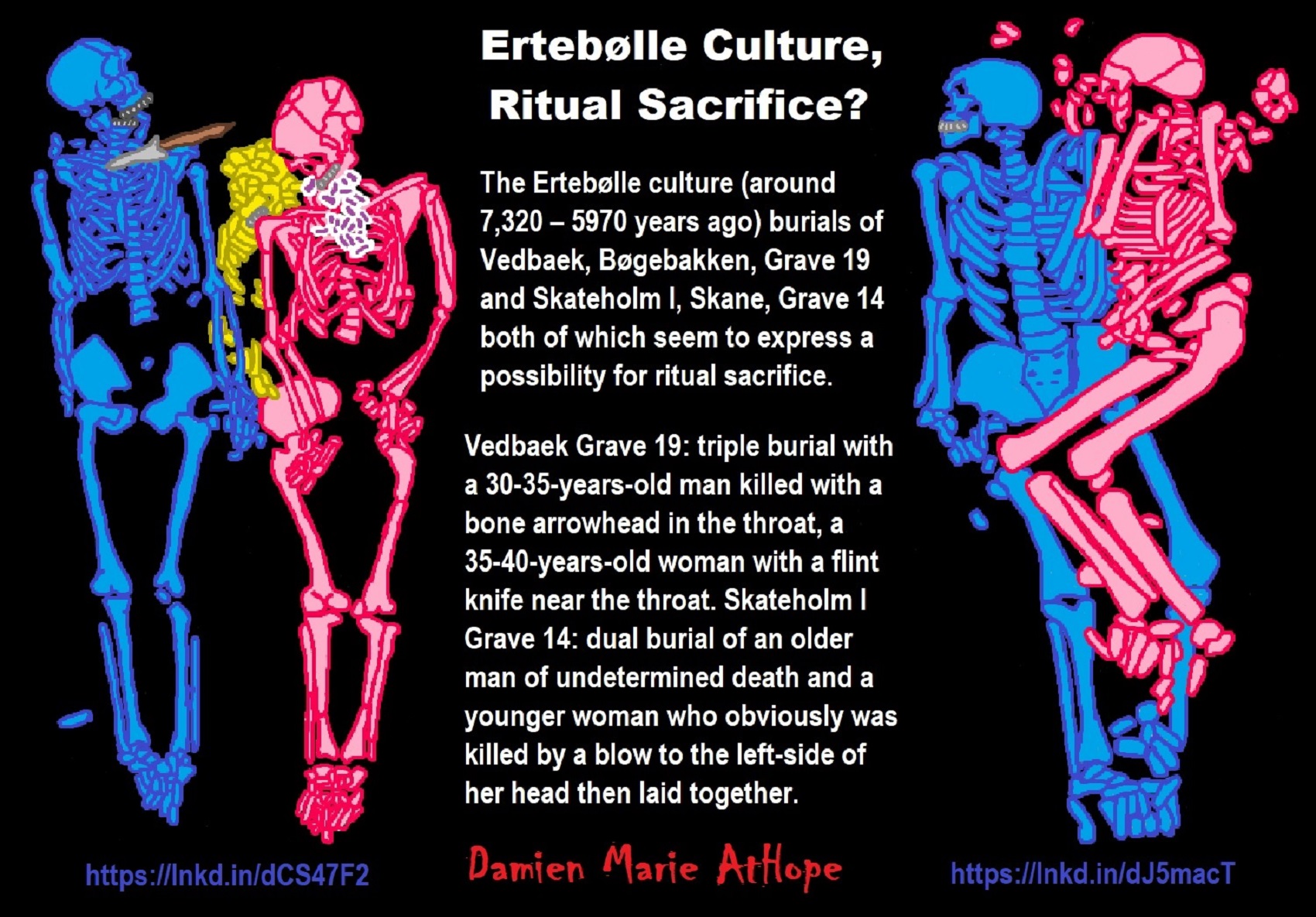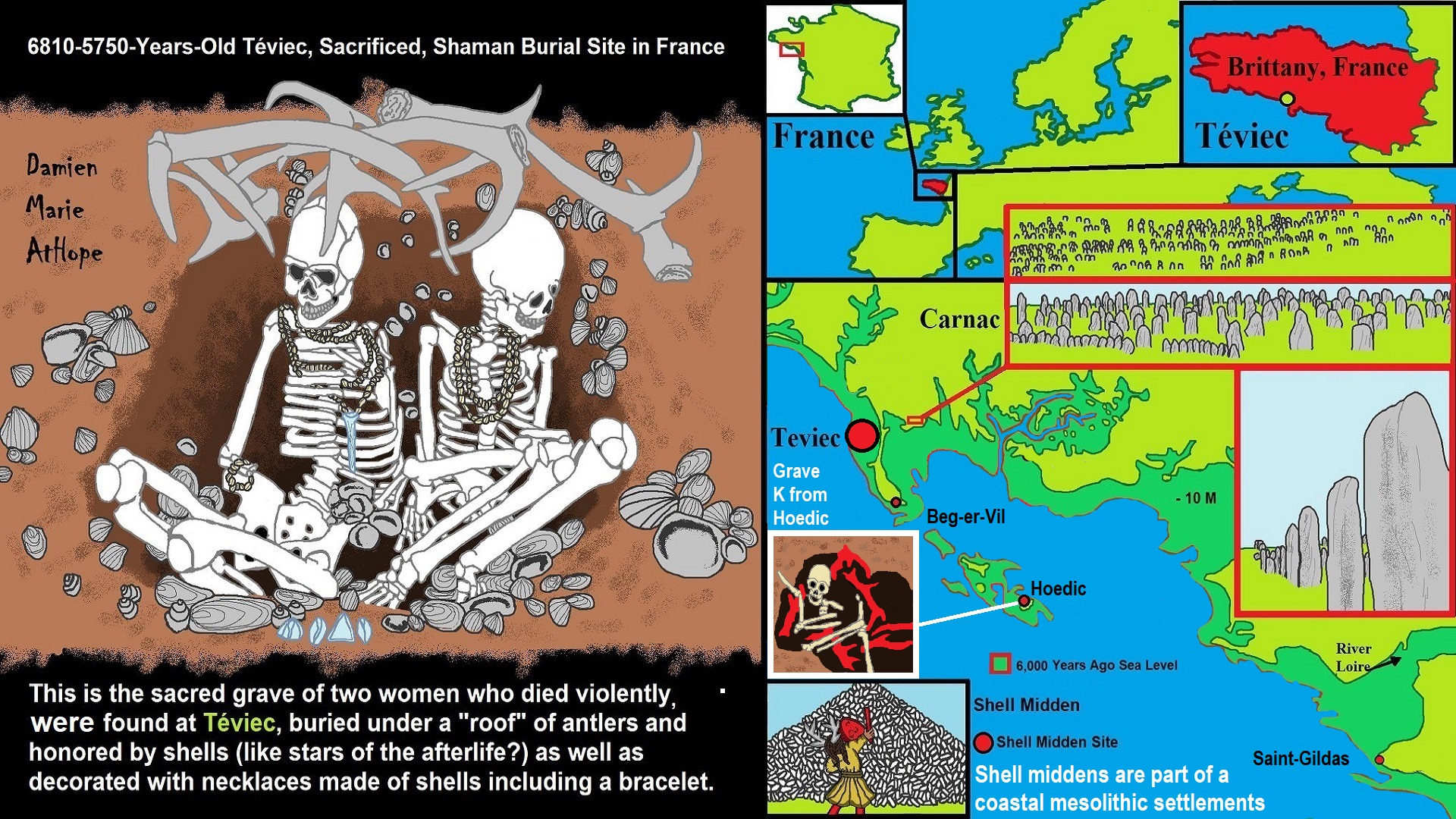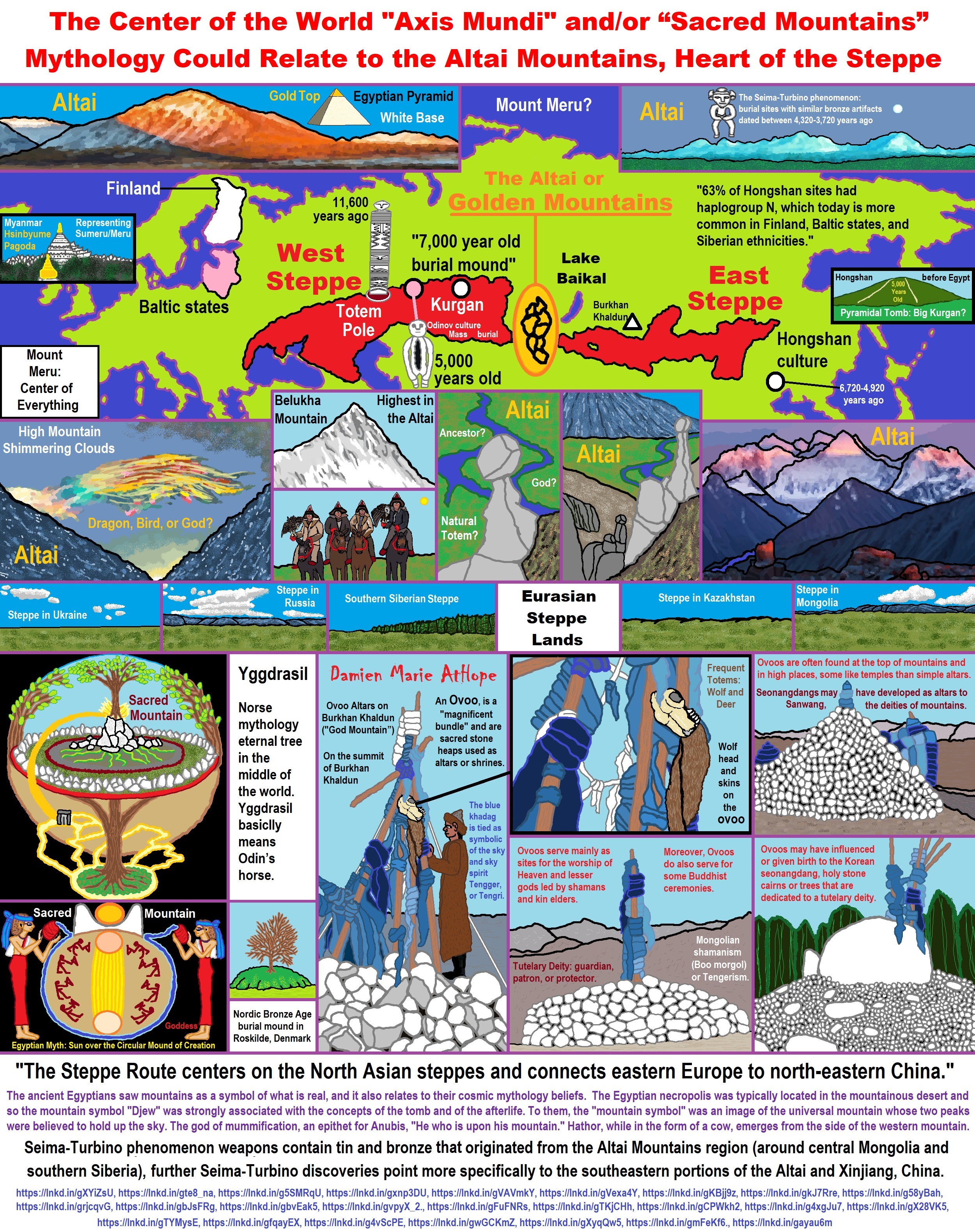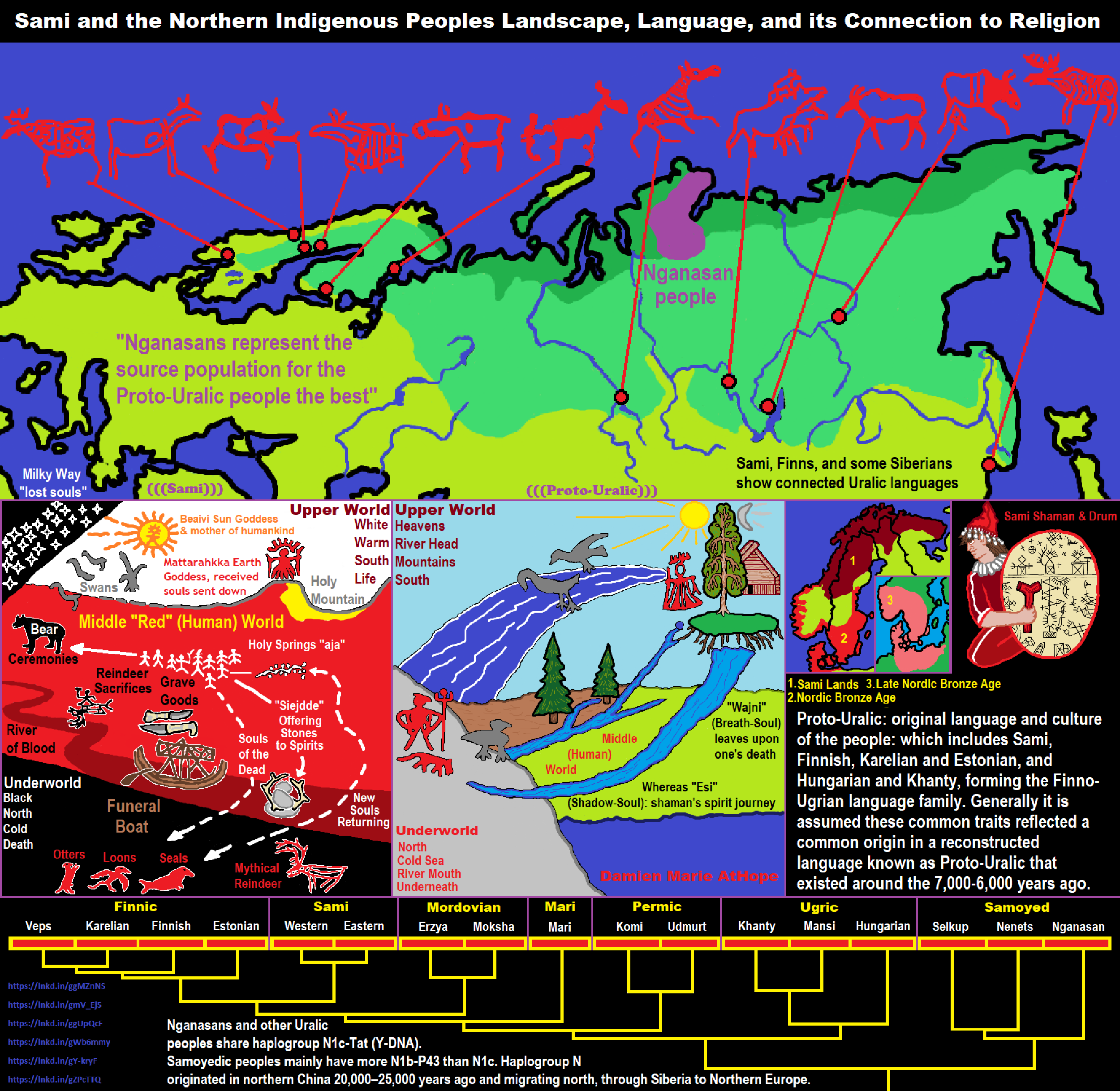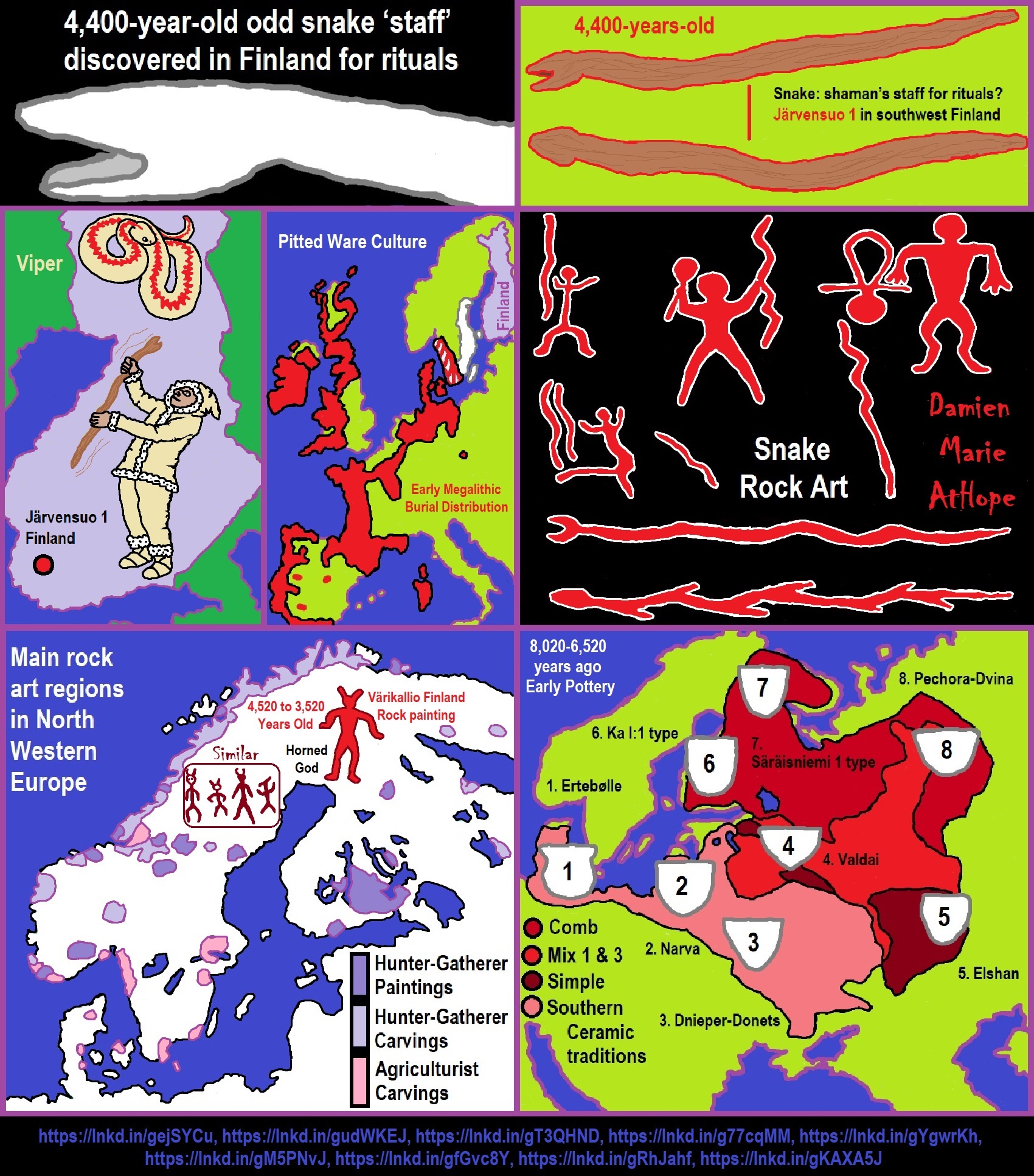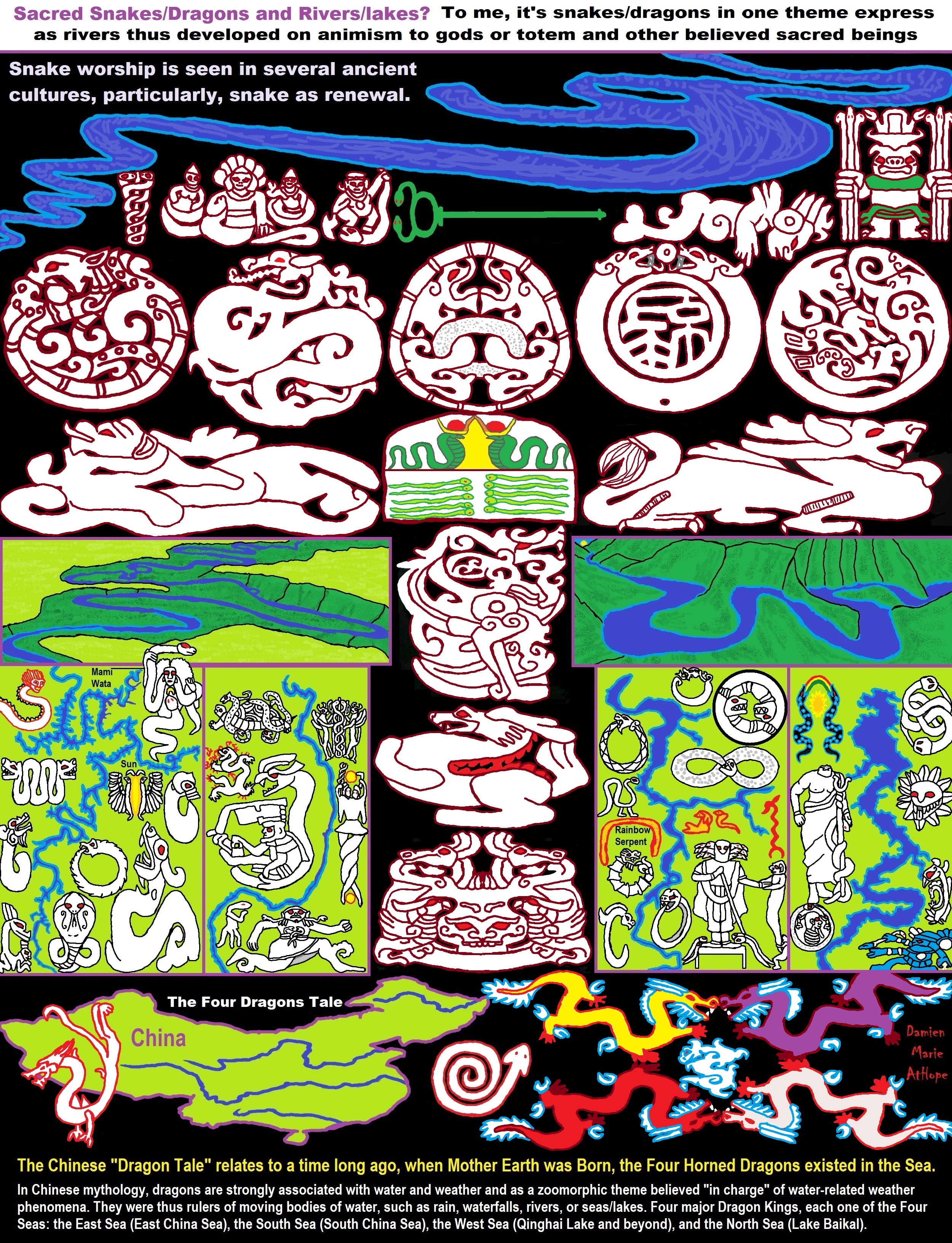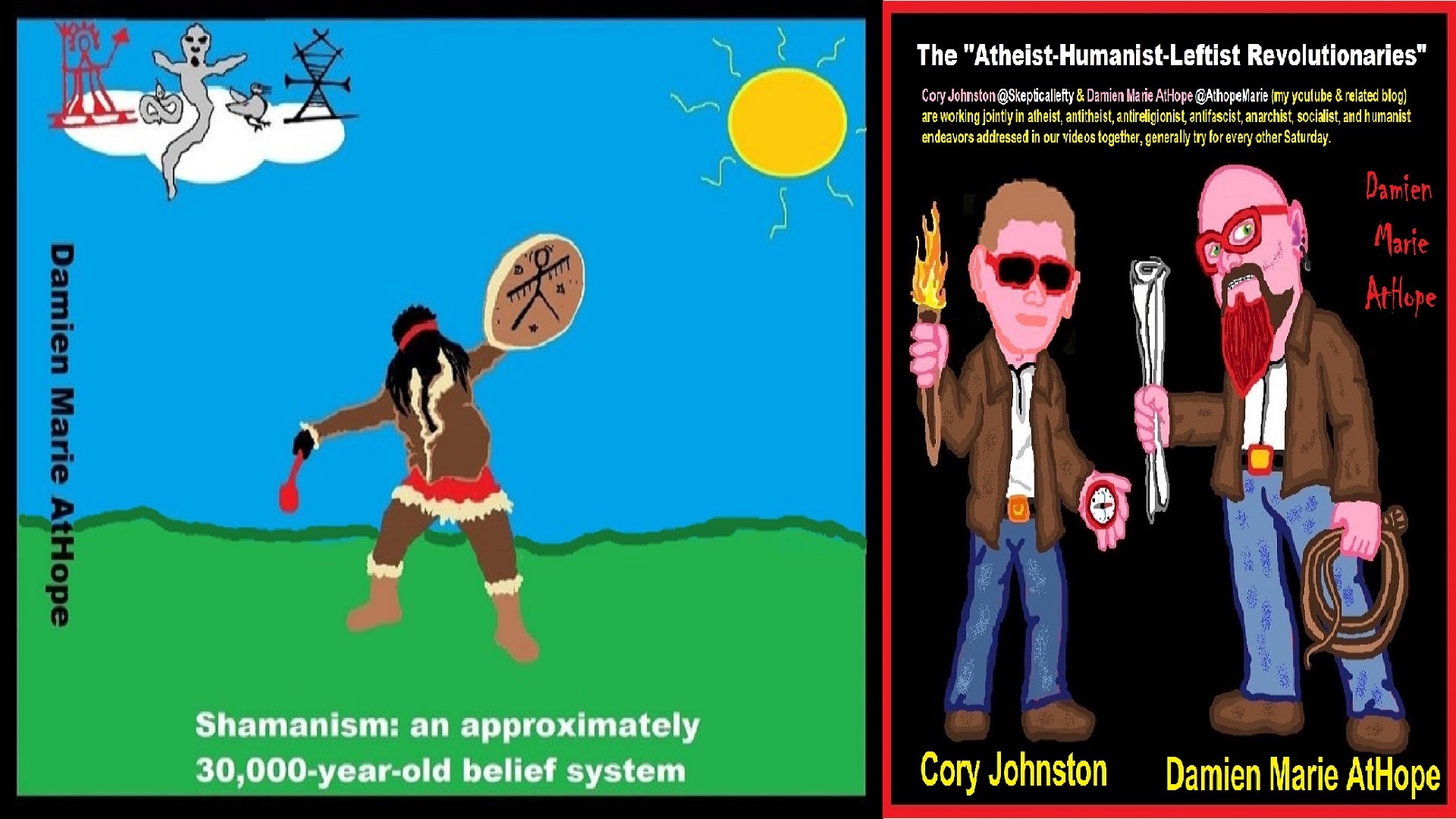
Understanding Religion Evolution per Damien’s speculations from the evidence:
Pre-Animism (at least 300,000 years ago) possibly Africa, Middle East, and Eurasia
Animism (at least 100,000 years ago) possibly Southern Africa or maybe Central Africa
Totemism (at least 50,000/45,000 years ago) possibly around Germany, France, or somewhere in West Europe
Shamanism (at least 30,000/35,000 years ago) possibly West Siberia or East Russia
Paganism (at least 12,000/13,000 years ago) Turkey And/or Levant: “Israel, Jordan, Lebanon, Palestine, Syria”
Progressed organized religion (at least 5,000 years ago), (Egypt, the First Dynasty 5,150 years ago)
I think animism started 100,000 years ago, totemism 50,000-45,000 years ago, and shamanism 30,000-35,000 years ago.
Animism (simplified to me as a belief in a perceived spirit world) passably by at least 100,000 years ago “the primal stage of early religion” To me, Animistic Somethingism: You just feel/think there has to be something supernatural/spirit-world or feel/think things are supernatural/spirit-filled.
Totemism (simplified to me, as a belief that these perceived spirits could be managed or related with by created physical expressions) passably by at least 50,000 years ago “progressed stage of early religion” A totem is a representational spirit being, a sacred object, or symbol of a group of people, clan, or tribe.
Shamanism (simplified to me as a belief that some special person can commune with these perceived spirits on the behalf of others by way of rituals) passably by at least 30,000 years ago Shamanism is an otherworld connection belief thought to heal the sick, communicate with spirits/deities, and escort souls of the dead.
- African Back Migrations and the Status of Shamanism Origins as well as its Spreading
- Women/Feminine-Natured people as the first Shamans from around 30,000 to 7,000 years ago?
- Venus of Willendorf: Shamanism Headdresses that Cover the Eyes?
- Some Paleolithic Batons from 23,000 to 12,000 years ago are/maybe Shaman Drumsticks like Those Used with Sami Shaman Drums?
“In Siberian shamanism, the horns on top of the shaman’s head are meant to guide the spirits from the clouds to inter the shaman and then they supposedly commune with the spirit world.” https://www.youtube.com/watch?v=j4zdIQqxzIU
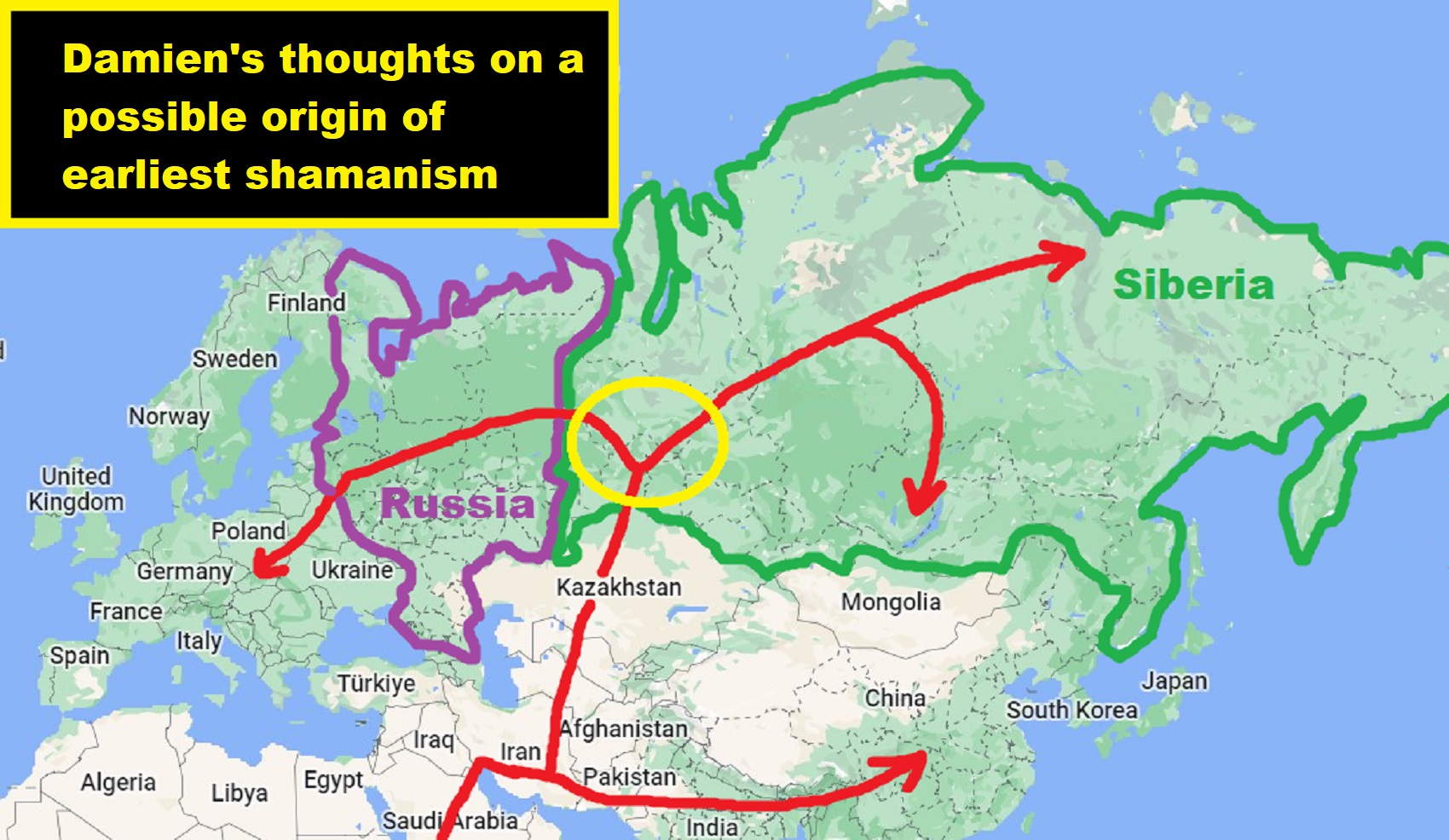
“Haplogroup U is a human mitochondrial DNA haplogroup (mtDNA). The clade arose from haplogroup R, likely during the early Upper Paleolithic. Its various subclades (labeled U1–U9, diverging over the course of the Upper Paleolithic) are found widely distributed across Northern and Eastern Europe, Central, Western, and South Asia, as well as North Africa, the Horn of Africa, and the Canary Islands. Basal U was found in the 26,000-year-old remains of Ancient North Eurasian, Mal’ta boy (MA1). The age of U5 is estimated at between 25,000 and 35,000 years old, roughly corresponding to the Gravettian culture. and is the DNA associated with the seeming first Gravettian shaman burial seen in the Pavlovian culture, around Dolní Věstonice in southern Moravia. One of the Dolní Věstonice burials, located near the huts, revealed a human female skeleton aged to 40+ years old, ritualistically placed beneath a pair of mammoth scapulae, one leaning against the other. Surprisingly, the left side of the skull was disfigured in the same manner as the aforementioned carved ivory figure, indicating that the figure was an intentional depiction of this specific individual. The bones and the earth surrounding the body contained traces of red ocher, a flint spearhead had been placed near the skull, and one hand held the body of a fox. This evidence suggests that this was the burial site of a shaman. This is the oldest site not only of ceramic figurines and artistic portraiture, but also of evidence of female shamans.” ref, ref, ref, ref
“Haplogroup U5 is one of the most ancient mtDNA lineages to have existed in Central Europe prior to its dispersal into Northern Europe. This haplogroup is thought to have evolved in the western steppe region and then entered Europe around 30,000 to 55,000 years ago. It appears to have expanded into Europe before the end of the Last Glacial Maximum (LGM) over 20 thousand years ago, i.e., before the thick ice sheets covering most of northern continental Europe were in the final stages of dissipating away from the interior.” ref
“Approximately 11% of Europeans (10% of European-Americans) have some variant of haplogroup U5. U5 was the predominant mtDNA of mesolithic Western Hunter Gatherers (WHG). U5 has been found in human remains dating from the Mesolithic in England, Germany, Lithuania, Poland, Portugal, Russia, Sweden, France, and Spain. Neolithic skeletons (~7,000 years old) that were excavated from the Avellaner cave in Catalonia, northeastern Spain included a specimen carrying haplogroup U5. Haplogroup U5 and its subclades U5a and U5b today form the highest population concentrations in the far north, among Sami, Finns, and Estonians. However, it is spread widely at lower levels throughout Europe. This distribution, and the age of the haplogroup, indicate individuals belonging to this clade were part of the initial expansion tracking the retreat of ice sheets from Europe around 10,000 years ago. The modern Basques and Cantabrians possess almost exclusively U5b lineages (U5b1f, U5b1c1, U5b2).” ref
6 Ice Age Humans (30,000 Years Ago)
“Abstract: Starting about 35,000 years ago, humans seem to have made a great leap forward culturally. The authors argue that this wasn’t because of genetic changes that caused the human brain to have increased capacity. It was because some groups culturally evolved the “social tools” that allowed them to maintain connections and share information over long distances. The groups with the most effective social tools managed to stay connected and to survive, and their descendants inherited this culture of connectedness. It’s likely that forming greater connectedness and more complex culture was necessary in order to survive the periods of high climate variability that were a feature of the last ice age.” ref
“Archaeologists usually describe two regional variants: the western Gravettian, known mainly from cave sites in France, Spain, and Britain, and the eastern Gravettian in Central Europe and Russia. The eastern Gravettians, which include the Pavlovian culture, were specialized mammoth hunters, whose remains are usually found not in caves but in open air sites. Gravettian culture thrived on their ability to hunt animals. They utilized a variety of tools and hunting strategies. Compared to theorized hunting techniques of Neanderthals and earlier human groups, Gravettian hunting culture appears much more mobile and complex. They lived in caves or semi-subterranean or rounded dwellings which were typically arranged in small “villages”. Gravettians are thought to have been innovative in the development of tools such as blunted-back knives, tanged arrowheads, and boomerangs. Other innovations include the use of woven nets and oil lamps made of stone. Blades and bladelets were used to make decorations and bone tools from animal remains.” ref
“Gravettian culture extends across a large geographic region, as far as Estremadura in Portugal. but is relatively homogeneous until about 27,000 years ago. They developed burial rites, which included simple, purpose-built offerings and/or personal ornaments owned by the deceased, placed within the grave or tomb. Surviving Gravettian art includes numerous cave paintings and small, portable Venus figurines made from clay or ivory, as well as jewelry objects. The fertility deities mostly date from the early period; there are over 100 known surviving examples. They conform to a very specific physical type, with large breasts, broad hips and prominent posteriors. The statuettes tend to lack facial details, and their limbs are often broken off. During the post glacial period, evidence of the culture begins to disappear from northern Europe but was continued in areas around the Mediterranean. The Mal’ta Culture (c. 24,000 years ago) in Siberia is often considered as belonging to the Gravettian, due to its similar characteristics, particularly its Venus figurines, but any hypothetical connection would have to be cultural and not genetic: a 2016 genomic study showed that the Mal’ta people have no genetic connections with the people of the European Gravettian culture (the Vestonice Cluster).” ref
“Fu et al. (2016) examined the remains of fourteen Gravettians. The eight males included three samples of Y-chromosomal haplogroup CT, one of I, one IJK, one BT, one C1a2, and one sample of F. Of the fourteen samples of mtDNA, there were thirteen samples of U and one sample of M. The majority of the sample of U belonged to the U5 and U2. Teschler et al. (2020) examined the remains of one adult male and two twin boys from a Gravettian site in Austria. All belonged to haplogroup Y-Haplogroup I. and all had the same mtDNA, U5. According to Scorrano et al. (2022), “the genome of an early European individual from Kostenki 14, dated to around 37,000 years ago, demonstrated that the ancestral European gene pool was already established by that time.” ref
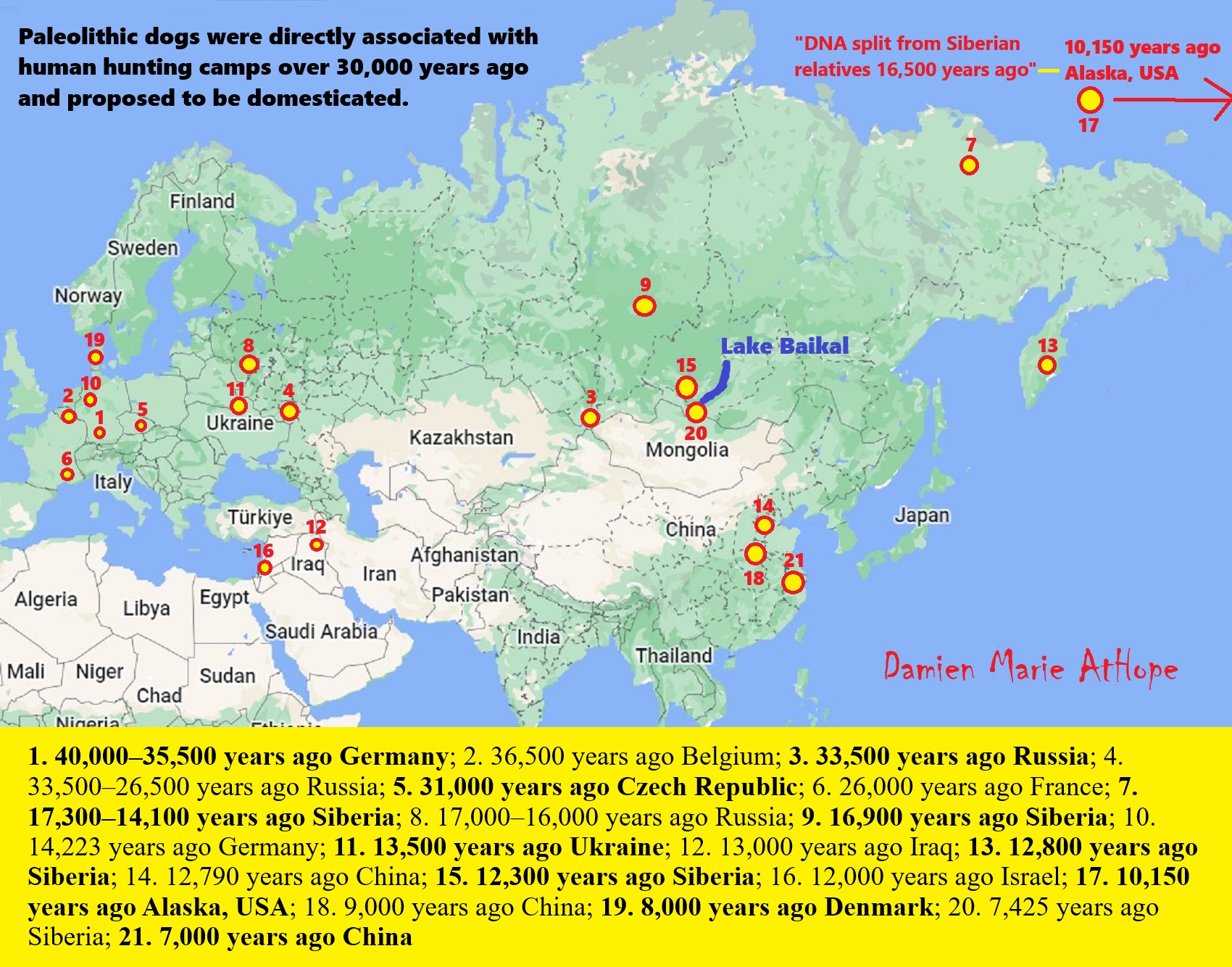
“The Paleolithic dog was a Late Pleistocene canine. They were directly associated with human hunting camps in Europe over 30,000 years ago and it is proposed that these were domesticated. They are further proposed to be either a proto-dog and the ancestor of the domestic dog or an extinct, morphologically and genetically divergent wolf population. There are a number of recently discovered specimens which are proposed as being Paleolithic dogs, however, their taxonomy is debated. These have been found in either Europe or Siberia and date 40,000–17,000 years ago. They include Hohle Fels in Germany, Goyet Caves in Belgium, Predmosti in the Czech Republic, and four sites in Russia: Razboinichya Cave in the Altai Republic, Kostyonki-8, Ulakhan Sular in the Sakha Republic, and Eliseevichi 1 on the Russian plain.” ref
- 40,000–35,500 years ago Hohle Fels, Schelklingen,Germany
2. 36,500 years ago Goyet Caves,Samson River Valley, Belgium
3. 33,500 years ago Razboinichya Cave, Altai Mountains, (Russia/Siberia)
4. 33,500–26,500 years ago Kostyonki-Borshchyovo archaeological complex, (Kostenki site) Voronezh, Russia
5. 31,000 years ago Predmostí, Moravia, Czech Republic
6. 26,000 years ago Chauvet Cave, Vallon-Pont-d’Arc, Ardèche region, France
7. 17,300–14,100 years ago Dyuktai Cave, northern Yakutia, Siberia
8. 17,000–16,000 years ago Eliseevichi-I site, Bryansk Region, Russian Plain, Russia
9. 16,900 years ago Afontova Gora-1, Yenisei River, southern Siberia
10. 14,223 years ago Bonn–Oberkassel, Germany
11. 13,500 years ago Mezine, Chernigov region, Ukraine
12. 13,000 years ago Palegawra, (Zarzian culture) Iraq
13. 12,800 years ago Ushki I, Kamchatka, eastern Siberia
14. 12,790 years ago Nanzhuangtou, China
15. 12,300 years ago Ust’-Khaita site, Baikal region, Siberia
16. 12,000 years ago Ain Mallaha (Eynan) and HaYonim terrace, Israel
17. 10,150 years ago Lawyer’s Cave, Alaska, USA
18. 9,000 years ago Jiahu site, China
19. 8,000 years ago Svaerdborg site, Denmark
20. 7,425 years ago Lake Baikal region, Siberia
21. 7,000 years ago Tianluoshan archaeological site, Zhejiang province, China ref
Origins of the Domestic Dog
“In 2013, a major Mitochondrial DNA study has found that divergence times from wolf to dog implies a European origin of the domestic dog dating 18,800-32,100 years ago, which supports the hypothesis that dog domestication preceded the emergence of agriculture and occurred in the context of European hunter-gatherer cultures. In 2009, a study proposed that there was a low frequency of recognized dog skulls in Upper Paleolithic sites because existing specimens had not yet been recognized as dogs. The study looked at the 2 Eliseevichi-1 dog skulls in comparison to much earlier Late Pleistocene but morphologically similar fossil skulls that had been found across Europe, and proposed the much earlier specimens were Paleolithic dogs that were morphologically and genetically distinct from the Pleistocene wolves living in Europe at that time. The study looked at 117 skulls of recent and fossil large canids. Several skulls of fossil large canids from sites in Belgium, Ukraine and Russia were examined using multivariate analysis to look for evidence of the presence of Paleolithic dogs that were separate from Pleistocene wolves. Reference groups included the Eliseevichi-1 prehistoric dogs, recent dogs and wolves.” ref
“The osteometric analysis of the skulls indicated that the Paleolithic dogs fell outside the skull ranges of the Pleistocene wolf group and the modern wolf group, and were closer related to those of the Eliseevichi-1 prehistoric dog group. The fossil large canid from Goyet, Belgium dated at 36,000 years ago was clearly different from the recent wolves, resembling most closely the Eliseevichi-1 prehistoric dogs and suggesting that dog domestication had already started during the Aurignacian. The two Epigravettian Mezine, Ukraine and Mezhirich, Ukraine skulls were also identified as being Paleolithic dogs. Collagen analysis indicated that the Paleolithic dogs associated with human hunter-gatherer camp-sites (Eliseevichi-1, Mezine, and Mezhirich) had been specifically eating reindeer, while other predator species in those locations and times had eaten a range of prey. Further studies later looked at wolf-like fossils from Paleolithic hunter-gatherer sites across Europe and proposed to have identified Paleolithic dogs at Predmosti (Czech Republic 26,000-27,000 years ago), Kostenki-8 (Russia 23,000-27,700 years ago), Kostenki-1 (Russia 22,000-24,000 years ago), Kostenki-17 (Russia Upper Paleolithic) and Verholenskaya (Russia late glacial).” ref
“In the human burial zone at the Predmosti site, 3 Paleolithic skulls were found that resemble those of a Siberian husky but they were larger and heavier than the modern husky. For one skull, “a large bone fragment is present between the upper and lower incisors that extends several centimetres into the mouth cavity. The size, thickness and shape of the fragment suggest that it could be a fragment of a bone of a large mammal, probably from a mammoth. The position of the bone fragment in the mouth and the articulated state of the lower jaw with the skull indicate that this mammoth bone fragment was inserted artificially into the mouth of the dog post-mortem.” The morphology of some wolf-like fossils was such that they could not be assigned to either the Pleistocene wolf nor Paleolithic dog groups. It has been proposed that based on the genetic evidence of modern dogs being traced to the ancient wolves of Europe, the archaeological evidence of the Paleolithic dog remains being found at known European hunting camp-sites, their morphology, and collagen analysis that indicated that their diet had been artificially restricted compared to nearby wolves, that the Paleolithic dog was domesticated.” ref
“It has also been hypothesized that the Paleolithic dog may have provided the stock from which early dogs arose, or alternatively that they are a type of wolf that is not known to science. In 2016, a study discounted the use of the Paleolithic dogs from the Predmosti site as pack animals. There has been ongoing debate in the scientific press about what the fossil remains of the Paleolithic dog might be, with some commenters declaring them as either wolves or a unique form of wolf. These include a first article proposing the Paleolithic dog, its refutation, a counter to the refutation, a second article, its refutation, a third article that includes a counter to the refutation, its refutation, a counter to the refutation, another refutation, support given based on bone collagen analysis, and the identification of an ancient paleolithic dog in Yakutia. Studies have suggested that it was possible for multiple primitive forms of the dog to have existed, including in Europe.” ref
“European dog populations had undergone extensive turnover during the last 15,000 years that has erased the genomic signature of early European dogs, the genetic heritage of the modern breeds has become blurred due to admixture, and there was the possibility of past domestication events that had died out or had been largely replaced by more modern dog populations. In 2016, a study proposed that dogs may have been domesticated separately in both Eastern and Western Eurasia from two genetically distinct and now extinct wolf populations. East Eurasian dogs then made their way with migrating people to Western Europe between 14,000 and 6,400 years ago where they partially replaced the dogs of Europe. Two domestication events in Western Eurasia and Eastern Eurasia has recently been found for the domestic pig. As the taxonomic classification of the “proto-dog” Paleolithic dogs as being either dogs or wolves remains controversial, they were excluded from the study.” ref
“In 2009, a study looked at 117 skulls of recent and fossil large canids. None of the 10 canid skulls from the Belgian caves of Goyet, Trou du Frontel, Trou de Nutons, and Trou de Chaleux could be classified, so the team took as their basic assumption that all of these canid samples were wolves. The DNA sequence of seven of the skulls indicated seven unique haplotypes that represented ancient wolf lineages lost until now. The osteometric analysis of the skulls showed that one large canid fossil from Goyet was clearly different from recent wolves, resembling most closely the Eliseevichi-1 dogs (15,000 years ago) and so was identified as a Paleolithic dog. The analysis indicated that the Belgian fossil large canids in general preyed on horse and large bovids.” ref
“In November 2013, a DNA study sequenced three haplotypes from the ancient Belgium canids (the Goyet dog – Belgium 36,000 years ago cataloged as Canis species Genbank accession number KF661079, and with Belgium 30,000 years ago KF661080 and 26,000 years years ago KF661078 cataloged as Canis lupus) and found they formed the most diverging group. Although the cranial morphology of the Goyet dog has been interpreted as dog-like, its mitochondrial DNA relation to other canids places it as an ancient sister-group to all modern dogs and wolves rather than a direct ancestor. However, in 2015 three-dimensional geometric morphometric analyses indicated this, and the Eliseevichi-1 dog, is more likely from a wolf. Belgium 26,000 years ago has been found to be uniquely large but was found not to be related to the Beringian wolf. This Belgium canid clade may represent a phenotypically distinct and not previously recognized population of grey wolf, or the Goyet dog may represent an aborted domestication episode. If so, there may have been originally more than one ancient domestication event for dogs as there was for domestic pigs. A 2016 review proposed that it most likely represents an extinct morphologically and genetically divergent wolf population.” ref
“In 2011, a study looked at the well-preserved 33,000-year-old skull and left mandible of a dog-like canid that was excavated from Razboinichya Cave in the Altai Mountains of southern Siberia (Central Asia). The morphology was compared to the skulls and mandibles of large Pleistocene wolves from Predmosti, Czech Republic, dated 31,000 years ago, modern wolves from Europe and North America, and prehistoric Greenland dogs from the Thule period (1,000 years ago or later) to represent large-sized but unimproved fully domestic dogs. “The Razboinichya Cave cranium is virtually identical in size and shape to prehistoric Greenland dogs” and not the ancient nor modern wolves. However, the lower carnassial tooth fell within the lower range of values for prehistoric wolves and was only slightly smaller than modern European wolves, and the upper carnassial tooth fell within the range of modern wolves. “We conclude, therefore, that this specimen may represent a dog in the very early stages of domestication, i.e. an incipient dog, rather than an aberrant wolf… The Razboinichya Cave specimen appears to be an incipient dog…and probably represents wolf domestication disrupted by the climatic and cultural changes associated with the Last Glacial Maximum.” ref
“In 2007, a mtDNA analysis of extinct eastern Beringian wolves showed that two ancient wolves from Ukraine dated 30,000 years ago and 28,000 years ago and the 33,000 years ago Altai dog had the same sequence as six Beringian wolves, indicating a common maternal ancestor. In 2013, a DNA study of the Altai dog deposited the sequence in GenBank with a classification of Canis lupus familiaris (dog). “The analyses revealed that the unique haplotype of the Altai dog is more closely related to modern dogs and prehistoric New World canids than it is to contemporary wolves… This preliminary analysis affirms the conclusion that the Altai specimen is likely an ancient dog with shallow divergence from ancient wolves. These results suggest a more ancient history of the dog outside of the Middle East or East Asia.” The haplotype groups closest to the Altai dog included such diverse breeds as the Tibetan mastiff, Newfoundland, Chinese crested, cocker spaniel, and Siberian husky.” ref
“In November 2013, a study looked at 18 fossil canids and compared these with the complete mitochondrial genome sequences from 49 modern wolves and 77 modern dogs. A more comprehensive analysis of the complete mDNA found that the phylogenetic position of the Altai dog as being either dog or wolf was inconclusive and cataloged its sequence as Canis species GenBank accession number JX173682. Of four tests, 2 tests showed its sequence to fall within the wolf clade, and 2 tests within the dog clade. The sequence strongly suggests a position at the root of a clade uniting two ancient wolf genomes, two modern wolves, as well as two dogs of Scandinavian origin. However, the study does not support its recent common ancestry with the great majority of modern dogs. The study suggests that it may represent an aborted domestication episode. If so, there may have been originally more than one ancient domestication event for dogs as there was for domestic pigs. In 2017, two prominent evolutionary biologists reviewed all of the evidence available on dog divergence and supported the specimens from the Altai mountains as being those of dogs from a lineage that is now extinct and that was derived from a population of small wolves that is also now extinct.” ref
- 40,000–35,500 years ago Hohle Fels, Schelklingen, Germany
“Canid maxillary fragment. The size of the molars matches those of a wolf, the morphology matches a dog. Proposed as a Paleolithic dog. The figurine Venus of Hohle Fels was discovered in this cave and dated to this time.” ref
- 36,500 years ago Goyet Caves, Samson River Valley, Belgium
“The “Goyet dog” is proposed as being a Paleolithic dog. The Goyet skull is very similar in shape to that of the Eliseevichi-I dog skulls (16,900 years ago) and to the Epigravettian Mezin 5490 and Mezhirich dog skulls (13,500 years ago), which are about 18,000 years younger. The dog-like skull was found in a side gallery of the cave, and Palaeolithic artifacts in this system of caves date from the Mousterian, Aurignacian, Gravettian, and Magdalenian, which indicates recurrent occupations of the cave from the Pleniglacial until the Late Glacial. The Goyet dog left no descendants, and its genetic classification is inconclusive because its mitochondrial DNA (mDNA) does not match any living wolf nor dog. It may represent an aborted domestication event or phenotypically and genetically distinct wolves. A genome-wide study of a 35,000-year-old Pleistocene wolf fossil from northern Siberia indicates that the dog and the modern grey wolf genetically diverged from a common ancestor between 27,000 and 40,000 years ago.” ref
- 33,500 years ago Razboinichya Cave, Altai Mountains, (Russia/Siberia)
“The “Altai dog” is proposed as being a Paleolithic dog. The specimens discovered were a dog-like skull, mandibles (both sides), and teeth. The morphological classification, and an initial mDNA analysis, found it to be a dog. A later study of its mDNA was inconclusive, with 2 analyses indicating dog and another 2 indicating wolf. In 2017, two prominent evolutionary biologists reviewed the evidence and supported the Altai dog as being a dog from a lineage that is now extinct and that was derived from a population of small wolves that are also now extinct.” ref
- 33,500–26,500 years ago Kostyonki-Borshchyovo archaeological complex, (Kostenki site) Voronezh, Russia
“One left mandible paired with the right maxilla, proposed as a Paleolithic dog.” ref
- 31,000 years ago Predmostí, Moravia, Czech Republic
“Three dog-like skulls proposed as being Paleolithic dogs. Predmostí is a Gravettian site. The skulls were found in the human burial zone and identified as Palaeolithic dogs, characterized by – compared to wolves – short skulls, short snouts, wide palates and braincases, and even-sized carnassials. Wolf skulls were also found at the site. One dog had been buried with a bone placed carefully in its mouth. The presence of dogs buried with humans at this Gravettian site corroborates the hypothesis that domestication began long before the Late Glacial. Further analysis of bone collagen and dental microwear on tooth enamel indicates that these canines had a different diet when compared with wolves (refer under diet).” ref
- 26,000 years ago Chauvet Cave, Vallon-Pont-d’Arc, Ardèche region, France
“50-metre trail of footprints made by a boy of about ten years of age alongside those of a large canid. The size and position of the canid’s shortened middle toe in relation to its pads indicate a dog rather than a wolf. The footprints have been dated by soot deposited from the torch the child was carrying. The cave is famous for its cave paintings. A later study using geometric morphometric analysis to compare modern wolves with modern dog tracks proposes that these are wolf tracks.” ref
- 17,300–14,100 years ago Dyuktai Cave, northern Yakutia, Siberia
“Large canid remains along with human artifacts. And from a nearby site dating to around 17,200–16,800 Ulakhan Sular, northern Yakutia, Siberia held a fossil dog-like skull similar in size to the “Altai dog”, proposed as a Paleolithic dog.” ref
- 17,000–16,000 years ago Eliseevichi-I site, Bryansk Region, Russian Plain, Russia
“Two fossil canine skulls proposed as being Paleolithic dogs. In 2002, a study looked at the fossil skulls of two large canids that had been found buried 2 meters and 7 meters from what was once a mammoth-bone hut at this Upper Paleolithic site, and using an accepted morphologically based definition of domestication declared them to be “Ice Age dogs”. The carbon dating gave a calendar-year age estimate that ranged between 16,945 and 13,905 years ago. The Eliseevichi-1 skull is very similar in shape to the Goyet skull (36,000 years ago), the Mezine dog skull (13,500 years ago) and Mezhirich dog skull (13,500 years ago). In 2013, a study looked at the mDNA sequence for one of these skulls and identified it as Canis lupus familiaris i.e. dog. However, in 2015 a study using three-dimensional geometric morphometric analyses indicated the skull is more likely from a wolf. These animals were larger in size than most grey wolves and approached the size of a Great Dane.” ref
- 16,900 years ago Afontova Gora-1, Yenisei River, southern Siberia
“Fossil dog-like tibia, proposed as a Paleolithic dog. The site is on the western bank of the Yenisei River about 2,500 km southwest of Ulakhan Sular, and shares a similar timeframe to that canid. A skull from this site described as dog-like has been lost in the past, but there exists a written description of it possessing a wide snout and a clear stop, with a skull length of 23 cm that falls outside of those of wolves.” ref
- 14,223 years ago Bonn–Oberkassel, Germany
“The “Bonn-Oberkassel dog“. Undisputed dog skeleton buried with a man and woman. All three skeletal remains were found sprayed with red hematite powder. The consensus is that a dog was buried along with two humans. Analysis of mDNA indicates that this dog was a direct ancestor of modern dogs. Domestic dog.” ref
- 13,500 years ago Mezine, Chernigov region, Ukraine
“Ancient dog-like skull proposed as being a Paleolithic dog. Additionally, ancient wolf specimens were found at the site. Dated to the Epigravettian period (17,000–10,000 years ago). The Mezine skull is very similar in shape to the Goyet skull (36,000 years ago), the Eliseevichi-1 dog skulls (16,900 years ago), and the Mezhirich dog skull (13,500 years ago). The Epigravettian Mezine site is well known for its round mammoth bone dwelling. Taxonomy uncertain.” ref
- 13,000 years ago Palegawra, (Zarzian culture) Iraq
“The fossil jaw and teeth of a domesticated dog, recovered from a cave in Iraq, have been found to be about 14,000 years old. The bone was found in a shallow cave with a number of stone tools suggesting that its keepers were hunters. The scientists who found and studied the bone speculated that the animal served either as a hunting dog in the field or as a watchdog back at the cave or perhaps as both.” ref, ref
- 12,800 years ago Ushki I, Kamchatka, eastern Siberia
“Complete skeleton buried in a buried dwelling. Located 1,800 km to the southeast from Ulakhan Sular. Domestic dog.” ref
- 12,790 years ago Nanzhuangtou, China
“31 fragments including a complete dog mandible.” ref
- 12,300 years ago Ust’-Khaita site, Baikalregion, Siberia
“Sub-adult skull located 2,400 km southwest of Ulakhan Sular and proposed as a Paleolithic dog. Also a somewhat close find at 12,450 years old mummified dog carcass. The “Black Dog of Tumat” was found frozen into the ice core of an oxbow lake steep ravine at the middle course of the Syalaah River in the Ust-Yana region. DNA analysis confirmed it as an early dog.” ref The Archaeology of Ushki Lake, Kamchatka, and the Pleistocene Peopling of the Americas: The Ushki Paleolithic sites of Kamchatka, Russia, have long been thought to contain information critical to the peopling of the Americas, especially the origins of Clovis. New radiocarbon dates indicate that human occupation of Ushki began only 13,000 calendar years ago-nearly 4000 years later than previously thought. Although biface industries were widespread across Beringia contemporaneous to the time of Clovis in western North America, these data suggest that late-glacial Siberians did not spread into Beringia until the end of the Pleistocene, perhaps too recently to have been ancestral to proposed pre-Clovis populations in the Americas.” ref
- 12,000 years ago Ain Mallaha(Eynan) and HaYonim terrace, Israel
“Three canid finds. A diminutive carnassial and a mandible, and a wolf or dog puppy skeleton buried with a human during the Natufian culture. These Natufian dogs did not exhibit tooth-crowding. The Natufian culture occupied the Levant, and had earlier interred a fox together with a human in the Uyun al-Hammam burial site, Jordan dated 17,700–14,750 years ago.” ref
- 10,150 years ago Lawyer’s Cave, Alaska, USA
“Bone of a dog, oldest find in North America. DNA indicates a split from Siberian relatives 16,500 years ago, indicating that dogs may have been in Beringia earlier. Lawyer’s Cave is on the Alaskan mainland east of Wrangell Island in the Alexander Archipelago of southeast Alaska.” ref
- 9,000 years ago Jiahusite, China
“Eleven dog interments. Jaihu is a Neolithic site 22 kilometers north of Wuyang in Henan Province.” ref Most archaeologists consider the Jaihu site to be one of the earliest examples of the Peiligang culture. Settled around 7000 BCE or around 9,000 years ago, the site was later flooded and abandoned around 5700 BCE or around 7,700 years ago. At one time, it was “a complex, highly organized Chinese Neolithic society”, home to at least 250 people and perhaps as many as 800. The important discoveries of the Jiahu archaeological site include the Jiahu symbols, possibly an early example of proto-writing, carved into tortoise shells and bones; the thirty-three Jiahu flutes carved from the wing bones of cranes, believed to be among the oldest playable musical instruments in the world; and evidence of alcohol fermented from rice, honey and hawthorn leaves.” ref
- 8,000 years ago Svaerdborg site, Denmark
“Three different sized dog types recorded at this Maglemosian culture site. Maglemosian (c. 9000 – c. 6000 BCE or around 11,000 to 8,000 years ago) is the name given to a culture of the early Mesolithic period in Northern Europe. In Scandinavia, the culture was succeeded by the Kongemose culture. It appears that they had domesticated the dog. Similar settlements were excavated from England to Poland and from Skåne in Sweden to northern France.” ref, ref
- 7,425 years ago Lake Baikalregion, Siberia
“Dog buried in a human burial ground. Additionally, a human skull was found buried between the legs of a “tundra wolf” dated 8,320 years ago (but it does not match any known wolf DNA). The evidence indicates that as soon as formal cemeteries developed in Baikal, some canids began to receive mortuary treatments that closely paralleled those of humans. One dog was found buried with four red deer canine pendants around its neck dated 5,770 years ago. Many burials of dogs continued in this region with the latest finding at 3,760 years ago, and they were buried lying on their right side and facing towards the east as did their humans. Some were buried with artifacts, e.g., stone blades, birch bark, and antler bone.” ref
- 7,000 years ago Tianluoshan archaeological site, Zhejiangprovince, China
“In 2020, an mDNA study of ancient dog fossils from the Yellow River and Yangtze River basins of southern China showed that most of the ancient dogs fell within haplogroup A1b, as do the Australian dingoes and the pre-colonial dogs of the Pacific, but in low frequency in China today. The specimen from the Tianluoshan archaeological site is basal to the entire lineage. The dogs belonging to this haplogroup were once widely distributed in southern China, then dispersed through Southeast Asia into New Guinea and Oceania, but were replaced in China 2,000 years ago by dogs of other lineages.” ref
Other Important Dog Sites
“The Ertebølle culture (c. 5,300 – 3,950 BCE or around 7,300 to 5,950 years ago) Southern Scandinavia. The Ertebølle culture replaced the earlier Kongemose culture of Denmark. The Ertebølle pot was made by coil technique, being fired on the open bed of hot coals. It was not like the neighboring Neolithic Linearbandkeramik/Linear Pottery culture (5500–4500 BCE or around 7,500 to 6,500 years ago), and appears related instead to a pottery type that first appears in Europe in the Samara region of Russia c. 7,000 cal BCE or around 9,000 years ago, and spread west. Skateholm contained also a dog cemetery. Dog graves were prepared and gifted the same as human, with ochre, antler, and grave goods. In either history or prehistory, the dog is an invaluable animal and is often treated as a person.” ref
“The Samara culture flourished around the turn of the 5th millennium BCE or around 7,000 to 6,000 years ago, at the Samara Bend of the Volga River (modern Russia). The culture is characterized by the remains of animal sacrifice, which occur over most of the sites. There is no indisputable evidence of riding, but there were horse burials, the earliest in the Old World. Typically the head and hooves of cattle, sheep, and horses are placed in shallow bowls over the human grave, smothered with ochre. Some have seen the beginning of the horse sacrifice in these remains, but this interpretation has not been more definitely substantiated. We know that the Indo-Europeans sacrificed both animals and people, like many other cultures. Some of the graves are covered with a stone cairn or a low earthen mound, the very first predecessor of the kurgan. The later, fully developed kurgan was a hill on which the deceased chief might ascend to the sky god, but whether these early mounds had that significance is doubtful. Grave offerings included ornaments depicting horses. The graves also had an overburden of horse remains; it cannot yet be determined decisively if these horses were domesticated and ridden or not, but they were certainly used as a meat-animal. Most controversial are bone plaques of horses or double oxen heads, which were pierced. The graves yield well-made daggers of flint and bone, placed at the arm or head of the deceased, one in the grave of a small boy. Weapons in the graves of children are common later. Other weapons are bone spearheads and flint arrowheads. Other carved bone figurines and pendants were found in the graves. In three papers, a male buried at Lebyazhinka (code I0124; SVP44; M340431), radiocarbon dated to 5640-5555 cal BCE or around 7,640 to 7,555 years ago, carried Y-haplogroup R1b1a1a and mitochondrial haplogroup U5a1d. This example is often referred to by scholars of archaeogenetics as the “Samara hunter-gatherer.” ref
“In North Asia, the Neolithic (c. 5500–3400 BCE or around 7,500 to 5,400 years ago) is mostly a chronological term, since there is no evidence for agriculture or even pastoralism in Siberia during the central European Neolithic. However, the neolithic cultures of North Asia are distinguished from the preceding Mesolithic cultures and far more visible as a result of the introduction of pottery. Southwest Siberia reached a neolithic cultural level during the Chalcolithic, which began here towards the end of the 4th millennium BCE: 4000 – 3000 BCE or around 6,000 to 5,000 years ago, which roughly coincided with the introduction of copper–working. In the northern and eastern regions, there is no detectable change. In the second half of the 3rd millennium BCE, bronzeworking reached the cultures of western Siberia. Chalcolithic groups in the eastern Ural foothills developed the so-called Andronovo culture, which took various local forms. The settlements of Arkaim, Olgino, and Sintashta are particularly notable as the earliest evidence for urbanisation in Siberia. In the valleys of the Ob and Irtysh the same ceramic cultures attested there during the neolithic continue; the changes in the Baikal region and Yakutia were very slight.” ref
“The Ymyakhtakh culture (c. 2200–1300 BCE or around 4,200 to 3,300 years ago) was a Late Neolithic culture of Siberia, with a very large archaeological horizon. Its origins seem to be in the Lena river basin of Yakutia, and also along the Yenisei river. From there it spread both to the east and to the west. A. Golovnev discusses Ymyyakhtakh culture in the context of a “circumpolar syndrome”: “… some features of the East Siberian Ymyyakhtakh culture spread amazingly quickly as far as Scandinavia. Ceramics with wafer prints are found at the Late Bronze Age monuments of the Taimyr Peninsula, Yamal Peninsula, Bolshezemelskaya and Malozemelskaya tundra, the Kola Peninsula, and Finland (not to mention East Siberia and North-East Asia).” The Ymyyakhtakh made round-bottomed ceramics with waffle and ridge prints on the outer surface. Stone and bone arrowheads, spears, and harpoons are richly represented. Armour plates were also used in warfare. Finds of bronze ware are frequent in the burial grounds. The culture was formed by the tribes migrating from the shores of Lake Baikal to the north, merging with the local substrate of the Bel’kachi culture. The carriers of culture are identified either with the Yukaghirs ethnic group, or perhaps with the Chukchi and Koryaks. The Ymyyakhtakh culture continued at least until the first centuries of our era. It was later replaced by the Ust-Mil culture. After 1,700 BCE or 3,700 years ago, the Ymyyakhtakh culture is believed to have spread to the east as far as the Chukotka peninsula, where it was in cultural contact with the Eskimo–Aleut language speakers, and the Paleo-Eskimos. A ceramic complex comparable to the Ymyyakhtakh culture (typified by pottery with an admixture of wool) is also found in northern Fennoscandia near the end of the 2nd millennium BCE spanned the years 2000 – 1000 BCE or around 4,000 to 3,000 years ago.” ref, ref
“In the middle Bronze Age (c. 1800–1500 BCE or around 3,800 to 3,500 years ago), the west Siberian Andronovo culture expanded markedly to the east and even reached the Yenissei valley. In all the local forms of the Andronovo culture, homogenous ceramics are found, which also extended to the cultures on the Ob. Here, however, unique neolithic ceramic traditions were maintained as well. With the beginning of the late Bronze Age (c. 1500–800 BCE or around 3,500 to 2,800 years ago), crucial cultural developments took place in southern Siberia. The Andronovo culture dissolved; its southern successors produced an entirely new form of pottery, with bulbous ornamental elements. At the same time the southern cultures also developed new forms of bronze working, probably as a result of influence from the southeast. These changes were especially significant in the Baikal region. There, the chalcolithic material culture which had continued up to this time was replaced by a bronze-working pastoralist culture. There and in Yakutia, bronze was only used as a material for the first time at this point.” ref
Boys Killed Pet Dogs to Become Warriors in Early Russia around 4,000 years ago
In Russia, dismembered dogs point to an ancient initiation rite.
“At the Bronze Age site of Krasnosamarkskoe in Russia’s Volga region, they unearthed the bones of at least 51 dogs and 7 wolves. All the animals had died during the winter months, judging from the telltale banding pattern on their teeth, and all were subsequently skinned, dismembered, burned, and chopped with an ax. Moreover, the butcher had worked in a precise, standardized way, chopping the dogs’ snouts into three pieces and their skulls into geometrically shaped fragments just an inch or so in size. “It was very strange,” says Anthony. Ancient Rite of Passage: In search of clues, Anthony and Brown combed the mythology, songs, and scriptures in Eurasia’s early and closely related Indo-European languages. Many ancient Indo-European speakers associated dogs with death and the underworld. Reading through prayers composed by tribes in India possibly as early as 1400 BCE or around 3,400 years ago, the researchers found a description of secret initiation rites for boys destined to become roving warriors. At the age of eight, the boys were sent to ritualists, who bathed them, shaved their heads, and gave them animal skins to wear. Eight years later, the initiates underwent a midwinter ceremony in which they ritually died and journeyed to the underworld. After this, the boys left their homes and families, painted their bodies black, donned a dog-skin cloak, and joined a band of warriors.” ref
“The dogs of war: A Bronze Age initiation ritual in the Russian steppes. At the Srubnaya-culture settlement of Krasnosamarskoe in the Russian steppes, dated 1900–1700 BCE or around 3,900 to 3,700 years ago, a ritual occurred in which the participants consumed sacrificed dogs, primarily, and a few wolves, violating normal food practices found at other sites, during the winter.” ref
Warrior Initiations, Midwinter Dog Sacrifices, and the Psychology of War
“Indo-European youthful initiatory war bands have not previously been documented archaeologically. Here we describe an archaeological site at Krasnosamarskoe, Russia, dated 1900–1700 BCE or around 3,900 to 3,700 years ago, that revealed the remains of a repeated series of winter-season sacrifices totaling at least 51 dogs, mostly older male dogs, and 7 wolves that were roasted, chopped and apparently eaten, an inversion of the local custom of avoidance of dogs and wolves as food. Krasnosamarskoe was a Late Bronze Age (LBA) settlement of the Srubnaya culture located in the middle Volga steppes near Samara, Russia. No other Srubnaya settlement in the region has produced so many canid bones, or canids chopped and segmented in this way.” ref
“Researchers used resources from comparative Indo-European linguistics and mythology to suggest that the canid-centered sacrificial rituals at Krasnosamarskoe were linked to the institution of initiatory Indo-European war-bands. Initiatory warrior bands associated with dogs and wolves can be found in mythological and epic traditions known in Germanic (Männerbünde), Celtic (fian), Italic (luperci or sodales), Greek (*koryos, ephebes), and in Indo-Iranian, particularly in Vedic sources (vrātyas). One largely unexplored aspect of this institution through which boys were prepared to become warriors was its psychological function. Behavioral studies of modern and ancient warfare permit us to evaluate the psychological efficacy of IE warrior bands as an institution to train young men to fight together while avoiding the psychological traumas that often affect warriors on their return home.” ref
“Archaeologists find mysterious, 4,000-year-old dog sacrifices in Russia and think it may relate to an ancient structure full of charred dog bones which to them points to a ritual related to werewolf myths. 4,000 years ago in the northern steppes of Eurasia, in the shadow of the Ural Mountains, a tiny settlement stood on a natural terrace overlooking the Samara River. The people who lived at Krasnosamarskoe were part of an Indo-European cultural group called Srubnaya, with Bronze Age technology. The Srubnaya lived in settlements year-round, but were not farmers. They kept animals, hunted for wild game, and gathered plants to eat opportunistically. Like many Indo-European peoples, they did not have what modern people would call an organized religion. But as Krasnosamarskoe demonstrates, they certainly had beliefs that were highly spiritual and symbolic. And they engaged in ritualistic practices over many generations. Perhaps the first unusual feature of Krasnosamarskoe is that the people who lived here chose to build on top of an abandoned settlement that was about 1,000 years gone when the Srubnaya moved in. That previous settlement left behind three large kurgans, or burial mounds.” ref
“Excavating one of these kurgans revealed a couple of 5,000-year-old skeletons from the first group, surrounded by 4,000-year-old remains from the Srubnaya. The people of Krasnosamarskoe obviously knew these were ancient grave mounds when they moved in, and chose to keep using them. After exhaustively cataloging dozens of burials in and around the kurgans, Anthony and his colleagues discovered a few patterns. First of all, most of the Srubnaya remains were of children. One showed signs of a degenerative disease, but the others appeared to have died of illnesses that didn’t leave clear marks on their skeletons. None showed any signs of violent death or abuse. It seems likely that people brought their sick children to this place, perhaps seeking ritual medicine. The archaeologists also found pollen from a medicinal plant, Seseli, in one of the structures. Seseli is a mild sedative and muscle relaxant that could have been used to calm the suffering children. Those who did not survive were laid to rest in the ancient cemetery.” ref
“There were also the remains of five adults, two men and two women plus the leg bones of a third person. Perhaps these were two generations of people who ran the settlement, Anthony and Brown suggest. The men both had matching skeletal injuries that showed extreme wear and tear in their lower backs, knees, and ankles. Most likely, these injuries were from doing a lot of physical labor, possibly from a very young age. Though the lower back injury wasn’t particularly unusual, the knee and ankle injuries were very rare and suggested “twisting,” as if the men were engaging in unusual physical activities associated with rituals. The dog sacrifices? The most obvious sign of ritual activity at Krasnosamarskoe was a pit full of bones from about 50 different dogs. Located inside one of the settlement structures, the pit had been filled with carefully butchered, chopped, and cooked dog bones. There were many signs that these dogs had been killed in rituals rather than for food. Perhaps most importantly, the Srubnaya people did not eat dogs as a regular part of their diets. In fact, dogs would have likely been beloved hunting companions. Anthony and Brown write in their paper that rituals are often associated with an inversion or alteration of typical eating practices. The dogs were always killed in winter, then carefully chopped into small pieces, their skulls sliced in the same specific places. Knife marks and charring on the bones suggest they were filleted and cooked. It appears this ritual happened regularly, perhaps annually in winter, for at least two generations.” ref
“To figure out what kind of ritual this might have been, Anthony and Brown looked to what we know of Indo-European culture, whose distinctive symbolic practices were common across south Asia and Europe during the Bronze Age. Dogs are sometimes associated with death in these cultures, and there are representations in various Indo-European cultures of puppies drawing diseases out of people. Perhaps the dogs were sacrificed to save the lives of the sick children whose bodies they found buried next to the kurgans? That could have been the answer, except for the fact that most of the sacrificed dogs were fairly old. This was their first hint that these dogs might have been sacrificed as part of a rite of passage ritual for boys becoming warriors. Write the authors:
“The shock attached to such an act in a culture that did not eat dogs was increased by the intentional selection of older dogs for more than 80% of the victims: familiar, well-treated, human-like companions and therefore perhaps stand-ins for human victims; rather than young dogs, more suitable if starvation explained the behavior. Old, familiar dogs, possibly even their own dogs, might have represented an emotionally significant first death for boys learning to become killers of men.” ref
“Indo-European culture is full of stories about men becoming wolves or dogs—literally or symbolically—in order to become fighters. In ancient Greece, men sometimes donned wolf pelts in warrior rituals. Anthony and Brown conclude that the remains were from warrior transformation rituals. At Krasnosamarskoe, boys killed and ate their dogs in order to symbolically merge with them, taking on their fierceness in battle. This would also explain why many of the dogs in the pit came from far away. Boys must have come with their dogs from settlements throughout the region for this winter ritual of manhood. Looked at from this perspective, the Srubnaya sacrifices were to honor dogs by absorbing their spirits. It would have been a ritual where boys learned to be killers, but also to respect their adversaries and feel their loss. Werewolves among men? Other scholars have suggested that this kind of Indo-European ritual is connected to the werewolf myths that still haunt South Asia and Europe. Over the thousands of years since the events at Krasnosamarskoe, stories of men becoming dogs have evolved. The role of the warrior transformed dramatically after the rise of city-states. Warriors were no longer the familiar men of the village; instead, they were soldiers, agents of a bureaucratic state.” ref
“Perhaps that’s why a coming-of-age ritual among villagers became a terrifying story of people whose violent, wolflike impulses are uncontrollable and dangerous. At the Krasnosamarskoe site, we have a chance to consider ritual life before modern religion, and warrior identity before modern politics. What’s remarkable is how complex the symbolism is already. The people participating in these rituals already had a sense of deep history, which is why they located their ritual center next to 1000-year-old kurgans. Their rituals were elaborate, with layers of meaning. 4,000 years ago in the northern steppes of eastern Europe, men were learning that being a warrior meant sacrifice. Boys had to kill beloved friends, and murder a part of themselves to become the dogs of war. Hidden in the violence of this ancient ritual was a profound message of sorrow and loss that can still strike a chord today.” ref
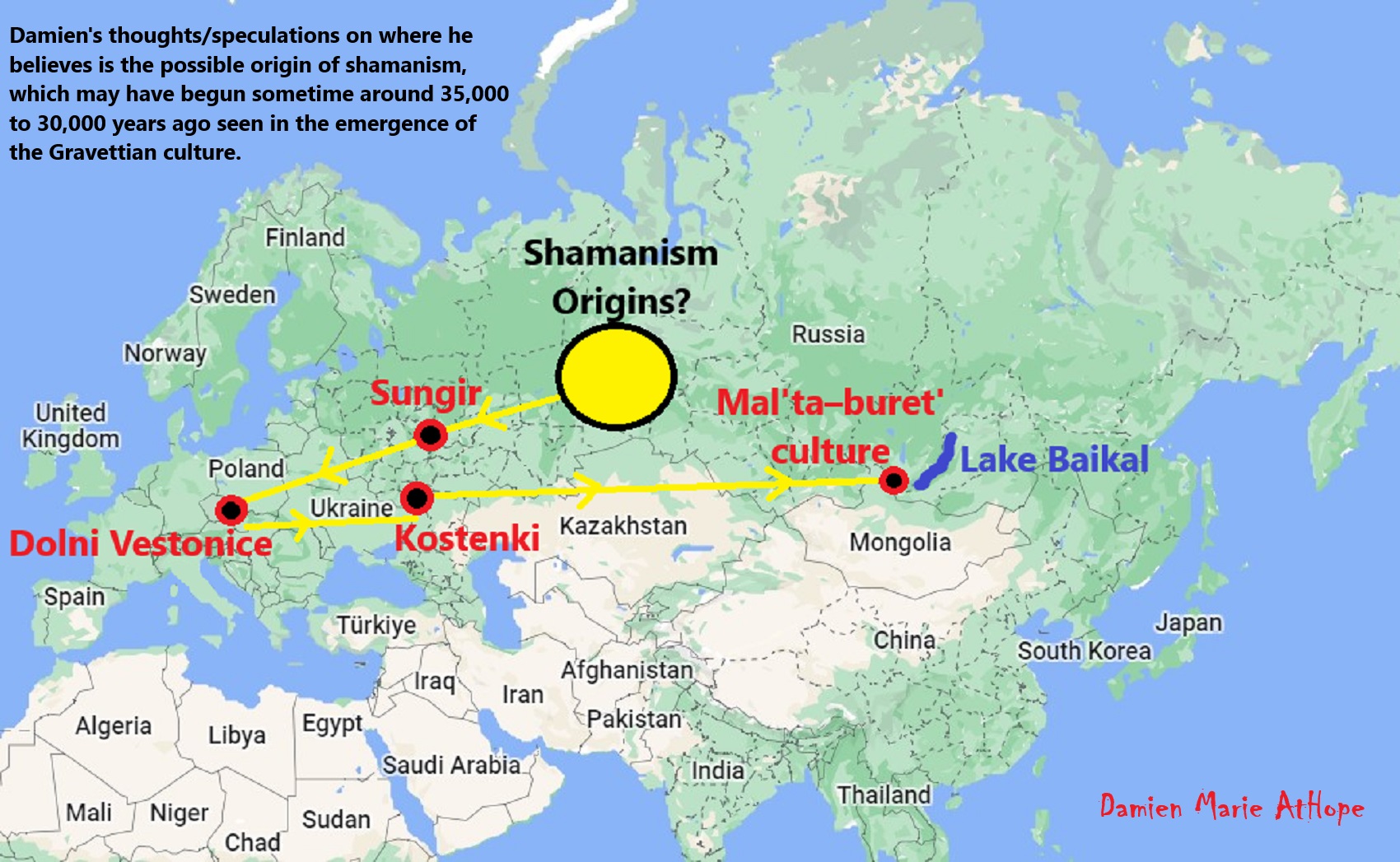
Here are Damien’s thoughts/speculations on where he believes is the possible origin of shamanism, which may have begun sometime around 35,000 to 30,000 years ago seen in the emergence of the Gravettian culture, just to outline his thinking, on what thousands of years later led to evolved Asian shamanism, in general, and thus WU shamanism as well. In both Europe-related “shamanism-possible burials” and in Gravettian mitochondrial DNA is a seeming connection to Haplogroup U. And the first believed Shaman proposed burial belonged to Eastern Gravettians/Pavlovian culture at Dolní Věstonice in southern Moravia in the Czech Republic, which is the oldest permanent human settlement that has ever been found. It is at Dolní Věstonice where approximately 27,000-25,000 years ago a seeming female shaman was buried and also there was an ivory totem portrait figure, seemingly of her.
“The Pavlovian is an Upper Paleolithic culture, a variant of the Gravettian, that existed in the region of Moravia, northern Austria, and southern Poland around 29,000–25,000 years ago. Its name is derived from the village of Pavlov, in the Pavlov Hills, next to Dolní Věstonice in southern Moravia. The culture used sophisticated stone age technology to survive in the tundra on the fringe of the ice sheets around the Last Glacial Maximum. Excavation has yielded flint implements, polished and drilled stone artifacts, bone spearheads, needles, digging tools, flutes, bone ornaments, drilled animal teeth, and seashells. Art or religious finds are bone carvings and figurines of humans and animals made of mammoth tusk, stone, and fired clay.” ref
“One of the burials, located near the huts, revealed a human female skeleton aged to 40+ years old, ritualistically placed beneath a pair of mammoth scapulae, one leaning against the other. Surprisingly, the left side of the skull was disfigured in the same manner as the aforementioned carved ivory figure, indicating that the figure was an intentional depiction of this specific individual. The bones and the earth surrounding the body contained traces of red ocher, a flint spearhead had been placed near the skull, and one hand held the body of a fox. This evidence suggests that this was the burial site of a shaman. This is the oldest site not only of ceramic figurines and artistic portraiture, but also of evidence of female shamans.” ref
“A burial of an approximately forty-year-old woman was found at Dolní Věstonice in an elaborate burial setting. Various items found with the woman have had a profound impact on the interpretation of the social hierarchy of the people at the site, as well as indicating an increased lifespan for these inhabitants. The remains were covered in red ochre, a compound known to have religious significance, indicating that this woman’s burial was ceremonial in nature. Also, the inclusion of a mammoth scapula and a fox are indicative of a high-status burial.” ref
“In the Upper Paleolithic, anatomically modern humans began living longer, often reaching middle age, by today’s standards. Rachel Caspari argues in “Human Origins: the Evolution of Grandparents,” that life expectancy increased during the Upper Paleolithic in Europe (Caspari 2011). She also describes why elderly people were highly influential in society. Grandparents assisted in childcare, perpetuated cultural transmission, and contributed to the increased complexity of stone tools (Caspari 2011). The woman found at Dolní Věstonice was old enough to have been a grandparent. Although human lifespans were increasing, elderly individuals in Upper Paleolithic societies were still relatively rare. Because of this, it is possible that the woman was attributed with great importance and wisdom, and revered because of her age. Because of her advanced age, it is also possible she had a decreased ability to care for herself, instead relying on her family group to care for her, which indicates strong social connections.” ref
“Furthermore, a female figurine was found at the site and is believed to be associated with the aged woman, because of remarkably similar facial characteristics. The woman was found to have deformities on the left side of her face. The special importance accorded with her burial, in addition to her facial deformity, makes it possible that she was a shaman in this time period, where it was “not uncommon that people with disabilities, either mental or physical, are thought to have unusual supernatural powers” (Pringle 2010).” ref
“In 1981, Patricia Rice studied a multitude of female clay figurines found at Dolní Věstonice, believed to represent fertility in this society. She challenged this assumption by analyzing all the figurines and found that, “it is womanhood, rather than motherhood that is symbolically recognized or honored” (Rice 1981: 402). This interpretation challenged the widely held assumption that all prehistoric female figurines were created to honor fertility. The fact is that we have no idea why these figurines proliferated nor of their purpose or usage.” ref
“Haplogroup U5 is estimated to be about 30,000 years old, and it is primarily found today in people with European ancestry. Both the current geographic distribution of U5 and testing of ancient human remains indicate that the ancestor of U5 expanded into Europe before 31,000 years ago. A 2013 study by Fu et al. found two U5 individuals at the Dolni Vestonice burial site in the Czech Republic that has been dated to 31,155 years ago. A third person from the same burial was identified as haplogroup U8. The Dolni Vestonice samples have only two of the five mutations ( C16192T and C16270T) that are found in the present day U5 population. This indicates that the U5-(C16192T and C16270T) mtDNA sequence is ancestral to the present day U5 population that includes the additional three mutations T3197C, G9477A and T13617C.” ref
“Haplogroup U5 is thought to have evolved in the western steppe region and then entered Europe around 30,000 to 55,000 years ago. Results support previous hypotheses that haplogroup U5 mtDNAs expanded throughout Northern, Southern, and Central Europe with more recent expansions into Western Europe and Africa. The results further allow us to explain how U5 mtDNAs are now found with high frequency in Northern Europe, as well as delineate the origins of the specific U5 subhaplogroups found in that part of Europe.” ref
“Haplogroup U5 is found throughout Europe with an average frequency ranging from 5% to 12% in most regions. U5a is most common in north-east Europe and U5b in northern Spain. Nearly half of all Sami and one fifth of Finnish maternal lineages belong to U5. Other high frequencies are observed among the Mordovians (16%), the Chuvash (14.5%) and the Tatars (10.5%) in the Volga-Ural region of Russia, the Estonians (13%), the Lithuanians (11.5%) and the Latvians in the Baltic, the Dargins (13.5%), Avars (13%) and the Chechens (10%) in the Northeast Caucasus, the Basques (12%), the Cantabrians (11%) and the Catalans (10%) in northern Spain, the Bretons (10.5%) in France, the Sardinians (10%) in Italy, the Slovaks (11%), the Croatians (10.5%), the Poles (10%), the Czechs (10%), the Ukrainians (10%) and the Slavic Russians (10%). Overall, U5 is generally found in population with high percentages of Y-haplogroups I1, I2, and R1a, three lineages already found in Mesolithic Europeans. The highest percentages are observed in populations associated predominantly with Y-haplogroup N1c1 (the Finns and the Sami), although N1c1 is originally an East Asian lineage that spread over Siberia and Northeast Europe and assimilated indigenous U5 maternal lineages.” ref
“The age of haplogroup U5 is uncertain at present. It could have arisen as recently as 35,000 years ago, or as early was 50,000 years ago. U5 appear to have been a major maternal lineage among the Paleolithic European hunter-gatherers, and even the dominant lineage during the European Mesolithic. In two papers published two months apart, Posth et al. 2016 and Fu et al. 2016 reported the results of over 70 complete human mitochondrial genomes ranging from 45,000 to 7,000 years ago. The oldest U5 samples all dated from the Gravettian culture (c. 32,000 to 22,000 years ago), while the older Aurignacian samples belonged to mt-haplogroups M, N, R*, and U2. Among the 16 Gravettian samples that yielded reliable results, six belonged to U5 – the others belonging mostly to U2, as well as isolated samples of M, U*, and U8c. Two Italian Epigravettian samples, one from the Paglicci Cave in Apulia (18,500 years ago), and another one from Villabruna in Veneto (14,000 years ago), belonged to U5b2b, as did two slightly more recent Epipaleolithic samples from the Rhône valley in France. U5b1 samples were found in Epipalaeolithic Germany, Switzerland (U5b1h in the Grotte du Bichon), and France. More 80% of the numerous Mesolithic European mtDNA tested to date belonged to various subclades of U5. Overall, it appears that U5 arrived in Europe with the Gravettian tool makers, and that it particularly prospered from the end of the glacial period (from 11,700 years ago) until the arrival of Neolithic farmers from the Near East (between 8,500 and 6,000 years ago).” ref
“Carriers of haplogroup U5 were part of the Gravettian culture, which experienced the Last Glacial Maximum (LGM, 26,000 to 19,000 years ago). During this particularly harsh period, Gravettian people would have retreated into refugia in southern Europe, from which they would have re-expanded to colonise the northern half of the continent during the Late Glacial and postglacial periods. For reasons that are yet unknown, haplogroup U5 seems to have resisted better to the LGM to other Paleolithic haplogroups like U*, U2 and U8. Mitochondrial DNA being essential for energy production, it could be that the mutations selected in early U5 subclades (U5a1, U5a2, U5b1, U5b2) conferred an advantage for survival during the coldest millennia of the LGM, which had for effect to prune less energy efficient mtDNA lineages.” ref
“It is likely that U5a and U5b lineages already existed prior to the LGM and they were geographically scattered to some extent around Europe before the growing ice sheet forced people into the refugia. Nonetheless, founder effects among the populations of each LGM refugium would have amplified the regional division between U5b and U5a. U5b would have been found at a much higher frequency in the Franco-Cantabrian region. We can deduce this from the fact that modern Western Europeans have considerably more U5b than U5a, but also because the modern Basques and Cantabrians possess almost exclusively U5b lineages. What’s more, all the Mesolithic U5 samples from Iberia whose subclade could be identified belonged to U5b.” ref
“Conversely, only U5a lineages have been found so far in Mesolithic Russia (U5a1) and Sweden (U5a1 and U5a2), which points at an eastern origin of this subclade. Mesolithic samples from Poland, Germany and Italy yielded both U5a and U5b subclades. German samples included U5a2a, U5a2c3, U5b2 and U5b2a2. The same observations are valid for the Neolithic and Chalcolithic periods too, with U5a1 being found in Russia and Ukraine, U5b in France (Cardium Pottery and Megalithic), U5b2 in Portugal. U5b1b1 arose approximately 10,000 years ago, over two millennia after the end of the Last Glaciation, when the Neolithic Revolution was already under way in the Near East. Despite this relatively young age, U5b1b1 is found scattered across all Europe and well beyond its boundaries. The Saami, who live in the far European North and have 48% of U5 and 42% of V lineages, belong exclusively to the U5b1b1 subclade. Amazingly, the Berbers of Northwest Africa also possess that U5b1b1 subclade and haplogroup V.” ref

ref, ref, ref, ref, ref, ref, ref, ref, ref, ref, ref, ref, ref, ref, ref, ref, ref, ref, ref
Here are my thoughts/speculations on where I believe is the possible origin of shamanism, which may have begun sometime around 35,000 to 30,000 years ago seen in the emergence of the Gravettian culture, just to outline his thinking, on what thousands of years later led to evolved Asian shamanism, in general, and thus WU shamanism as well. In both Europe-related “shamanism-possible burials” and in Gravettian mitochondrial DNA is a seeming connection to Haplogroup U. And the first believed Shaman proposed burial belonged to Eastern Gravettians/Pavlovian culture at Dolní Věstonice in southern Moravia in the Czech Republic, which is the oldest permanent human settlement that has ever been found. It is at Dolní Věstonice where approximately 27,000-25,000 years ago a seeming female shaman was buried and also there was an ivory totem portrait figure, seemingly of her.
And my thoughts on how cultural/ritual aspects were influenced in the area of Göbekli Tepe. I think it relates to a few different cultures starting in the area before the Neolithic. Two different groups of Siberians first from northwest Siberia with U6 haplogroup 40,000 to 30,000 or so. Then R Haplogroup (mainly haplogroup R1b but also some possible R1a both related to the Ancient North Eurasians). This second group added its “R1b” DNA of around 50% to the two cultures Natufian and Trialetian. To me, it is likely both of these cultures helped create Göbekli Tepe. Then I think the female art or graffiti seen at Göbekli Tepe to me possibly relates to the Epigravettians that made it into Turkey and have similar art in North Italy. I speculate that possibly the Totem pole figurines seen first at Kostenki, next went to Mal’ta in Siberia as seen in their figurines that also seem “Totem-pole-like”, and then with the migrations of R1a it may have inspired the Shigir idol in Russia and the migrations of R1b may have inspired Göbekli Tepe.

Ancient North Eurasian (ANE)
Ancient Beringian/Ancestral Native American (AB/ANA)
Eastern Hunter-Gatherer (EHG)
Western Hunter-Gatherers (WHG)
Western Steppe Herders (WSH)
Scandinavian Hunter-Gatherer (SHG)
Early European Farmers (EEF)
Jōmon people (Ainu people OF Hokkaido Island)
Neolithic Iranian farmers (Iran_N) (Iran Neolithic)
Haplogroup R possible time of origin about 27,000 years in Central Asia, South Asia, or Siberia:
- Mal’ta–Buret’ culture (24,000-15,000 years ago)
- Afontova Gora culture (21,000-12,000 years ago)
- Trialetian culture (16,000–8000 years ago)
- Samara culture (7,000-6,500 years ago)
- Khvalynsk culture (7,000-6,500 years ago)
- Afanasievo culture (5,300-4,500 years ago)
- Yamna/Yamnaya Culture (5,300-4,500 years ago)
- Andronovo culture (4,000–2,900 years ago) ref
Groups partially derived from the Ancient North Eurasians
“The ANE lineage is defined by association with the MA-1, or “Mal’ta boy”, remains of 24,000 years ago in central Siberia Mal’ta-Buret’ culture 24,000-15,000 years ago. The Ancient North Eurasians (ANE) samples (Afontova Gora 3, Mal’ta 1, and Yana-RHS) show evidence for minor gene flow from an East Asian-related group (simplified by the Amis, Han, or Tianyuan) but no evidence for ANE-related geneflow into East Asians (Amis, Han, Tianyuan), except the Ainu, of North Japan.” ref
“The ANE lineage is defined by association with the MA-1, or “Mal’ta boy”, remains of 24,000 years ago in central Siberia Mal’ta-Buret’ culture 24,000-15,000 years ago “basal to modern-day Europeans”. Some Ancient North Eurasians also carried East Asian populations, such as Tianyuan Man.” ref
“Bronze-age-steppe Yamnaya and Afanasevo cultures were ANE at around 50% and Eastern Hunter-Gatherer (EHG) at around 75% ANE. Karelia culture: Y-DNA R1a-M417 8,400 years ago, Y-DNA J, 7,200 years ago, and Samara, of Y-haplogroup R1b-P297 7,600 years ago is closely related to ANE from Afontova Gora, 18,000 years ago around the time of blond hair first seen there.” ref
Ancient North Eurasian
“In archaeogenetics, the term Ancient North Eurasian (often abbreviated as ANE) is the name given to an ancestral West Eurasian component that represents descent from the people similar to the Mal’ta–Buret’ culture and populations closely related to them, such as from Afontova Gora and the Yana Rhinoceros Horn Site. Significant ANE ancestry are found in some modern populations, including Europeans and Native Americans.” ref
“The ANE lineage is defined by association with the MA-1, or “Mal’ta boy“, the remains of an individual who lived during the Last Glacial Maximum, 24,000 years ago in central Siberia, Ancient North Eurasians are described as a lineage “which is deeply related to Paleolithic/Mesolithic hunter-gatherers in Europe,” meaning that they diverged from Paleolithic Europeans a long time ago.” ref
“The ANE population has also been described as having been “basal to modern-day Europeans” but not especially related to East Asians, and is suggested to have perhaps originated in Europe or Western Asia or the Eurasian Steppe of Central Asia. However, some samples associated with Ancient North Eurasians also carried ancestry from an ancient East Asian population, such as Tianyuan Man. Sikora et al. (2019) found that the Yana RHS sample (31,600 BP) in Northern Siberia “can be modeled as early West Eurasian with an approximately 22% contribution from early East Asians.” ref
“Populations genetically similar to MA-1 were an important genetic contributor to Native Americans, Europeans, Central Asians, South Asians, and some East Asian groups, in order of significance. Lazaridis et al. (2016:10) note “a cline of ANE ancestry across the east-west extent of Eurasia.” The ancient Bronze-age-steppe Yamnaya and Afanasevo cultures were found to have a noteworthy ANE component at ~50%.” ref
“According to Moreno-Mayar et al. 2018 between 14% and 38% of Native American ancestry may originate from gene flow from the Mal’ta–Buret’ people (ANE). This difference is caused by the penetration of posterior Siberian migrations into the Americas, with the lowest percentages of ANE ancestry found in Eskimos and Alaskan Natives, as these groups are the result of migrations into the Americas roughly 5,000 years ago.” ref
“Estimates for ANE ancestry among first wave Native Americans show higher percentages, such as 42% for those belonging to the Andean region in South America. The other gene flow in Native Americans (the remainder of their ancestry) was of East Asian origin. Gene sequencing of another south-central Siberian people (Afontova Gora-2) dating to approximately 17,000 years ago, revealed similar autosomal genetic signatures to that of Mal’ta boy-1, suggesting that the region was continuously occupied by humans throughout the Last Glacial Maximum.” ref
“The earliest known individual with a genetic mutation associated with blonde hair in modern Europeans is an Ancient North Eurasian female dating to around 16000 BCE from the Afontova Gora 3 site in Siberia. It has been suggested that their mythology may have included a narrative, found in both Indo-European and some Native American fables, in which a dog guards the path to the afterlife.” ref
“Genomic studies also indicate that the ANE component was introduced to Western Europe by people related to the Yamnaya culture, long after the Paleolithic. It is reported in modern-day Europeans (7%–25%), but not of Europeans before the Bronze Age. Additional ANE ancestry is found in European populations through paleolithic interactions with Eastern Hunter-Gatherers, which resulted in populations such as Scandinavian Hunter-Gatherers.” ref
“The Ancient North Eurasians (ANE) split from the ancestors of European peoples somewhere in the Middle East or South-central Asia, and used a northern dispersal route through Central Asia into Northern Asia and Siberia. Genetic analyses show that all ANE samples (Afontova Gora 3, Mal’ta 1, and Yana-RHS) show evidence for minor gene flow from an East Asian-related group (simplified by the Amis, Han, or Tianyuan). In contrast, no evidence for ANE-related geneflow into East Asians (Amis, Han, Tianyuan), except the Ainu, was found.” ref
“Genetic data suggests that the ANE formed during the Terminal Upper-Paleolithic (36+-1,5ka) period from a deeply European-related population, which was once widespread in Northern Eurasia, and from an early East Asian-related group, which migrated northwards into Central Asia and Siberia, merging with this deeply European-related population. These population dynamics and constant northwards geneflow of East Asian-related ancestry would later gave rise to the “Ancestral Native Americans” and Paleosiberians, which replaced the ANE as dominant population of Siberia.” ref
Groups partially derived from the Ancient North Eurasians
“Eastern Hunter-Gatherer (EHG) is a lineage derived predominantly (75%) from ANE. It is represented by two individuals from Karelia, one of Y-haplogroup R1a-M417, dated c. 8.4 kya, the other of Y-haplogroup J, dated c. 7.2 kya; and one individual from Samara, of Y-haplogroup R1b-P297, dated c. 7.6 kya. This lineage is closely related to the ANE sample from Afontova Gora, dated c. 18 kya. After the end of the Last Glacial Maximum, the Western Hunter-Gatherers (WHG) and EHG lineages merged in Eastern Europe, accounting for early presence of ANE-derived ancestry in Mesolithic Europe. Evidence suggests that as Ancient North Eurasians migrated West from Eastern Siberia, they absorbed Western Hunter-Gatherers and other West Eurasian populations as well.” ref
“Caucasian Hunter-Gatherer (CHG) is represented by the Satsurblia individual dated ~13 kya (from the Satsurblia cave in Georgia), and carried 36% ANE-derived admixture. While the rest of their ancestry is derived from the Dzudzuana cave individual dated ~26 kya, which lacked ANE-admixture, Dzudzuana affinity in the Caucasus decreased with the arrival of ANE at ~13 kya Satsurblia.” ref
“Scandinavian Hunter-Gatherer (SHG) is represented by several individuals buried at Motala, Sweden ca. 6000 BC. They were descended from Western Hunter-Gatherers who initially settled Scandinavia from the south, and later populations of EHG who entered Scandinavia from the north through the coast of Norway.” ref
“Iran Neolithic (Iran_N) individuals dated ~8.5 kya carried 50% ANE-derived admixture and 50% Dzudzuana-related admixture, marking them as different from other Near-Eastern and Anatolian Neolithics who didn’t have ANE admixture. Iran Neolithics were later replaced by Iran Chalcolithics, who were a mixture of Iran Neolithic and Near Eastern Levant Neolithic.” ref
“Ancient Beringian/Ancestral Native American are specific archaeogenetic lineages, based on the genome of an infant found at the Upward Sun River site (dubbed USR1), dated to 11,500 years ago. The AB lineage diverged from the Ancestral Native American (ANA) lineage about 20,000 years ago.” ref
“West Siberian Hunter-Gatherer (WSHG) are a specific archaeogenetic lineage, first reported in a genetic study published in Science in September 2019. WSGs were found to be of about 30% EHG ancestry, 50% ANE ancestry, and 20% to 38% East Asian ancestry.” ref
“Western Steppe Herders (WSH) is the name given to a distinct ancestral component that represents descent closely related to the Yamnaya culture of the Pontic–Caspian steppe. This ancestry is often referred to as Yamnaya ancestry or Steppe ancestry.” ref
“Late Upper Paeolithic Lake Baikal – Ust’Kyakhta-3 (UKY) 14,050-13,770 BP were mixture of 30% ANE ancestry and 70% East Asian ancestry.” ref
“Lake Baikal Holocene – Baikal Eneolithic (Baikal_EN) and Baikal Early Bronze Age (Baikal_EBA) derived 6.4% to 20.1% ancestry from ANE, while rest of their ancestry was derived from East Asians. Fofonovo_EN near by Lake Baikal were mixture of 12-17% ANE ancestry and 83-87% East Asian ancestry.” ref
“Hokkaido Jōmon people specifically refers to the Jōmon period population of Hokkaido in northernmost Japan. Though the Jōmon people themselves descended mainly from East Asian lineages, one study found an affinity between Hokkaido Jōmon with the Northern Eurasian Yana sample (an ANE-related group, related to Mal’ta), and suggest as an explanation the possibility of minor Yana gene flow into the Hokkaido Jōmon population (as well as other possibilities). A more recent study by Cooke et al. 2021, confirmed ANE-related geneflow among the Jōmon people, partially ancestral to the Ainu people. ANE ancestry among Jōmon people is estimated at 21%, however, there is a North to South cline within the Japanese archipelago, with the highest amount of ANE ancestry in Hokkaido and Tohoku.” ref
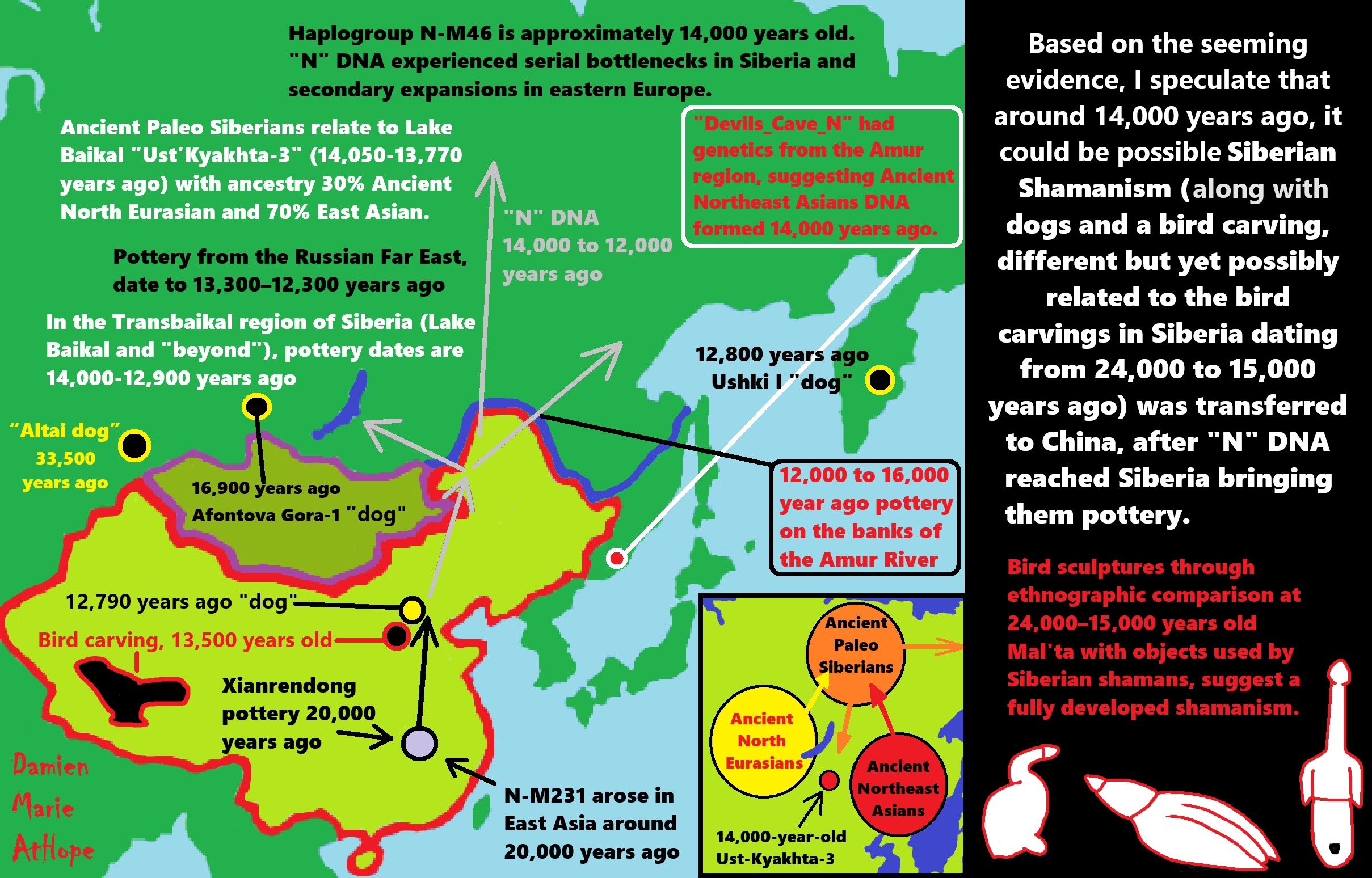
ref, ref, ref, ref, ref, ref, ref, ref, ref, ref, ref, ref, ref, ref, ref, ref
Based on the seeming evidence, I speculate that around 14,000 years ago, it could be possible Siberian Shamanism (along with dogs and a bird carving, different but yet possibly related to the bird carvings in Siberia dating from 24,000 to 15,000 years ago) was transferred to China, after “N” DNA reached Siberia bringing them pottery. Bird sculptures through ethnographic comparison at 24,000–15,000 years old Mal’ta with objects used by Siberian shamans, suggest a fully developed shamanism.
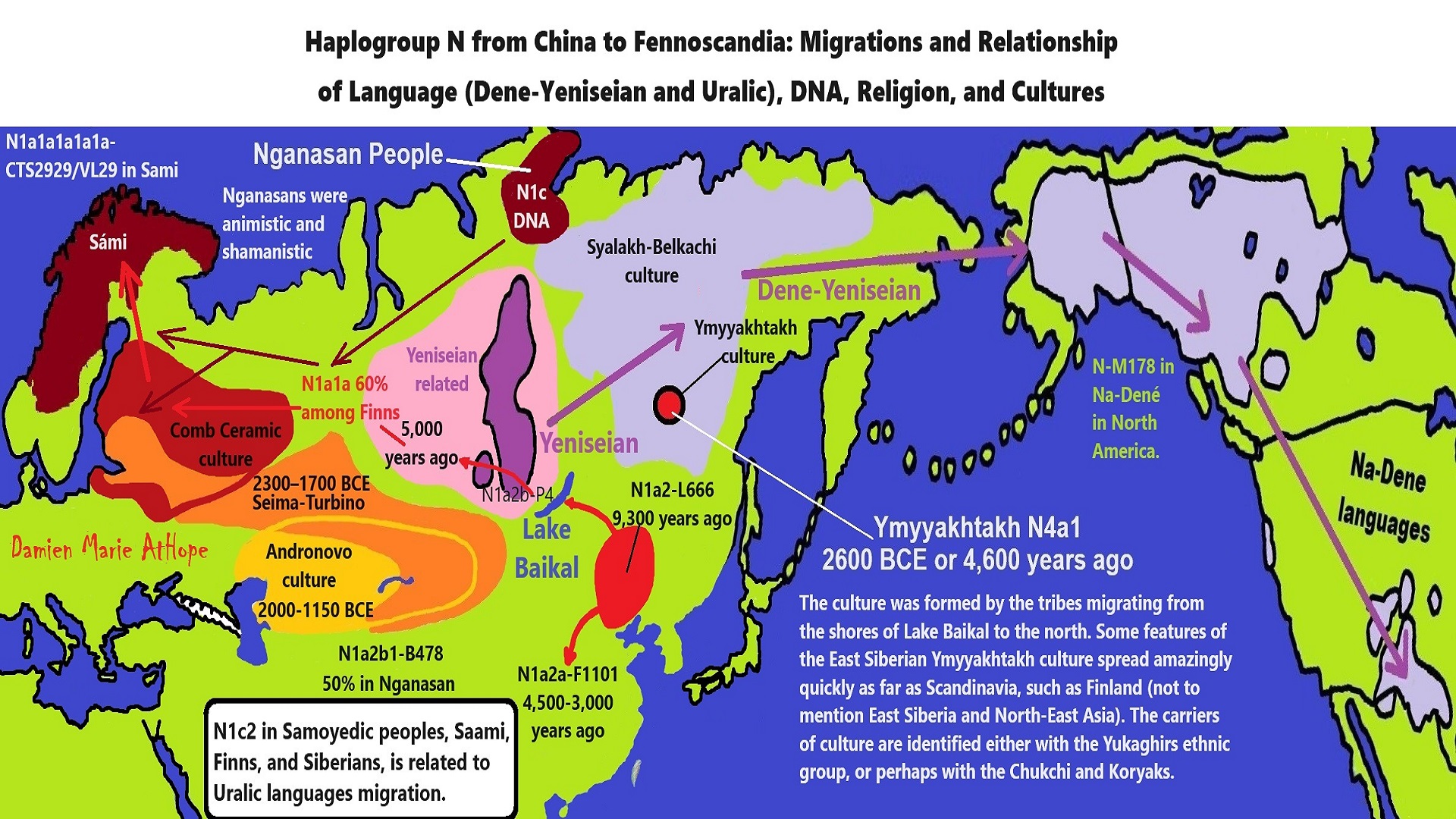
ref, ref, ref, ref, ref, ref, ref, ref, ref, ref, ref, ref, ref, ref, ref, ref
Postglacial genomes from foragers across Northern Eurasia reveal prehistoric
mobility associated with the spread of the Uralic and Yeniseian languages
Abstract
“The North Eurasian forest and forest-steppe zones have sustained millennia of sociocultural connections among northern peoples. We present genome-wide ancient DNA data for 181 individuals from this region spanning the Mesolithic, Neolithic, and Bronze Age. We find that Early to Mid-Holocene hunter-gatherer populations from across the southern forest and forest-steppes of Northern Eurasia can be characterized by a continuous gradient of ancestry that remained stable for millennia, ranging from fully West Eurasian in the Baltic region to fully East Asian in the Transbaikal region. In contrast, cotemporaneous groups in far Northeast Siberia were genetically distinct, retaining high levels of continuity from a population that was the primary source of ancestry for Native Americans. By the mid-Holocene, admixture between this early Northeastern Siberian population and groups from Inland East Asia and the Amur River Basin produced two distinctive populations in eastern Siberia that played an important role in the genetic formation of later people. Ancestry from the first population, Cis-Baikal Late Neolithic-Bronze Age (Cisbaikal_LNBA), is found substantially only among Yeniseian-speaking groups and those known to have admixed with them. Ancestry from the second, Yakutian Late Neolithic-Bronze Age (Yakutia_LNBA), is strongly associated with present-day Uralic speakers. We show how Yakutia_LNBA ancestry spread from an east Siberian origin ~4.5kya, along with subclades of Y-chromosome haplogroup N occurring at high frequencies among present-day Uralic speakers, into Western and Central Siberia in communities associated with Seima-Turbino metallurgy: a suite of advanced bronze casting techniques that spread explosively across an enormous region of Northern Eurasia ~4.0kya. However, the ancestry of the 16 Seima-Turbino-period individuals–the first reported from sites with this metallurgy–was otherwise extraordinarily diverse, with partial descent from Indo-Iranian-speaking pastoralists and multiple hunter-gatherer populations from widely separated regions of Eurasia. Our results provide support for theories suggesting that early Uralic speakers at the beginning of their westward dispersal where involved in the expansion of Seima-Turbino metallurgical traditions, and suggests that both cultural transmission and migration were important in the spread of Seima-Turbino material culture.” ref
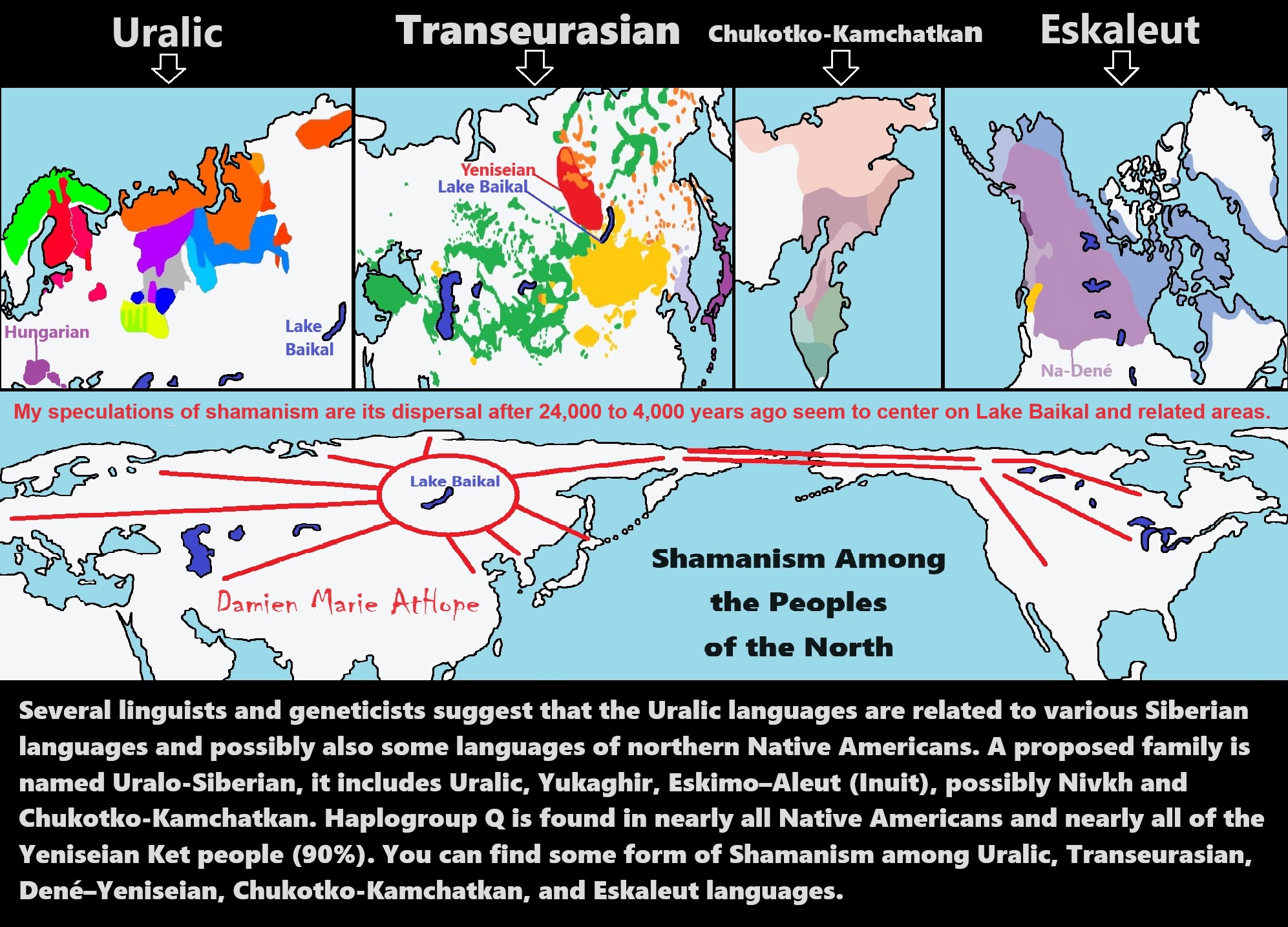
ref, ref, ref, ref, ref, ref, ref, ref, ref
“Several linguists and geneticists suggest that the Uralic languages are related to various Siberian languages and possibly also some languages of northern Native Americans. A proposed family is named Uralo-Siberian, it includes Uralic, Yukaghir, Eskimo–Aleut (Inuit), possibly Nivkh, and Chukotko-Kamchatkan. Haplogroup Q is found in nearly all Native Americans and nearly all of the Yeniseian Ket people (90%).” ref, ref
You can find some form of Shamanism, among Uralic, Transeurasian, Dené–Yeniseian, Chukotko-Kamchatkan, and Eskaleut languages.
My speculations of shamanism are its dispersals, after 24,000 to 4,000 years ago, seem to center on Lake Baikal and related areas. To me, the hotspot of Shamanism goes from west of Lake Baikal in the “Altai Mountains” also encompassing “Lake Baikal” and includes the “Amur Region/Watershed” east of Lake Baikal as the main location Shamanism seems to have radiated out from.

ref, ref, ref, ref, ref, ref, ref, ref, ref, ref, ref, ref, ref, ref, ref, ref, ref
“These ideas are my speculations from the evidence.”
I am still researching the “god‘s origins” all over the world. So you know, it is very complicated but I am smart and willing to look, DEEP, if necessary, which going very deep does seem to be needed here, when trying to actually understand the evolution of gods and goddesses. I am sure of a few things and less sure of others, but even in stuff I am not fully grasping I still am slowly figuring it out, to explain it to others. But as I research more I am understanding things a little better, though I am still working on understanding it all or something close and thus always figuring out more.
Sky Father/Sky God?
“Egyptian: (Nut) Sky Mother and (Geb) Earth Father” (Egypt is different but similar)
Turkic/Mongolic: (Tengri/Tenger Etseg) Sky Father and (Eje/Gazar Eej) Earth Mother *Transeurasian*
Hawaiian: (Wākea) Sky Father and (Papahānaumoku) Earth Mother *Austronesian*
New Zealand/ Māori: (Ranginui) Sky Father and (Papatūānuku) Earth Mother *Austronesian*
Proto-Indo-European: (Dyḗus/Dyḗus ph₂tḗr) Sky Father and (Dʰéǵʰōm/Pleth₂wih₁) Earth Mother
Indo-Aryan: (Dyaus Pita) Sky Father and (Prithvi Mata) Earth Mother *Indo-European*
Italic: (Jupiter) Sky Father and (Juno) Sky Mother *Indo-European*
Etruscan: (Tinia) Sky Father and (Uni) Sky Mother *Tyrsenian/Italy Pre–Indo-European*
Hellenic/Greek: (Zeus) Sky Father and (Hera) Sky Mother who started as an “Earth Goddess” *Indo-European*
Nordic: (Dagr) Sky Father and (Nótt) Sky Mother *Indo-European*
Slavic: (Perun) Sky Father and (Mokosh) Earth Mother *Indo-European*
Illyrian: (Deipaturos) Sky Father and (Messapic Damatura’s “earth-mother” maybe) Earth Mother *Indo-European*
Albanian: (Zojz) Sky Father and (?) *Indo-European*
Baltic: (Perkūnas) Sky Father and (Saulė) Sky Mother *Indo-European*
Germanic: (Týr) Sky Father and (?) *Indo-European*
Colombian-Muisca: (Bochica) Sky Father and (Huythaca) Sky Mother *Chibchan*
Aztec: (Quetzalcoatl) Sky Father and (Xochiquetzal) Sky Mother *Uto-Aztecan*
Incan: (Viracocha) Sky Father and (Mama Runtucaya) Sky Mother *Quechuan*
China: (Tian/Shangdi) Sky Father and (Dì) Earth Mother *Sino-Tibetan*
Sumerian, Assyrian and Babylonian: (An/Anu) Sky Father and (Ki) Earth Mother
Finnish: (Ukko) Sky Father and (Akka) Earth Mother *Finno-Ugric*
Sami: (Horagalles) Sky Father and (Ravdna) Earth Mother *Finno-Ugric*
Puebloan-Zuni: (Ápoyan Ta’chu) Sky Father and (Áwitelin Tsíta) Earth Mother
Puebloan-Hopi: (Tawa) Sky Father and (Kokyangwuti/Spider Woman/Grandmother) Earth Mother *Uto-Aztecan*
Puebloan-Navajo: (Tsohanoai) Sky Father and (Estsanatlehi) Earth Mother *Na-Dene*
ref, ref, ref, ref, ref, ref, ref, ref, ref, ref, ref, ref, ref, ref, ref, ref, ref, ref, ref, ref, ref, ref, ref, ref, ref, ref, ref
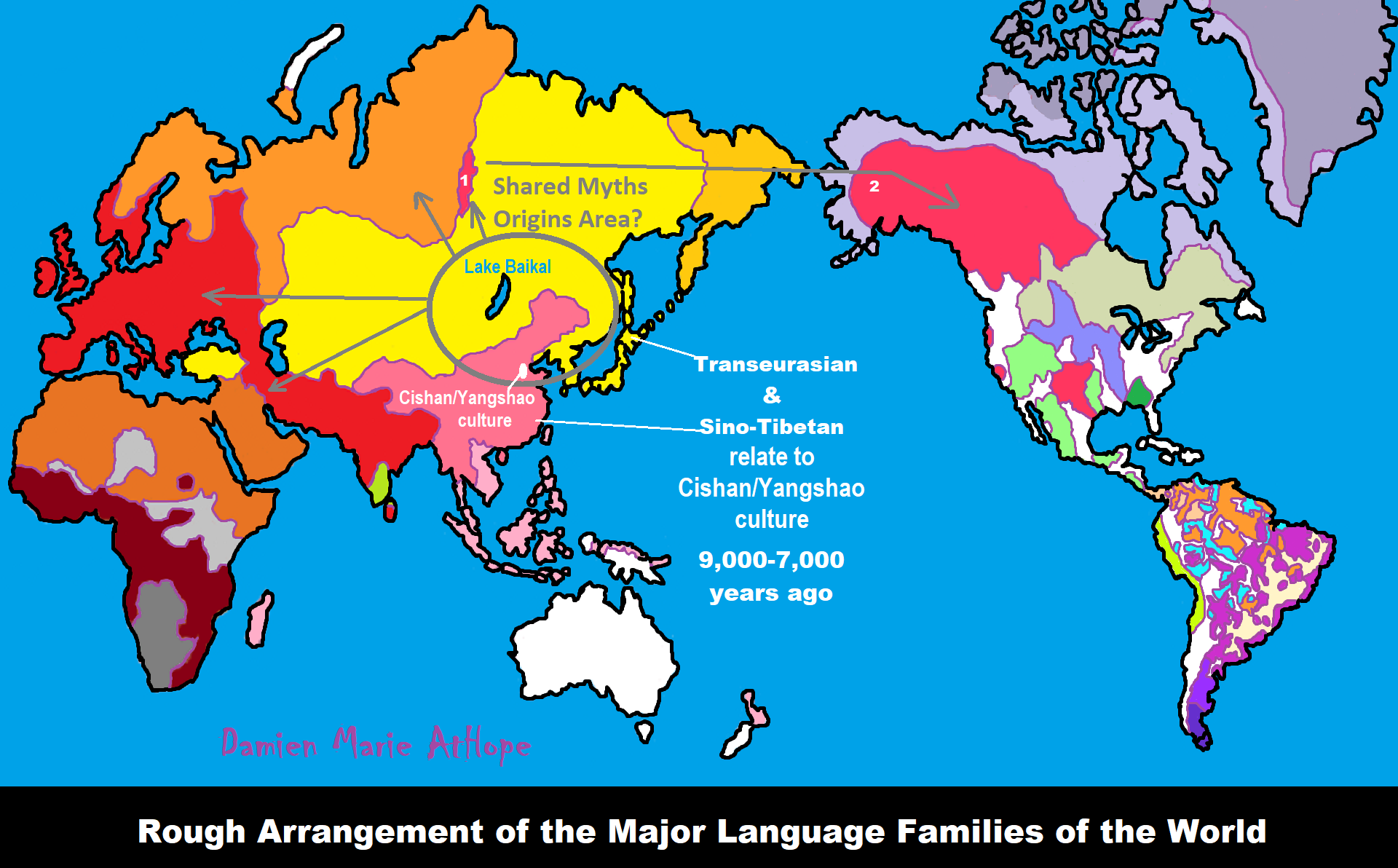
“These ideas are my speculations from the evidence.”
“1 central Eurasian Neolithic individual from Tajikistan (around 8,000 years ago) and approximately 8,200 years ago Yuzhniy Oleniy Ostrov group from Karelia in western Russia formed by 19 genomes affinity to Villabruna ancestry than all the other Eastern Hunter-Gatherer groups” https://www.nature.com/articles/s41586-023-05726-0
SHAMANS AND SYMBOLS PREHISTORY OF SEMIOTICS IN ROCK ART. Mihály Hoppál. International Society for Shamanistic Research https://docplayer.net/52274392-Shamans-and-symbols-prehistory-of-semiotics-in-rock-art-mihaly-hoppal-international-society-for-shamanistic-research.html

Siberian Shamanism has a belief that spirits/supernatural beings, can come from clouds down into a shaman, (a type of intentional believed possession) in a trance, by way of entering through the horns, on top of the head, like a lightning rod.
Shamanism (belief that some special person can commune with these perceived spirits on the behalf of others by way rituals) passably by at least 30,000 years ago. *Believe in spirit-filled life and/or afterlife can be attached to or be expressed in things or objects and these objects can be used by special persons or in special rituals can connect to spirit-filled life and/or afterlife (you are a hidden shamanist)
Afterlife beliefs are likely shamanism related so around 30,000 years ago. Souls go to heaven/or stars/star cluster with the ancestors. So heaven or limbo such as ghosts, not hell though. Hell is around 3,000 to 2,000 years old. Demons/Evil spirits 30,000 years old. Then I think Devils or super Demons or evil gods 5,000 to 3,000 or so.
I think the origin of demons/devils/evil spirits is likely related to shamanism, as shamanism tends to believe that people, when sick may be possessed by harmful/illness forces or entities, could be angry/aggressive or malicious, hurting/oppressing people.
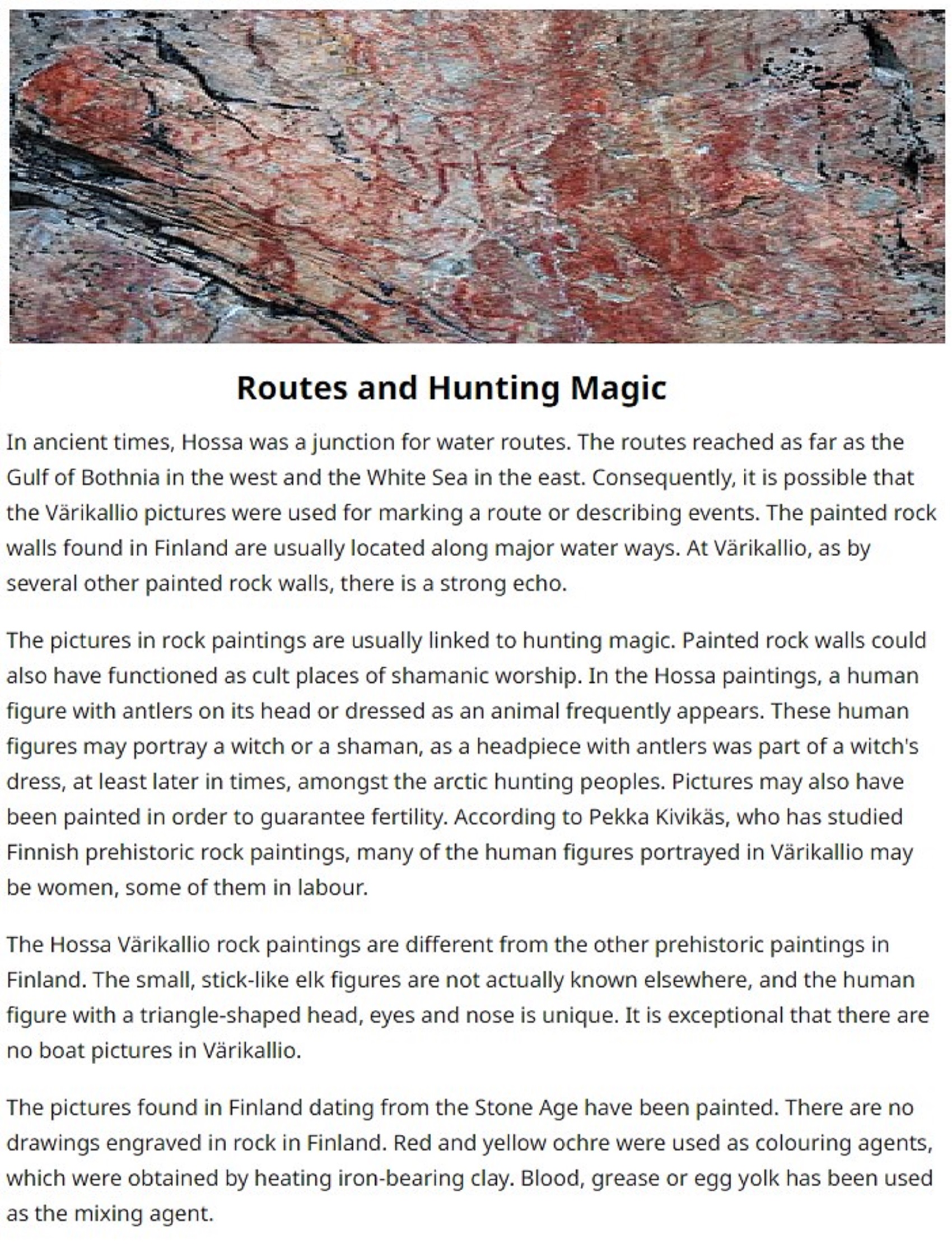
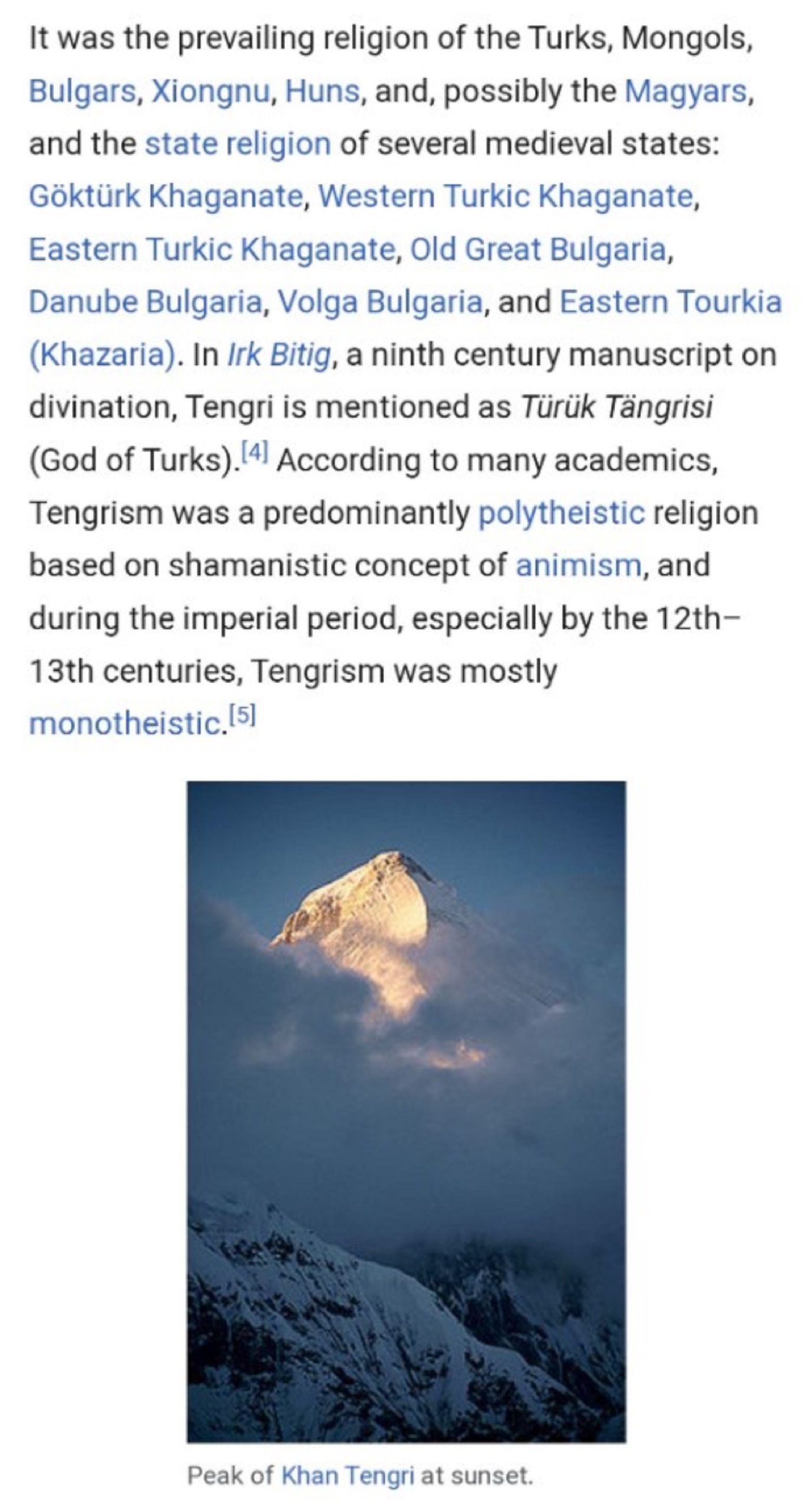
“Tengrism (also known as Tengriism, Tengerism, or Tengrianism) is an ancient ethnic and state Turko–Mongolic religion originating in the Eurasian steppes, based on folk shamanism, monotheistic at the imperial level, and generally centered around the titular sky god Tengri. The term also describes several contemporary Turko-Mongolic native religious movements and teachings. All modern adherents of “political” Tengrism are monotheists.” ref
“It was the prevailing religion of the Turks, Mongols, Bulgars, Xiongnu, Huns, and, possibly the Magyars, and the state religion of several medieval states: Göktürk Khaganate, Western Turkic Khaganate, Eastern Turkic Khaganate, Old Great Bulgaria, Danube Bulgaria, Volga Bulgaria, and Eastern Tourkia (Khazaria). In Irk Bitig, a ninth century manuscript on divination, Tengri is mentioned as Türük Tängrisi (God of Turks). According to many academics, Tengrism was a predominantly polytheistic religion based on shamanistic concept of animism, and during the imperial period, especially by the 12th–13th centuries, Tengrism was mostly monotheistic.” ref
“Tengrism has been advocated in intellectual circles of the Turkic nations of Central Asia (Kyrgyzstan with Kazakhstan) and Russia (Tatarstan, Bashkortostan) since the dissolution of the Soviet Union during the 1990s. Still practiced, it is undergoing an organized revival in Buryatia, Sakha (Yakutia), Khakassia, Tuva, and other Turkic nations in Siberia. Altaian Burkhanism and Chuvash Vattisen Yaly are movements similar to Tengrism.” ref
“Tengri can either refer to the sky deity or refer also to other deities (compare this with the concept of Kami). Tengrism is centered on the worship of the tngri (gods), Tengri (Heaven, God of Heaven) being one of them. In the Mongolian folk religion, Genghis Khan is considered one of the embodiments, if not the main embodiment, of Tengri’s will.” ref
No great violation of ethics is done so joyfully as when one is faith drunk and experiencing the distorting sway of religious beliefs or convictions. Religious thinking is somewhat a natural error of a creative mind not too concerned with what is true as to what is their preferred belief. They should care about the “belief’s” truth status compared to a sound reasoned justification as is always required in any claim of truth.
I have learned a lot of prehistory of the entire world throughout all time until 4,000 years ago and am as confident as humanly possible that all gods and religions are but interesting cultural mythology that shares a family similar to language another cultural product. Be free.
No gods, no aliens, no one culture did everything, rather connected religious thinking and many similar cultures that each diversified over and over and many amazing people doing the almost unbelievable, which tells us, we together can overcome almost anything. Let’s work as one.

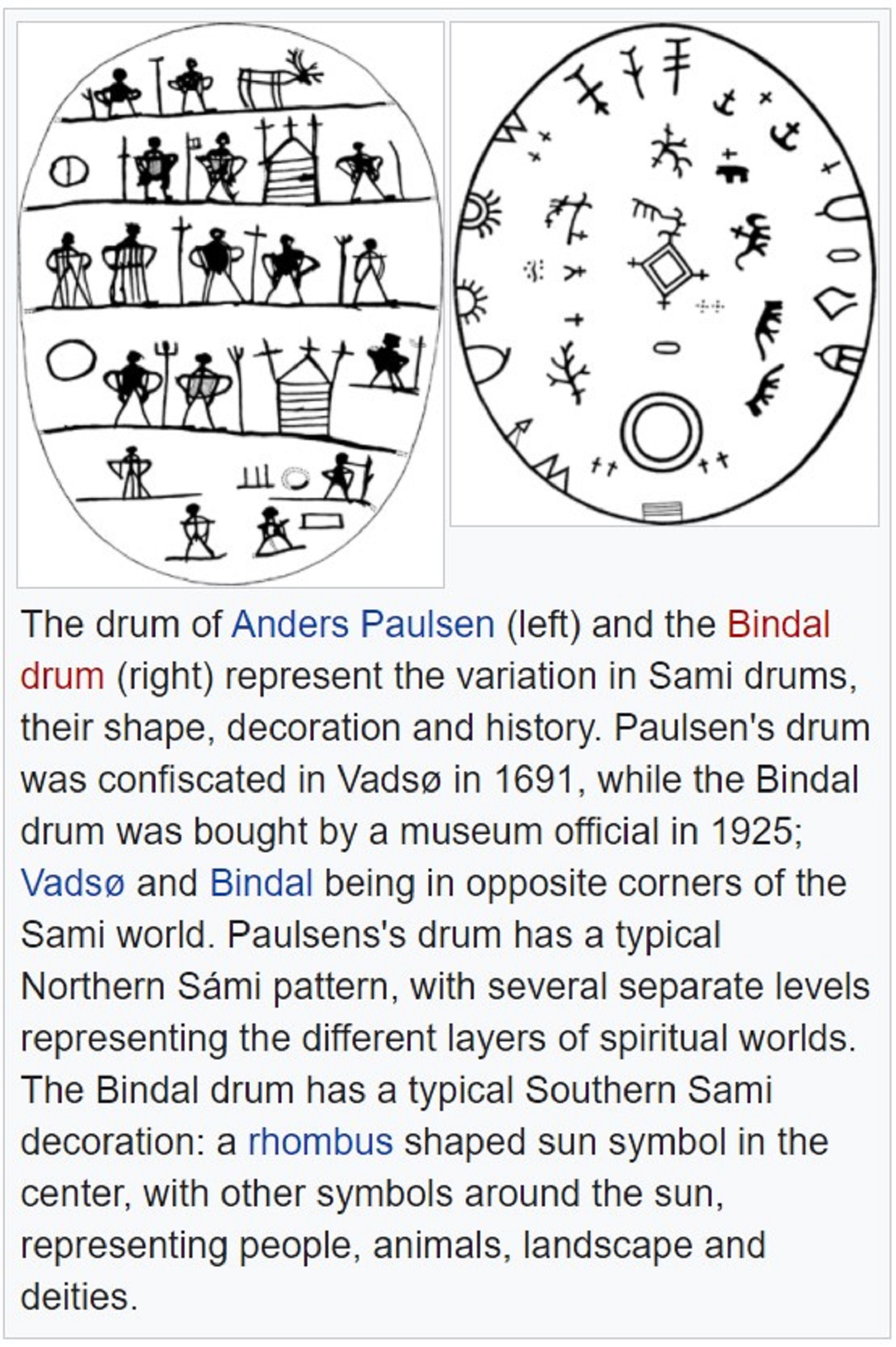
“A Sámi drum is a shamanic ceremonial drum used by the Sámi people of Northern Europe. Sámi ceremonial drums have two chiefly two variations, both oval-shaped: a bowl drum fashioned from reindeer hide.” ref

ref, ref, ref, ref, ref, ref, ref, ref, ref, ref, ref, ref, ref, ref, ref, ref
Spirit beliefs origins relating to shamanism?
So to me, it is clouds in the daytime that could be seen as connected to spirit beliefs and this is similar to how the stars at night are also related to spirits.
I do not hate simply because I challenge and expose myths or lies any more than others being thought of as loving simply because of the protection and hiding from challenge their favored myths or lies.
The truth is best championed in the sunlight of challenge.
An archaeologist once said to me “Damien religion and culture are very different”
My response, So are you saying that was always that way, such as would you say Native Americans’ cultures are separate from their religions? And do you think it always was the way you believe?
I had said that religion was a cultural product. That is still how I see it and there are other archaeologists that think close to me as well. Gods too are the myths of cultures that did not understand science or the world around them, seeing magic/supernatural everywhere.
Ancient Ball Games?
*Chinese Cuju, Ancient Football around 4,300 years ago
*Mesoamerican Ball Game, southern Mexico around 3,700 years ago Mayan’s named it Pok-ta-Pok
*Japanese kemari (cuju) evidence from 644 CE
https://sites.psu.edu/ballgamesoftheworld/ancient-ball-games/
https://en.wikipedia.org/wiki/Cuju
“Kemari ball game that was popular in Japan during the Heian period with the first evidence of Kemari is from 644 CE influenced by the Chinese sport of Cuju (the very earliest form of football). Nowadays, it is played in Shinto religious shrines for festivals.” https://en.wikipedia.org/wiki/Kemari
“The Mesoamerican Ball Game is the oldest known sport in the Americas from southern Mexico around 3,700 years ago. For many pre-Columbian cultures, such as the Olmec, Maya, Zapotec, and Aztec, it was a ritual, political and social activity involving the whole community.” https://www.thoughtco.com/ancient-mesoamerican-ball-game-origins-171572
See religion and culture are one.
“Berbers or Imazighen (Berber languages: ⵉⵎⴰⵣⵉⵖⵏ, ⵎⵣⵗⵏ, romanized: Imaziɣen; singular: Amaziɣ, ⴰⵎⴰⵣⵉⵖ ⵎⵣⵗ; Arabic: أمازيغ) are an ethnic group who are indigenous to North Africa, specifically Morocco, Algeria, Tunisia, Libya, the Canary Islands, and to a lesser extent in Mauritania, northern Mali, and northern Niger. Smaller Berber populations are also found in Burkina Faso and Egypt’s Siwa Oasis. Historically, Berber nations spoke the Berber languages, which are a branch of the Afroasiatic language family. The term Berber comes from the Greek: βάρβαρος (barbaros pl. βάρβαροι barbaroi) meaning ‘barbarian’. The Romans also used the word to refer to their neighbors to the north, in Germania (roughly the area that is Germany today), as well as to Celts, Iberians, Gauls, Goths, and Thracians. Among the oldest written attestations of the word, Berber is its use as an ethnonym in a document from the 1st century AD Periplus of the Erythraean Sea.” ref

The reason I don’t fully explain Australia is I have not done enough research on there to understand it better, so I don’t claim that which I dont know. Or I try not to claim things I don’t understand.
In this show Cory reads:
Marx and Engels also noted how capitalist accumulation latched itself onto social organizations of primitive communism. For instance, in private correspondence the same year that The Origin of the Family was published, Engels attacked European colonialism, describing the Dutch regime in Java directly organizing agricultural production and profiting from it, “on the basis of the old communistic village communities”. He added that cases like the Dutch East Indies, British India and the Russian Empire showed “how today primitive communism furnishes … the finest and broadest basis of exploitation”.
Anarchists, including Kropotkin and Reclus, believed that societies that exemplified primitive communism were also examples of anarchist society before industrialisation. With the San people of southern Africa being a basis for Kropotkin’s anthropological work on anarchism and gift economies in mutual aid. Little development in the research of “primitive communism” occurred among Marxist scholars beyond Engels’ study until the 20th and 21st centuries when Ernest Mandel, Rosa Luxemburg, Ian Hodder, Marija Gimbutas and others took up and developed upon the theses.
Non-Marxist scholars of prehistory and early history, did not take the term seriously, although it was occasionally engaged, but then often dismissed. Soviet theorists and anthropologists, such as Sternberg, consider some of the indigenous groups of Siberia and Russian far east (such as the Nivkh) to be primitive communist in nature. Soviet scholars, such as the ethnographer Zelenin, looked at none hunter-gather societies within Soviet Union to identify remnants of primitive communism within their societies.
The idea of a classless and stateless society based on communal ownership of property and wealth also stretches far back in Western thought long before The Communist Manifesto. There are scholars who have traced communist ideas back to ancient times, particularly in the work of Pythagoras and Plato. Followers of Pythagoras, for instance, lived in one building and held their property in common because the philosopher taught the absolute equality of property with all worldly possessions being brought into a common store.
It is argued that Plato’s Republic described in great detail a communist-dominated society wherein power is delegated in the hands of intelligent philosopher or military guardian class and rejected the concept of family and private property. In a social order divided into warrior-kings and the Homeric demos of craftsmen and peasants, Plato conceived an ideal Greek city-state without any form of capitalism and commercialism with business enterprise, political plurality, and working-class unrest considered as evils that must be abolished.
While Plato’s vision cannot be considered a precursor of communist thinking, his utopian speculations are shared by other utopian thinkers later on. An important feature that distinguishes Plato’s ideal society in the Republic is that the ban on private property applies only to the superior classes (rulers and warriors), not to the general public.
References
https://en.wikipedia.org/wiki/Primitive_communism
https://en.wikipedia.org/wiki/Pre-Marxist_communism
Then Damien and Cory comment on it.
Next Cory reads:
Understanding Religion Evolution as outlined by Damien Marie AtHope’s reasoned speculations from the evidence:
Pre-Animism (Africa, Eurasia at least 300,000 years ago)
Animism (Africa: 100,000 years ago)
Totemism (Europe: 50,000 years ago)
Shamanism (Siberia: 30,000 years ago)
Paganism (Turkey: 12,000 years ago)
Progressed organized religion (Egypt: 5,000 years ago), (Egypt, the First Dynasty 5,150 years ago)
CURRENT “World” RELIGIONS (after 4,000 years ago)
Early Atheistic Doubting (at least by 2,600 years ago)
Shamanism (beginning around 30,000 years ago)
To Damien, Shamanism (such as that seen in Siberia Gravettian culture: 30,000 years ago). Gravettian culture (34,000–24,000 years ago; Western Gravettian, mainly France, Spain, and Britain, as well as Eastern Gravettian in Central Europe and Russia. The eastern Gravettians, which include the Pavlovian culture). And, the Pavlovian culture (31,000 – 25,000 years ago such as in Austria and Poland). 31,000 – 20,000 years ago Oldest Shaman was Female, Buried with the Oldest Portrait Carving.
In Damien’s thinking Shamanism is approximately a 30,000-year-old belief system and believe in spirit-filled life and/or afterlife that can be attached to or be expressed in things or objects and these objects can be used by special persons or in special rituals that can connect to spirit-filled life and/or afterlife. So to Damien, if you believe like this, regardless of your faith, you are a hidden shamanist.
Around 29,000 to 25,000 years ago in Dolní Vestonice, Czech Republic, the oldest human face representation is a carved ivory female head that was found nearby a female burial and belong to the Pavlovian culture, a variant of the Gravettian culture. The left side of the figure’s face was a distorted image and is believed to be a portrait of an elder female, who was around 40 years old. She was ritualistically placed beneath a pair of mammoth scapulae, one leaning against the other.
Surprisingly, the left side of the skull was disfigured in the same manner as the aforementioned carved ivory figure, indicating that the figure was an intentional depiction of this specific individual. The bones and the earth surrounding the body contained traces of red ocher, a flint spearhead had been placed near the skull, and one hand held the body of a fox. This evidence suggests that this was the burial site of a shaman. This is the oldest site not only of ceramic figurines and artistic portraiture but also of evidence of early female shamans. And, to Damien, before 5,500 years ago, women were much more prominent in religion.
Archaeologists usually describe two regional variants: the western Gravettian, known namely from cave sites in France, Spain, and Britain, and the eastern Gravettian in Central Europe and Russia. The eastern Gravettians include the Pavlovian culture, which were specialized mammoth hunters and whose remains are usually found not in caves but in open-air sites. The origins of the Gravettian people are not clear, they seem to appear simultaneously all over Europe.
Though they carried distinct genetic signatures, the Gravettians and Aurignacians before them were descended from the same ancient founder population. According to genetic data, 37,000 years ago, all Europeans can be traced back to a single ‘founding population’ that made it through the last ice age. Furthermore, the so-called founding fathers were part of the Aurignacian culture, which was displaced by another group of early humans, members of the Gravettian culture.
Between 37,000 years ago and 14,000 years ago, different groups of Europeans were descended from a single founder population. To a greater extent than their Aurignacian predecessors, they are known for their Venus figurines, which in Damien’s thinking are more like totems then goddesses until after 12,000/11,000 years ago then by 7,000 years ago male gods emerge with the new spread of violence.
The info listed here is more expansive in “Prehistory: related to “Anarchism and Socialism” the division of labor, power, rights, and recourses” https://www.patreon.com/posts/54943467

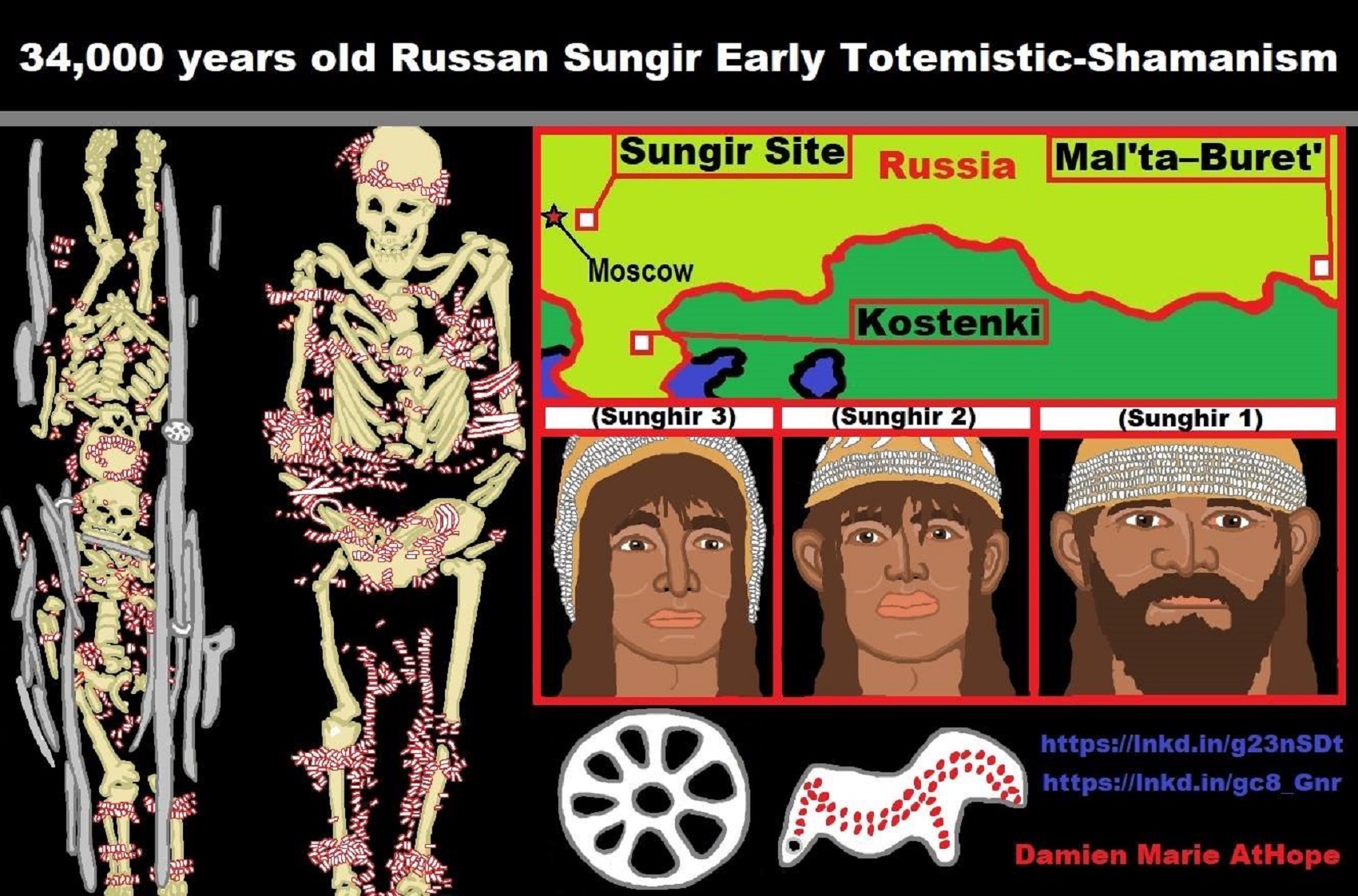
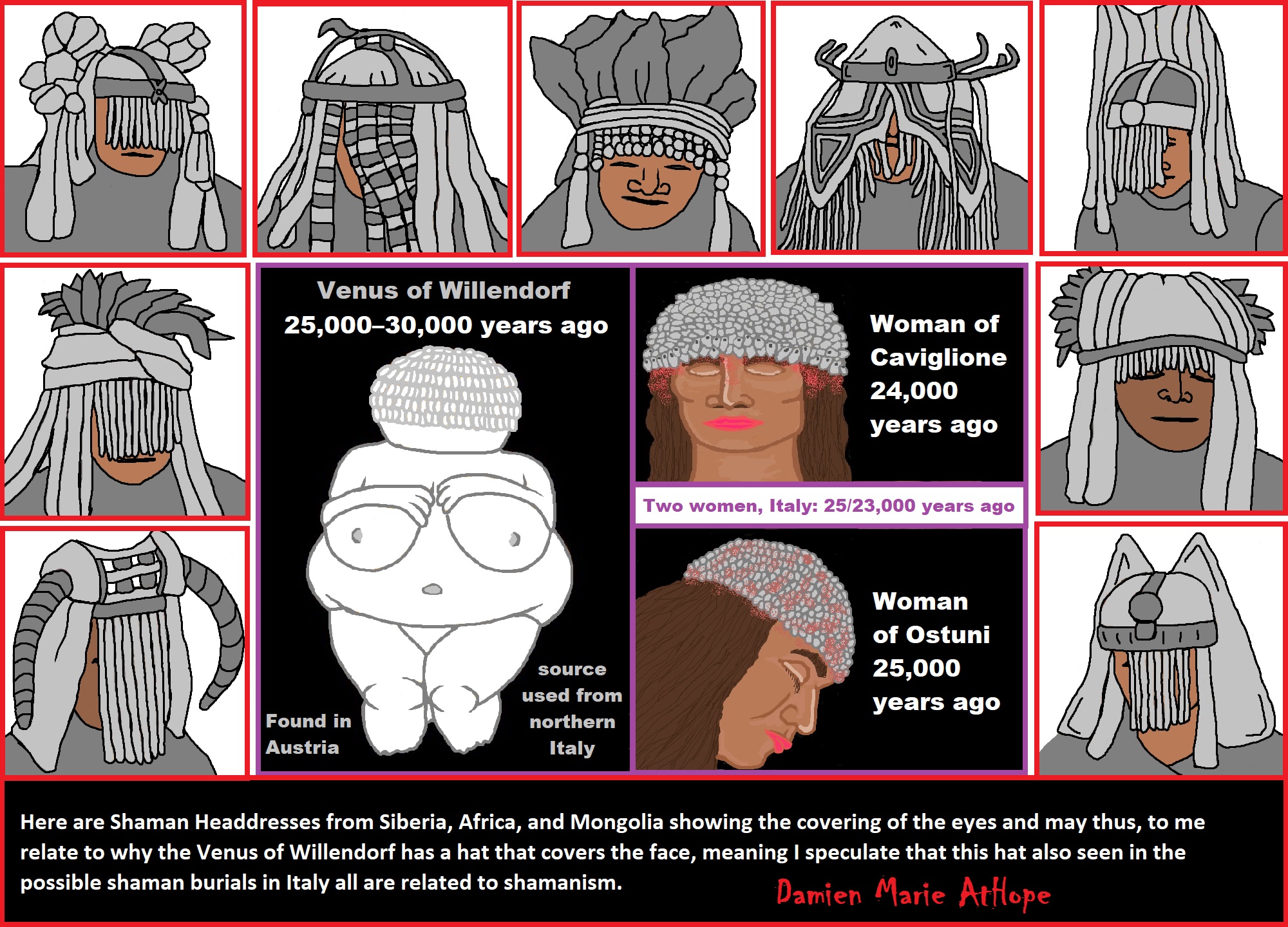
Here are Shaman Headdresses from Siberia, Africa, and Mongolia showing the covering of the eyes and may thus, to me relate to why the Venus of Willendorf has a hat that covers the face, meaning I speculate that this hat, also seen in the possible shaman burials in Italy all are related to shamanism.
Venus of Willendorf: Shamanism Headdresses that Cover the Eyes?
“Venus figurines have been unearthed in Europe, Siberia, and much of Eurasia.
Most date from the Gravettian period but start in the Aurignacian era, and lasts to the Magdalenian time.” ref
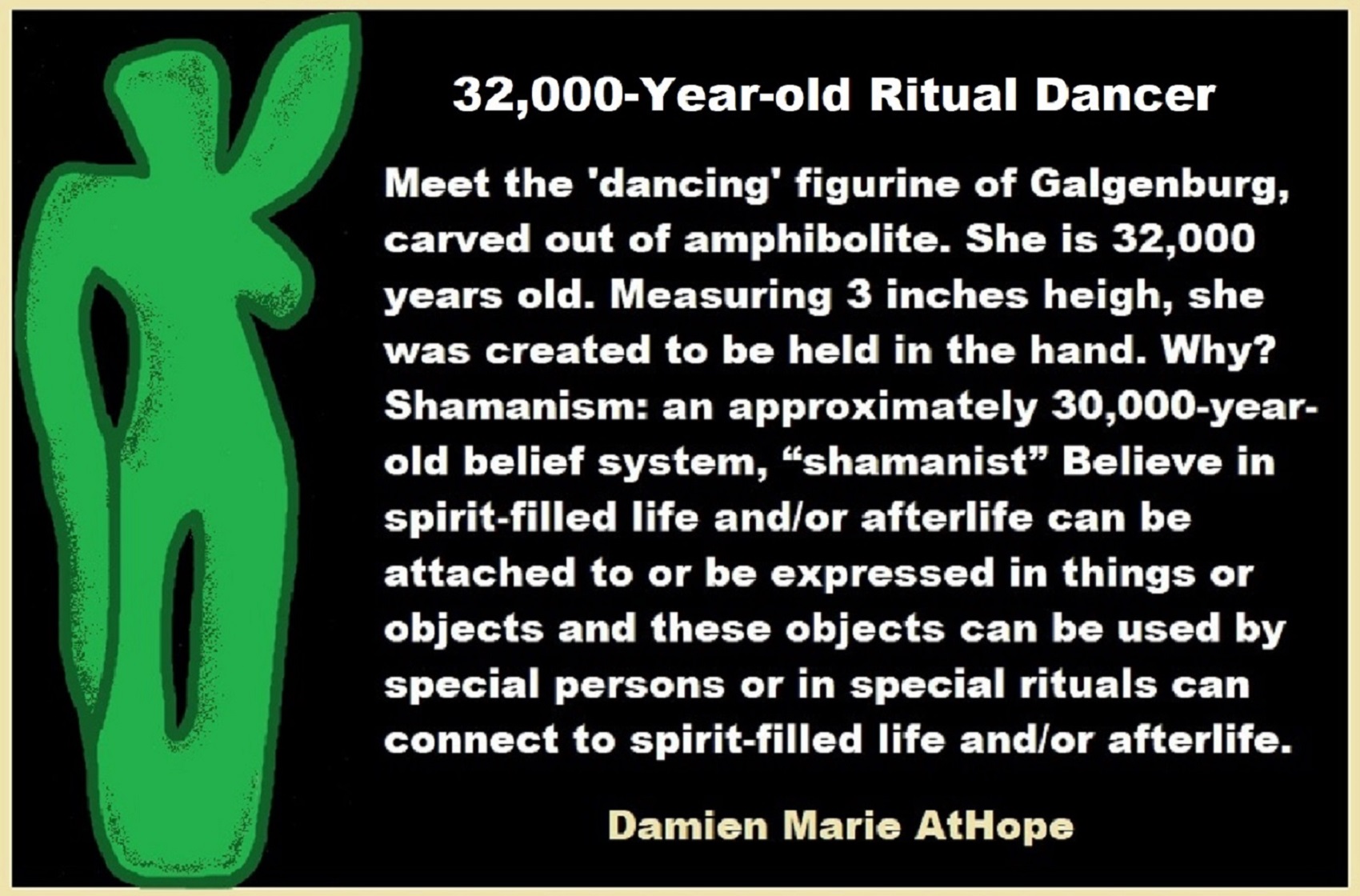
Haplogroup R possible origin in Central Asia, South Asia, or Siberia and seen in several cultures:
Mal’ta–Buret’ culture (24,000-15,000 years ago)
Afontova Gora culture (21,000-12,000 years ago)
Trialetian culture (16,000–8000 years ago)
Samara culture (7,000-6,500 years ago)
Khvalynsk culture (7,000-6,500 years ago)
Afanasievo culture (5,300-4,500 years ago)
Yamna/Yamnaya Culture (5,300-4,500 years ago)
Andronovo culture (4,000–2,900 years ago)
“Haplogroup U is a human mitochondrial DNA haplogroup (mtDNA). The clade arose from haplogroup R, likely during the early Upper Paleolithic. Basal U was found in the 26,000 years old remains of Ancient North Eurasian, Mal’ta boy (MA1 24,000 years old). Its various subclades (labelled U1–U9, diverging over the course of the Upper Paleolithic) are found widely distributed across Northern and Eastern Europe, Central, Western and South Asia, as well as North Africa, the Horn of Africa, and the Canary Islands. In a 2013 study, all but one of the ancient modern human sequences from Europe belonged to maternal haplogroup U, thus confirming previous findings that haplogroup U was the dominant type of Mitochondrial DNA (mtDNA) in Europe before the spread of agriculture into Europe and the presence and the spread of the Indo-Europeans in Western Europe. The age of U5 is estimated at between 25,000 and 35,000 years old, roughly corresponding to the Gravettian culture. Approximately 11% of Europeans (10% of European-Americans) have some variant of haplogroup U5. U5 was the predominant mtDNA of mesolithic Western Hunter Gatherers (WHG).” ref
“U5 has been found in human remains dating from the Mesolithic in England, Germany, Lithuania, Poland, Portugal, Russia, Sweden, France and Spain. Neolithic skeletons (around 7,000 years old or so) that were excavated from the Avellaner cave in Catalonia, northeastern Spain included a specimen carrying haplogroup U5. Haplogroup U5 and its subclades U5a and U5b today form the highest population concentrations in the far north, among Sami, Finns, and Estonians. However, it is spread widely at lower levels throughout Europe. This distribution, and the age of the haplogroup, indicate individuals belonging to this clade were part of the initial expansion tracking the retreat of ice sheets from Europe around 10,000 years ago. U5b1b: has been found in Saami of Scandinavia, Finnish and the Berbers of North Africa, which were found to share an extremely young branch, aged merely around 9,000 years old or so. U5b1b was also found in Fulbe and Papel people in Guinea-Bissau and Yakuts people of northeastern Siberia. It arose around 11,000 years ago.” ref
Gravettian Culture “last European culture many consider unified” (33/35,000–24/20,000 years ago). Which Damien thinks expresses the first earliest shamanism. https://en.wikipedia.org/wiki/Gravettian
Pavlovian Culture “variant of the Gravettian” as seen in Czech Republic, Austria, and Poland (29,000–25,000 years ago). Which Damien thinks expresses the earliest burial of a shaman. https://en.wikipedia.org/wiki/Pavlovian_culture
Epigravettian Culture (Greek: epi “above, on top of”, and Gravettian, because they likely continued a lot of the Gravettian Culture) as seen in Southern and Eastern Europe (20,000–10,000 years ago) Which Damien thinks may have brought/influenced the people in the Middle East/Turkey to add belief in goddesses and female art/figurine themes to their early paganism emerging out or older shamanism 11,000/10,000 years ago. https://en.wikipedia.org/wiki/Epigravettian
Magdalenian Culture as seen in Western Europe: “The earliest Magdalenian sites are in France and the Epigravettian is a similar culture appearing around the same time” (17,000–12,000 years ago) Which Damien thinks started to evolve Western Eurasian shamanism. https://en.wikipedia.org/wiki/Magdalenian
“The Magdalenian constitutes a civilization in the full meaning of the term, with its unique metaphysics, social rules, exchanges codified with nature via its art and weaponry. Before any climatic improvement then, daring was enough to both distinguish these populations from those that disappeared on a European scale and to invent facultative weapons, a conquering mythology, appropriate displacements, episodic ruptures, long-distance relays, flexibility in control over all kinds of environments, ritual delegation by shamanism, the “descent” of mythical decoration of rock walls in favor of mobile supports, such as modern crucifixes or portable altars.” https://www.sciencedirect.com/science/article/abs/pii/S1040618212001450
The Evidence of Shamanism Rituals in Early Prehistoric Periods of Europe and Anatolia
“Shamanism Rituals in Palaeolithic Siberian shamans (Eastern Eurasian Shamanism) believe that shamanism emerged in the period when hunting and gathering was the main means to support. Ethnographic evidence suggests that hunter-gatherer groups would have seen the environment as giving and reciprocating, and that their spirit worlds would have consisted largely of animals and natural features with which shaman-like figures may have mediated. From this point of view, it is best to begin investigating prehistoric shamanism in Palaeolithic rituals and related cave paintings of Europe. The shamanic hypothesis that cave art is based on a fusion of direct evidence from the caves themselves with observations of more recent hunter-gatherer societies that still produce rock art. However, not all cultures have specific shamanic ritual locations, and even when they are present, shamans will perform some rituals away from them. Ritual areas are typically viewed as the literal doorway between the spiritual and physical worlds, and are often an opening into the earth, like caves or springs, or elevated spaces such as mountains and even caves in mountains.” ref
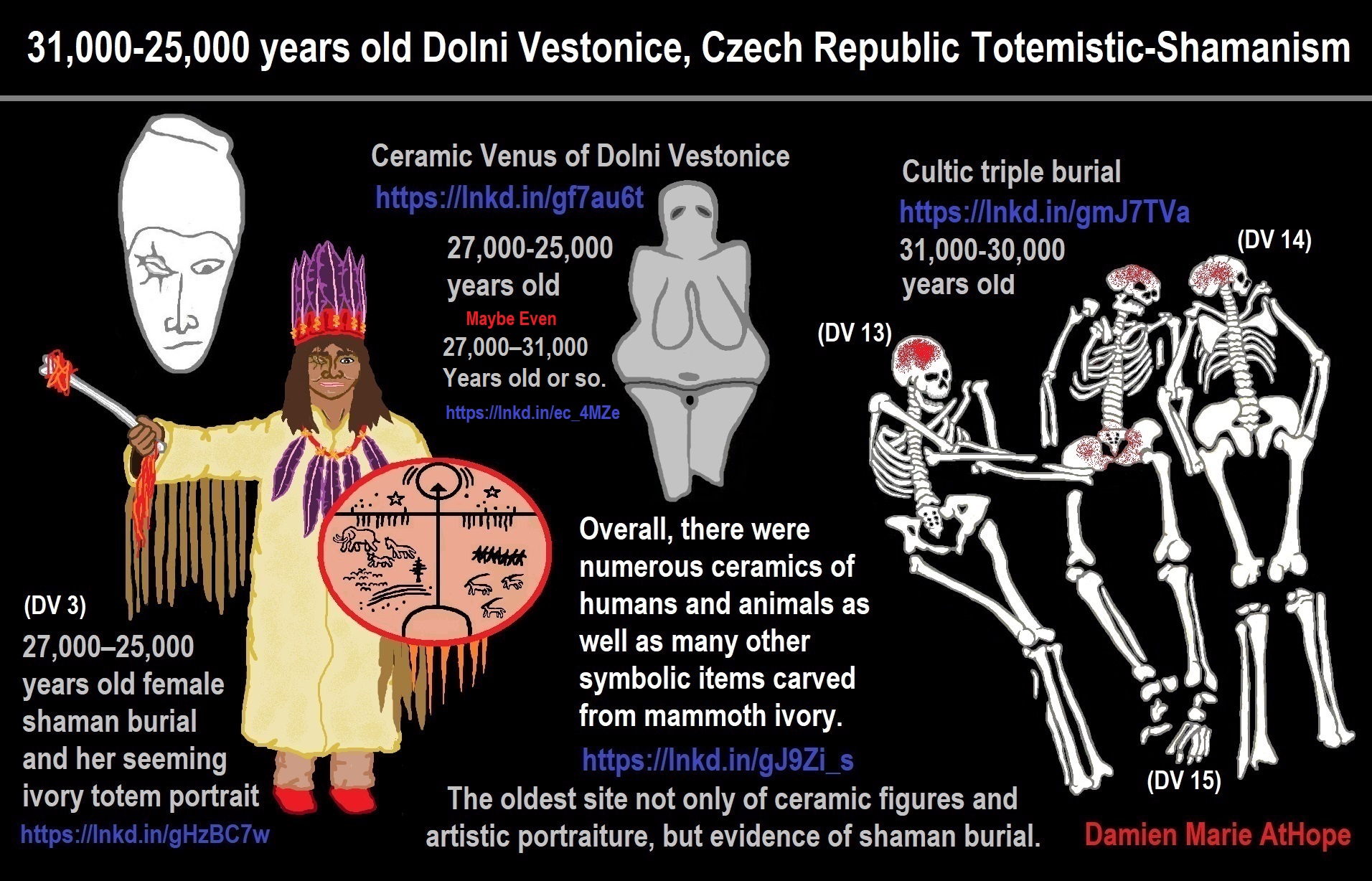

ref, ref, ref, ref, ref, ref, ref, ref, ref, ref, ref, ref
“Aurignacian (43,000 to 26,000 years ago), Gravettian (33,000 to 21,000 years ago), Magdalenian (17,000 to 12,000 years ago), and Sami (Haplogroup N Y-DNA) at least by 3,500 years ago until the fifteenth century) were all nomadic peoples of Ancient Europe. N1c correlates closely with the distribution of the Finno-Ugrian languages. The Sami languages are thought to have split from their common ancestor about 3300 years ago.” ref, ref
“Mitochondrial DNA studies of Sami people, haplogroup U5 are consistent with multiple migrations to Scandinavia from Volga-Ural region, starting 6,000 to 7,000 years before present.” ref
“Nearly half of all Sami and one-fifth of Finnish maternal lineages belong to U5. U5 arrived in Europe with the Gravettian and appears to have been a major maternal lineage among the Paleolithic European hunter-gatherers and even the dominant lineage during the European Mesolithic at more than 80%. Among 16 Gravettian samples, six belonged to U5.” ref
“U5b1b1 arose approximately 10,000 years ago, over two millennia after the end of the Last Glaciation, when the Neolithic Revolution was already underway in the Near East. Despite this relatively young age, U5b1b1 is found scattered across all of Europe and well beyond its boundaries. The Saami, who live in the far European North and have 48% of U5 and 42% of V lineages, belong exclusively to the U5b1b1 subclade. Amazingly, the Berbers of Northwest Africa also possess that U5b1b1 subclade and haplogroup V. How could two peoples separated by some 6,000 km (3,700 mi) share such close maternal ancestry? The Berbers also have other typically Western European lineages such as H1 and H3, as well as African haplogroups like M1, L1, L2, and L3. The Saami and the Berbers presumably descend from nomadic hunter-gatherers from the Franco-Cantabrian refugium who recolonized Europe and North Africa after the LGM.” ref
“The journey of U5b1b1 didn’t stop there. The Fulbe of Senegal were also found to share U5b1b1b with the Berbers, surely through intermarriages. More impressively, the Yakuts of eastern Siberia, who have a bit under 10% of European mtDNA (including haplogroups H, HV1, J, K, T, U4, U5, and W), also share the exact same deep subclade (U5b1b1a) as the Saami and the Berbers.” ref
Genetic Studies on Sami
“Genetic studies on Sami are the genetic research that has been carried out on the Sami people. The Sami languages belong to the Uralic languages family of Eurasia. Siberian origins are still visible in the Sámi, Finns, and other populations of the Finno-Ugric language family. An abundance of genes has journeyed all the way from Siberia to Finland, a recent study indicates. As late as the Iron Age, people with a genome similar to that of the Sámi people lived much further south in Finland compared to today. The first study on the DNA of the ancient inhabitants of Finland has been published, with results indicating that a copious number of Siberian genetic variants are present in modern Sami populations.” ref
“Genetic material from remains associated with Western Siberian hunter-gatherers has been found in the inhabitants of the Kola Peninsula from as far back as approximately 4,000 years ago, later spreading also to Finland. The study also corroborates the assumption that people genetically similar to the Sámi lived much further south than currently. The Western Siberian hunter-gatherers (WSHG) themselves harbored about 30% EHG (Eastern European Hunter-Gatherers) ancestry, 50% ANE (Ancient North Eurasian) ancestry, and 20% East Asian ancestry, therefore mostly European-related ancestry, and also resembled the earlier Botai samples of northern Central Asia. The genetic samples compared in the study were collected from human bones found in a 3,500-year-old burial place in the Kola Peninsula and the 1,500-year-old lake burial site at Levänluhta in South Ostrobothnia, Finland. All of the samples contained identical Siberian genes.” ref
Sami Y-DNA
“Three Y chromosome haplogroups dominate the distribution among the Sami: N1c (formerly N3a), I1 – today is more commonly known as I-M253 – and R1a, at least in the study carried out by K. Tambets et al. in 2004. The most common haplogroup among the Sami is N1c, with I1 as a close second according to that study. Haplogroup R1a in Sami is mostly seen in the Swedish Sami and Kola Sami populations, with a low level among the Finnish Sami according to Tambets and colleagues, a finding that suggests that N1c and R1a probably reached Fennoscandia from eastern Europe, where these haplogroups can be found in high frequencies. In Finland, there is also a general difference within the Finnish population between eastern and western Finland, where the eastern show a dominance of N-haplogroup and the west a dominance of I-haplogroup, where the latter is explained by a migration from southern parts of today’s Norway and Sweden over to Finland as we know it today.” ref
“But the spread of R1a-haplogroup amongst Sami in Sweden shows a big span from 10.1% to 36.0%, with an average of 20%, to be compared with Sami in Finland with a span from 9% to 9.9% Because Sami groups in Sweden show differences between haplogroups – such as U5b and V even thought that are mtDNA-groups – in the south of Sweden and in the north of the country (see below), the spread of Y-haplogroups such as R1a amongst groups of Sami in Sweden might be significant as well. No such study has yet been done though.” ref
“However the two haplogroups R1a and N1c have a distinctly distribution when it comes to linguistics. R1a is common among Eastern Europeans speaking Indo-European languages, while N1c correlates closely with the distribution of the Finno-Ugrian languages. For example, N1c is common among the Finns, while haplogroup R1a is common among all the neighbours of the Sami.” ref
“Haplogroup I1 is the most common haplogroup in Sweden, and the Jokkmokk Sami in Sweden have a similar structure to Swedes and Finns for haplogroup I1 and N1c. Haplogroup I-M253 in Sami is explained by immigration (of men) during the 14th century. That is quite late in Sami history bearing in mind that an distinctive Sami culture can be traced and first observed back to 1000 BCE. The Sami languages are thought to have split from their common ancestor about 3300 years ago.” ref
Sami mtDNA
“Classification of the Sami mtDNA lineages revealed that the majority are clustered in a subset of the European mtDNA pool. The two haplogroups V and U5b dominate, between them accounting for about 89% of the total. This gives the Sami regions the highest level of Haplogroups V and U5b thus far found. Both haplogroups V and U5b are spread at moderate frequencies across Europe, from Iberia to the Ural Mountains. Haplogroups H, D5, and Z represent most of the remaining averaged total. Overall 98% of the Sami mtDNA pool is encompassed within haplogroups V, U5b, H, Z, and D5. Local frequencies among the Sami vary.” ref
“The divergence time for the Sami haplogroup V sequences was estimated by Max Ingman and Ulf Gyllensten at 7600 YBP (years before present), and for U5b1b1 as 5500 YBP amongst Sami and 6600 YBP amongst Sami and Finns. This suggests to them an arrival in the region soon after the retreat of the glacial ice. Other research on Sami shows that most of them do not belong to the mtDNA Haplogroup I (not to be confused for the aforementioned paternal Haplogroup I-M170) that is shared by many Finnic peoples.” ref
Sami U5b
“The great majority of Sami belong to U5b Haplogroup U (mtDNA) even though a small proportion falls into U4. The percentage of total Sami mtDNA samples tested by K. Tambets and her colleagues (published in 2004) which were U5b ranged from 56.8% in Norwegian Sami to 26.5% in Swedish Sami. In research made by M. Ingman and U. Gyllensten in 2006 is a slightly different setting shown: Norwegian Sami belongs to U5b as well as U5b1b1 to 56.8%, Finnish Sami with 40.6%, Northern Sami in Sweden to 35.5% and Southern Sami in Sweden within reindeer herding to 23.9% while Southern Sami in Sweden outside of reindeer herding/other occupation belong to U5b to 16.3% and to U5b1b1 to 12%.” ref
“Sami U5b falls into subclade U5b1b1. The Sami U5b1b1 sub-clade is present in many different populations, e.g. 3% or higher frequencies in Karelia, Finland, and Northern-Russia. The Sami U5b1 motif is additionally found in very low frequencies for instance in the Caucasus region, however this is explained as recent migration from Europe. However, 38% of the Sami U5b1b1 mtDNAs have haplotype so far exclusive to the Sami, containing a transition at np 16148. Alessandro Achilli and colleagues noted that the Sami and the Berbers share U5b1b, which they estimated at 9,000 years old, and argued that this provides evidence for a radiation of the haplogroup from the Franco-Cantabrian refuge area of southwestern Europe.” ref
“M. Engman’s and U. Gyllensten’s studie on mtDNA amongst Sami in Scandinavia also reveals that haplogroup H is 15.2% within the Sami traditional group in the south of Sweden, and 34.8% amongst Southern Sami in Sweden, and as high as 44.6% amongst Southern non-traditional Sami in Sweden, but just 2.6% amongst Northern Sami in Sweden, and 2.9 within the Sami group in Finland and amongst Sami in Norway to 4.7%. That result points in the direction that South Sami in Sweden have been more exposed to and/or intermarried the continental European haplogroup H earlier, and much more frequent, than Sami in the north of Sweden, in Finland and in Norway, which can be explained by Scandinavian/Swedish settlers that migrated into Southern Sami areas in Sweden from areas like Mälardalen.” ref
Sami V
“The divergence time for the Sami haplogroup V sequences is estimated by M. Ingman and U. Gyllensten at 7,600 years ago. But there is a difference within the Sami group in Sweden according to their study. North Sami (Sami in the North of Swedish Lapland) belong to haplogroup V with 58.6% and South Sami (Sami in the South of Swedish Lapland) within reindeer herding to 37.0% and South Sami outside reindeer herding/other occupation to 8.7%. That can be compared with Sami in Norway that has a 33.1% belonging to haplogroup V and Sami in Finland to 37.7%. Sami in Finland and South Sami within reeinder herding in Sweden have the same percentage belonging to haplogroup V.” ref
“But according to K. Tambets’ et al. study is haplogroup V the most frequent haplogroup in the Swedish Sami and is present at significantly lower frequencies in Norwegian and Finnish subpopulations. Note though, that in the study made by K. Tambet’s et al. has no differentiation between Sami in the north and the south of Sweden been made, which otherwise probably would change the outcome of their study. Torroni and colleagues have suggested that the spread of haplogroup V in Scandinavia and in eastern Europe is due to its late Pleistocene/early Holocene expansion from a Franco-Cantabrian glacial refugium.” ref
“However subsequent studies found that haplogroup V is also significantly present in eastern Europeans. Furthermore, haplogroup V lineages with HVS-I transitions 16153 and 16298 that are frequent in the Sami population are much more widespread in eastern than in western Europe. So haplogroup V might have reached Fennoscandia via central/eastern Europe. Such a scenario is indirectly supported by the absence, among the Sami, of the pre-V mtDNAs that are characteristic of southwestern Europeans and northwestern Africans.” ref
Sami Z
“Haplogroup Z is found at low frequency in the Sami and Northern Asian populations but is virtually absent in Europe. Several conserved substitutions group the Sami Z lineages with those from Finland and the Volga-Ural region of Russia. The estimated dating of the lineage at 2700 years suggests a small, relatively recent contribution of people from the Volga-Ural region to the Sami population.” ref
“Haplogroup Z is most frequent in Northeastern Asia. It is also present in Siberian populations as well as in the region of Volga-Ural, as just mentioned. Subhaplogroup Z1 is present in lineages in Western Asia and Northern Europe as well as in the Koryak and Itel’men populations. Interestingly enough is haplogroup Z most frequent amongst maritim Koryaks with just a bit over 10%, but is not at all present in reindeer-herding Koryaks. The Itel’men and Koryak populations live on the Kamchatka peninsula, the former in the south and the latter in the very north.” ref
“In Sámi shamanism, the noaidi used the drum to get into a trance, or to obtain information from the future, or other realms. The drum was held in one hand, and beaten with the other. While the noaidi was in trance, his “free spirit” was said to leave his body to visit the spirit-world. When used for divination, the drum was beaten with a drum hammer; a vuorbi (‘index’ or ‘pointer’), a kind of die made of brass or horn, would move around on the drumhead when the drum was struck. Future events would be predicted according to the symbols upon which the vuorbi stopped on the membrane.
The patterns on the drum membrane reflect the worldview of the owner and his family, both in religious and worldly matters, such as reindeer herding, hunting, householding, and relations with their neighbors and the non-Sámi community.” ref
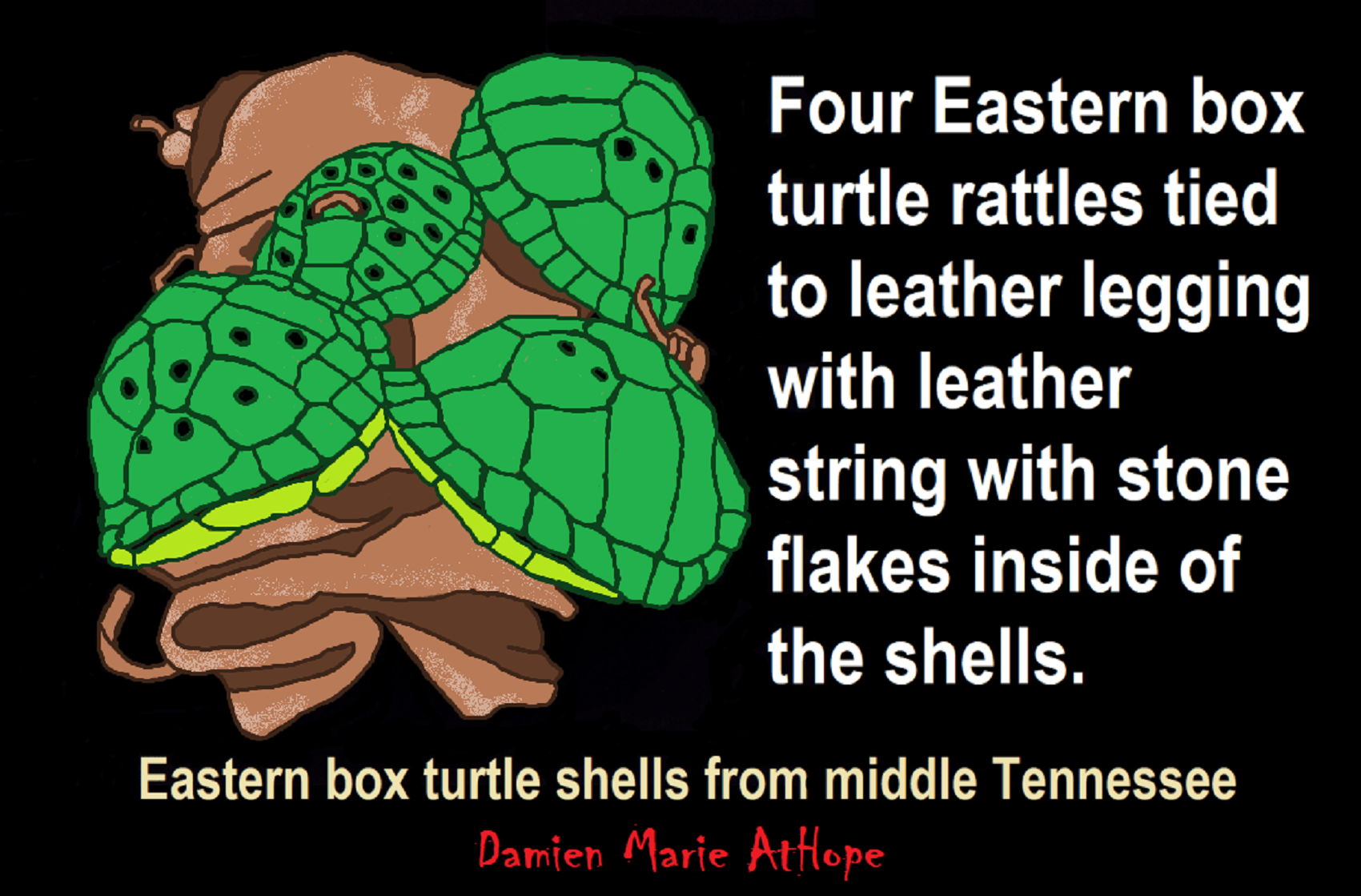
Oracle bone script
“Oracle bone script (Chinese: 甲骨文) was an ancestor of modern Chinese characters engraved on oracle bones—animal bones or turtle plastrons used in pyromantic divination—in the late 2nd millennium BCE, and is the earliest known form of Chinese writing. The vast majority, amounting to about 150,000 pieces, were found at the Yinxu site located in Xiaotun Village, Anyang City, Henan Province. The latest significant discovery is the Huayuanzhuang storage of 1,608 pieces, 579 of which were inscribed, found near Xiaotun in 1993. They record pyromantic divinations of the last nine kings of the Shang dynasty,[a] beginning with Wu Ding, whose accession is dated by different scholars at 1250 or 1200 BCE. After the Shang were overthrown by the Zhou dynasty in c. 1046 BCE, divining with milfoil became more common, and a much smaller corpus of oracle bone writings date from the Western Zhou. Thus far, no Zhou sites have been found with a cache of inscriptions on the same scale as that at Yinxu, although inscribed oracle bones appear to be more widespread, being found near most major population centers of the time, and new sites have continued to be discovered since 2000.” ref
“The late Shang oracle bone writings, along with a few roughly contemporaneous inscriptions in a different style cast in bronzes, constitute the earliest significant corpus of Chinese writing, which is essential for the study of Chinese etymology, as Shang writing is directly ancestral to the modern Chinese script. It is the oldest known member and ancestor of the Chinese family of scripts, preceding the bronzeware script and making it the direct ancestor of over a dozen East Asian writing systems developed over the next three millennia, including the Chinese and Japanese logographic and syllabaric scripts still in current use. In terms of content, the inscriptions, which range from under ten characters for incomplete prognostications to over 100 characters in rare cases (a few dozen being typical), deal with a wide range of topics, including war, ritual sacrifice, agriculture, as well as births, illnesses, and deaths in the royal family. Thus, they provide invaluable insight into the late Shang dynasty civilization and society.” ref
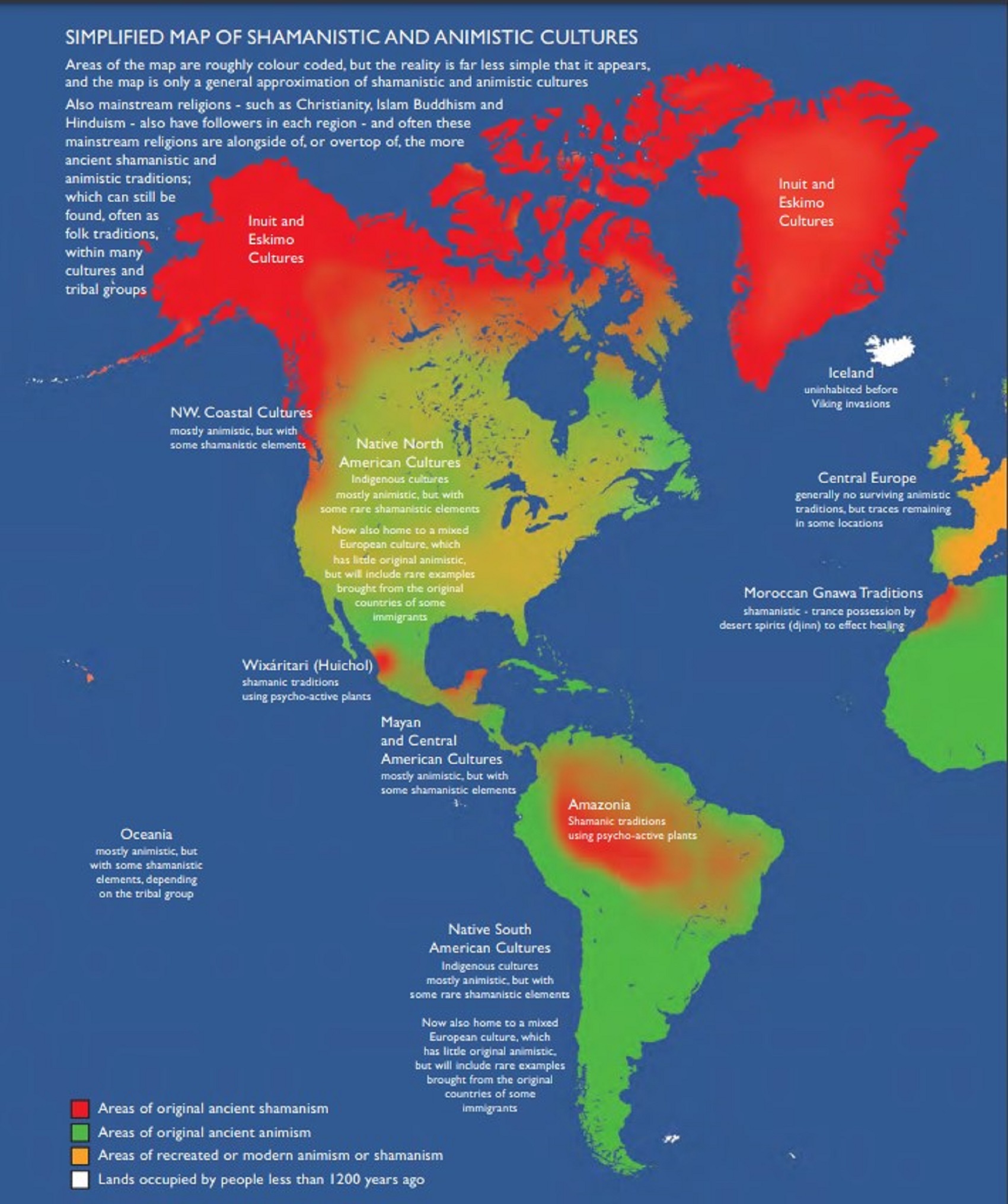
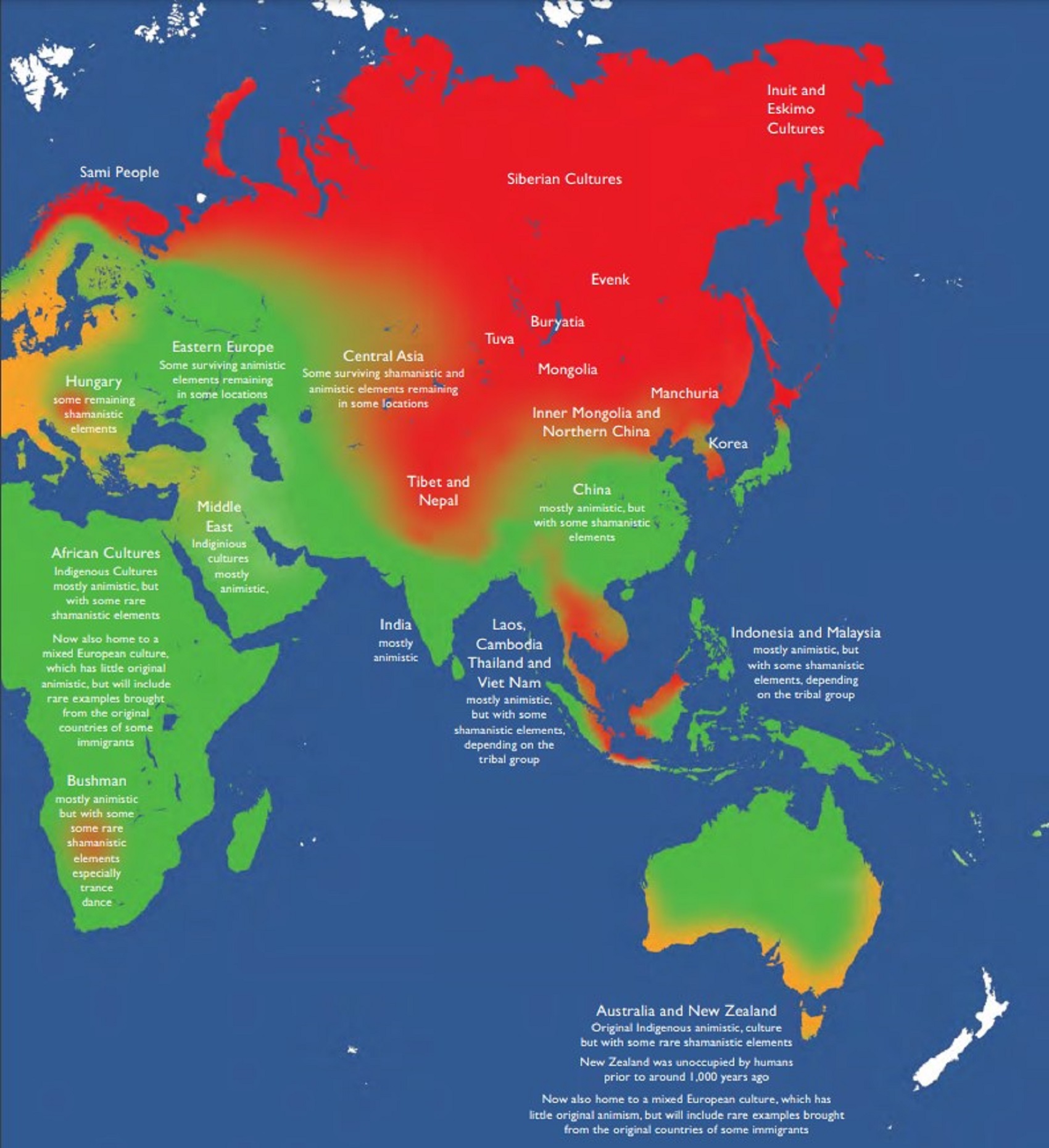
Shamanistic and Animistic Cultures map by “The Shamanism Magazine” (http://SacredHoop.org)
https://sacredhoop.org/Free-Guide-To-Shamanism/Sacred-Hoop-Free-Guide-To-Shamanism.pdf

People don’t commonly teach religious history, even that of their own claimed religion. No, rather they teach a limited “pro their religion” history of their religion from a religious perspective favorable to the religion of choice.

Do you truly think “Religious Belief” is only a matter of some personal choice?
Do you not see how coercive one’s world of choice is limited to the obvious hereditary belief, in most religious choices available to the child of religious parents or caregivers? Religion is more commonly like a family, culture, society, etc. available belief that limits the belief choices of the child and that is when “Religious Belief” is not only a matter of some personal choice and when it becomes hereditary faith, not because of the quality of its alleged facts or proposed truths but because everyone else important to the child believes similarly so they do as well simply mimicking authority beliefs handed to them. Because children are raised in religion rather than being presented all possible choices but rather one limited dogmatic brand of “Religious Belief” where children only have a choice of following the belief as instructed, and then personally claim the faith hereditary belief seen in the confirming to the belief they have held themselves all their lives. This is obvious in statements asked and answered by children claiming a faith they barely understand but they do understand that their family believes “this or that” faith, so they feel obligated to believe it too. While I do agree that “Religious Belief” should only be a matter of some personal choice, it rarely is… End Hereditary Religion!

Animism: Respecting the Living World by Graham Harvey
“How have human cultures engaged with and thought about animals, plants, rocks, clouds, and other elements in their natural surroundings? Do animals and other natural objects have a spirit or soul? What is their relationship to humans? In this new study, Graham Harvey explores current and past animistic beliefs and practices of Native Americans, Maori, Aboriginal Australians, and eco-pagans. He considers the varieties of animism found in these cultures as well as their shared desire to live respectfully within larger natural communities. Drawing on his extensive casework, Harvey also considers the linguistic, performative, ecological, and activist implications of these different animisms.” ref

We are like believing machines we vacuum up ideas, like Velcro sticks to almost everything. We accumulate beliefs that we allow to negatively influence our lives, often without realizing it. Our willingness must be to alter skewed beliefs that impend our balance or reason, which allows us to achieve new positive thinking and accurate outcomes.

My thoughts on Religion Evolution with external links for more info:
- (Pre-Animism Africa mainly, but also Europe, and Asia at least 300,000 years ago), (Pre-Animism – Oxford Dictionaries)
- (Animism Africa around 100,000 years ago), (Animism – Britannica.com)
- (Totemism Europe around 50,000 years ago), (Totemism – Anthropology)
- (Shamanism Siberia around 30,000 years ago), (Shamanism – Britannica.com)
- (Paganism Turkey around 12,000 years ago), (Paganism – BBC Religion)
- (Progressed Organized Religion “Institutional Religion” Egypt around 5,000 years ago), (Ancient Egyptian Religion – Britannica.com)
- (CURRENT “World” RELIGIONS after 4,000 years ago) (Origin of Major Religions – Sacred Texts)
- (Early Atheistic Doubting at least by 2,600 years ago) (History of Atheism – Wikipedia)
“Religion is an Evolved Product” and Yes, Religion is Like Fear Given Wings…
Atheists talk about gods and religions for the same reason doctors talk about cancer, they are looking for a cure, or a firefighter talks about fires because they burn people and they care to stop them. We atheists too often feel a need to help the victims of mental slavery, held in the bondage that is the false beliefs of gods and the conspiracy theories of reality found in religions.
Understanding Religion Evolution:
- Pre-Animism (at least 300,000 years ago)
- Animism (Africa: 100,000 years ago)
- Totemism (Europe: 50,000 years ago)
- Shamanism (Siberia: 30,000 years ago)
- Paganism (Turkey: 12,000 years ago)
- Progressed organized religion (Egypt: 5,000 years ago), (Egypt, the First Dynasty 5,150 years ago)
- CURRENT “World” RELIGIONS (after 4,000 years ago)
- Early Atheistic Doubting (at least by 2,600 years ago)
“An Archaeological/Anthropological Understanding of Religion Evolution”
It seems ancient peoples had to survived amazing threats in a “dangerous universe (by superstition perceived as good and evil),” and human “immorality or imperfection of the soul” which was thought to affect the still living, leading to ancestor worship. This ancestor worship presumably led to the belief in supernatural beings, and then some of these were turned into the belief in gods. This feeble myth called gods were just a human conceived “made from nothing into something over and over, changing, again and again, taking on more as they evolve, all the while they are thought to be special,” but it is just supernatural animistic spirit-belief perceived as sacred.
Quick Evolution of Religion?
Pre-Animism (at least 300,000 years ago) pre-religion is a beginning that evolves into later Animism. So, Religion as we think of it, to me, all starts in a general way with Animism (Africa: 100,000 years ago) (theoretical belief in supernatural powers/spirits), then this is physically expressed in or with Totemism (Europe: 50,000 years ago) (theoretical belief in mythical relationship with powers/spirits through a totem item), which then enlists a full-time specific person to do this worship and believed interacting Shamanism (Siberia/Russia: 30,000 years ago) (theoretical belief in access and influence with spirits through ritual), and then there is the further employment of myths and gods added to all the above giving you Paganism (Turkey: 12,000 years ago) (often a lot more nature-based than most current top world religions, thus hinting to their close link to more ancient religious thinking it stems from). My hypothesis is expressed with an explanation of the building of a theatrical house (modern religions development). Progressed organized religion (Egypt: 5,000 years ago) with CURRENT “World” RELIGIONS (after 4,000 years ago).
Historically, in large city-state societies (such as Egypt or Iraq) starting around 5,000 years ago culminated to make religion something kind of new, a sociocultural-governmental-religious monarchy, where all or at least many of the people of such large city-state societies seem familiar with and committed to the existence of “religion” as the integrated life identity package of control dynamics with a fixed closed magical doctrine, but this juggernaut integrated religion identity package of Dogmatic-Propaganda certainly did not exist or if developed to an extent it was highly limited in most smaller prehistoric societies as they seem to lack most of the strong control dynamics with a fixed closed magical doctrine (magical beliefs could be at times be added or removed). Many people just want to see developed religious dynamics everywhere even if it is not. Instead, all that is found is largely fragments until the domestication of religion.
Religions, as we think of them today, are a new fad, even if they go back to around 6,000 years in the timeline of human existence, this amounts to almost nothing when seen in the long slow evolution of religion at least around 70,000 years ago with one of the oldest ritual worship. Stone Snake of South Africa: “first human worship” 70,000 years ago. This message of how religion and gods among them are clearly a man-made thing that was developed slowly as it was invented and then implemented peace by peace discrediting them all. Which seems to be a simple point some are just not grasping how devastating to any claims of truth when we can see the lie clearly in the archeological sites.
I wish people fought as hard for the actual values as they fight for the group/clan names political or otherwise they think support values. Every amount spent on war is theft to children in need of food or the homeless kept from shelter.
Here are several of my blog posts on history:
- To Find Truth You Must First Look
- (Magdalenian/Iberomaurusian) Connections to the First Paganists of the early Neolithic Near East Dating from around 17,000 to 12,000 Years Ago
- Natufians: an Ancient People at the Origins of Agriculture and Sedentary Life
- Possible Clan Leader/Special “MALE” Ancestor Totem Poles At Least 13,500 years ago?
- Jewish People with DNA at least 13,200 years old, Judaism, and the Origins of Some of its Ideas
- Baltic Reindeer Hunters: Swiderian, Lyngby, Ahrensburgian, and Krasnosillya cultures 12,020 to 11,020 years ago are evidence of powerful migratory waves during the last 13,000 years and a genetic link to Saami and the Finno-Ugric peoples.
- The Rise of Inequality: patriarchy and state hierarchy inequality
- Fertile Crescent 12,500 – 9,500 Years Ago: fertility and death cult belief system?
- 12,400 – 11,700 Years Ago – Kortik Tepe (Turkey) Pre/early-Agriculture Cultic Ritualism
- Ritualistic Bird Symbolism at Gobekli Tepe and its “Ancestor Cult”
- Male-Homosexual (female-like) / Trans-woman (female) Seated Figurine from Gobekli Tepe
- Could a 12,000-year-old Bull Geoglyph at Göbekli Tepe relate to older Bull and Female Art 25,000 years ago and Later Goddess and the Bull cults like Catal Huyuk?
- Sedentism and the Creation of goddesses around 12,000 years ago as well as male gods after 7,000 years ago.
- Alcohol, where Agriculture and Religion Become one? Such as Gobekli Tepe’s Ritualistic use of Grain as Food and Ritual Drink
- Neolithic Ritual Sites with T-Pillars and other Cultic Pillars
- Paganism: Goddesses around 12,000 years ago then Male Gods after 7,000 years ago
- First Patriarchy: Split of Women’s Status around 12,000 years ago & First Hierarchy: fall of Women’s Status around 5,000 years ago.
- Natufians: an Ancient People at the Origins of Agriculture and Sedentary Life
- J DNA and the Spread of Agricultural Religion (paganism)
- Paganism: an approximately 12,000-year-old belief system
- Paganism 12,000 years old: related to “Anarchism and Socialism” (Pre-Capitalism)
- Shaman burial in Israel 12,000 years ago and the Shamanism Phenomena
- Need to Mythicized: gods and goddesses
- 12,000 – 7,000 Years Ago – Paleo-Indian Culture (The Americas)
- 12,000 – 2,000 Years Ago – Indigenous-Scandinavians (Nordic)
- Norse did not wear helmets with horns?
- Pre-Pottery Neolithic Skull Cult around 11,500 to 8,400 Years Ago?
- 10,400 – 10,100 Years Ago, in Turkey the Nevail Cori Religious Settlement
- 9,000-6,500 Years Old Submerged Pre-Pottery/Pottery Neolithic Ritual Settlements off Israel’s Coast
- Catal Huyuk “first religious designed city” around 9,500 to 7,700 years ago (Turkey)
- Cultic Hunting at Catal Huyuk “first religious designed city”
- Special Items and Art as well as Special Elite Burials at Catal Huyuk
- New Rituals and Violence with the appearance of Pottery and People?
- Haplogroup N and its related Uralic Languages and Cultures
- Ainu people, Sámi people, Native Americans, the Ancient North Eurasians, and Paganistic-Shamanism with Totemism
- Ideas, Technology and People from Turkey, Europe, to China and Back again 9,000 to 5,000 years ago?
- First Pottery of Europe and the Related Cultures
- 9,000 years old Neolithic Artifacts Judean Desert and Hills Israel
- 9,000-7,000 years-old Sex and Death Rituals: Cult Sites in Israel, Jordan, and the Sinai
- 9,000-8500 year old Horned Female shaman Bad Dürrenberg Germany
- Neolithic Jewelry and the Spread of Farming in Europe Emerging out of West Turkey
- 8,600-year-old Tortoise Shells in Neolithic graves in central China have Early Writing and Shamanism
- Swing of the Mace: the rise of Elite, Forced Authority, and Inequality begin to Emerge 8,500 years ago?
- Migrations and Changing Europeans Beginning around 8,000 Years Ago
- My “Steppe-Anatolian-Kurgan hypothesis” 8,000/7,000 years ago
- Around 8,000-year-old Shared Idea of the Mistress of Animals, “Ritual” Motif
- Pre-Columbian Red-Paint (red ochre) Maritime Archaic Culture 8,000-3,000 years ago
- 7,522-6,522 years ago Linear Pottery culture which I think relates to Arcane Capitalism’s origins
- Arcane Capitalism: Primitive socialism, Primitive capital, Private ownership, Means of production, Market capitalism, Class discrimination, and Petite bourgeoisie (smaller capitalists)
- 7,500-4,750 years old Ritualistic Cucuteni-Trypillian culture of Moldova, Romania, and Ukraine
- Roots of a changing early society 7,200-6,700 years ago Jordan and Israel
- Agriculture religion (Paganism) with farming reached Britain between about 7,000 to 6,500 or so years ago and seemingly expressed in things like Western Europe’s Long Barrows
- My Thoughts on Possible Migrations of “R” DNA and Proto-Indo-European?
- “Millet” Spreading from China 7,022 years ago to Europe and related Language may have Spread with it leading to Proto-Indo-European
- Proto-Indo-European (PIE), ancestor of Indo-European languages: DNA, Society, Language, and Mythology
- The Dnieper–Donets culture and Asian varieties of Millet from China to the Black Sea region of Europe by 7,022 years ago
- Kurgan 6,000 years ago/dolmens 7,000 years ago: funeral, ritual, and other?
- 7,020 to 6,020-year-old Proto-Indo-European Homeland of Urheimat or proposed home of their Language and Religion
- Ancient Megaliths: Kurgan, Ziggurat, Pyramid, Menhir, Trilithon, Dolman, Kromlech, and Kromlech of Trilithons
- The Mytheme of Ancient North Eurasian Sacred-Dog belief and similar motifs are found in Indo-European, Native American, and Siberian comparative mythology
- Elite Power Accumulation: Ancient Trade, Tokens, Writing, Wealth, Merchants, and Priest-Kings
- Sacred Mounds, Mountains, Kurgans, and Pyramids may hold deep connections?
- Between 7,000-5,000 Years ago, rise of unequal hierarchy elite, leading to a “birth of the State” or worship of power, strong new sexism, oppression of non-elites, and the fall of Women’s equal status
- Paganism 7,000-5,000 years old: related to “Anarchism and Socialism” (Capitalism) (World War 0) Elite & their slaves
- Hell and Underworld mythologies starting maybe as far back as 7,000 to 5,000 years ago with the Proto-Indo-Europeans?
- The First Expression of the Male God around 7,000 years ago?
- White (light complexion skin) Bigotry and Sexism started 7,000 years ago?
- Around 7,000-year-old Shared Idea of the Divine Bird (Tutelary and/or Trickster spirit/deity), “Ritual” Motif
- Nekhbet an Ancient Egyptian Vulture Goddess and Tutelary Deity
- 6,720 to 4,920 years old Ritualistic Hongshan Culture of Inner Mongolia with 5,000-year-old Pyramid Mounds and Temples
- First proto-king in the Balkans, Varna culture around 6,500 years ago?
- 6,500–5,800 years ago in Israel Late Chalcolithic (Copper Age) Period in the Southern Levant Seems to Express Northern Levant Migrations, Cultural and Religious Transfer
- KING OF BEASTS: Master of Animals “Ritual” Motif, around 6,000 years old or older…
- Around 6000-year-old Shared Idea of the Solid Wheel & the Spoked Wheel-Shaped Ritual Motif
- “The Ghassulian Star,” a mysterious 6,000-year-old mural from Jordan; a Proto-Star of Ishtar, Star of Inanna or Star of Venus?
- Religious/Ritual Ideas, including goddesses and gods as well as ritual mounds or pyramids from Northeastern Asia at least 6,000 years old, seemingly filtering to Iran, Iraq, the Mediterranean, Europe, Egypt, and the Americas?
- Maykop (5,720–5,020 years ago) Caucasus region Bronze Age culture-related to Copper Age farmers from the south, influenced by the Ubaid period and Leyla-Tepe culture, as well as influencing the Kura-Araxes culture
- 5-600-year-old Tomb, Mummy, and First Bearded Male Figurine in a Grave
- Kura-Araxes Cultural 5,520 to 4,470 years old DNA traces to the Canaanites, Arabs, and Jews
- Minoan/Cretan (Keftiu) Civilization and Religion around 5,520 to 3,120 years ago
- Evolution Of Science at least by 5,500 years ago
- 5,500 Years old birth of the State, the rise of Hierarchy, and the fall of Women’s status
- “Jiroft culture” 5,100 – 4,200 years ago and the History of Iran
- Stonehenge: Paganistic Burial and Astrological Ritual Complex, England (5,100-3,600 years ago)
- Around 5,000-year-old Shared Idea of the “Tree of Life” Ritual Motif
- Complex rituals for elite, seen from China to Egypt, at least by 5,000 years ago
- Around 5,000 years ago: “Birth of the State” where Religion gets Military Power and Influence
- The Center of the World “Axis Mundi” and/or “Sacred Mountains” Mythology Could Relate to the Altai Mountains, Heart of the Steppe
- Progressed organized religion starts, an approximately 5,000-year-old belief system
- China’s Civilization between 5,000-3,000 years ago, was a time of war and class struggle, violent transition from free clans to a Slave or Elite society
- Origin of Logics is Naturalistic Observation at least by around 5,000 years ago.
- Paganism 5,000 years old: progressed organized religion and the state: related to “Anarchism and Socialism” (Kings and the Rise of the State)
- Ziggurats (multi-platform temples: 4,900 years old) to Pyramids (multi-platform tombs: 4,700 years old)
- Did a 4,520–4,420-year-old Volcano In Turkey Inspire the Bible God?
- Finland’s Horned Shaman and Pre-Horned-God at least 4,500 years ago?
- 4,000-year-Old Dolmens in Israel: A Connected Dolmen Religious Phenomenon?
- Creation myths: From chaos, Ex nihilo, Earth-diver, Emergence, World egg, and World parent
- Bronze Age “Ritual” connections of the Bell Beaker culture with the Corded Ware/Single Grave culture, which were related to the Yamnaya culture and Proto-Indo-European Languages/Religions
- Low Gods (Earth/ Tutelary deity), High Gods (Sky/Supreme deity), and Moralistic Gods (Deity enforcement/divine order)
- The exchange of people, ideas, and material-culture including, to me, the new god (Sky Father) and goddess (Earth Mother) religion between the Cucuteni-Trypillians and others which is then spread far and wide
- Koryaks: Indigenous People of the Russian Far East and Big Raven myths also found in Tlingit, Haida, Tsimshian, and other Indigenous People of North America
- 42 Principles Of Maat (Egyptian Goddess of the justice) around 4,400 years ago, 2000 Years Before Ten Commandments
- “Happy Easter” Well Happy Eostre/Ishter
- 4,320-3,820 years old “Shimao” (North China) site with Totemistic-Shamanistic Paganism and a Stepped Pyramid
- 4,250 to 3,400 Year old Stonehenge from Russia: Arkaim?
- 4,100-year-old beaker with medicinal & flowering plants in a grave of a woman in Scotland
- Early European Farmer ancestry, Kelif el Boroud people with the Cardial Ware culture, and the Bell Beaker culture Paganists too, spread into North Africa, then to the Canary Islands off West Africa
- Flood Accounts: Gilgamesh epic (4,100 years ago) Noah in Genesis (2,600 years ago)
- Paganism 4,000 years old: related to “Anarchism and Socialism” (First Moralistic gods, then the Origin time of Monotheism)
- When was the beginning: TIMELINE OF CURRENT RELIGIONS, which start around 4,000 years ago.
- Early Religions Thought to Express Proto-Monotheistic Systems around 4,000 years ago
- Kultepe? An archaeological site with a 4,000 years old women’s rights document.
- Single God Religions (Monotheism) = “Man-o-theism” started around 4,000 years ago with the Great Sky Spirit/God Tiān (天)?
- Confucianism’s Tiān (Shangdi god 4,000 years old): Supernaturalism, Pantheism or Theism?
- Yes, Your Male God is Ridiculous
- Mythology, a Lunar Deity is a Goddess or God of the Moon
- Sacred Land, Hills, and Mountains: Sami Mythology (Paganistic Shamanism)
- Horse Worship/Sacrifice: mythical union of Ruling Elite/Kingship and the Horse
- The Amorite/Amurru people’s God Amurru “Lord of the Steppe”, relates to the Origins of the Bible God?
- Bronze Age Exotic Trade Routes Spread Quite Far as well as Spread Religious Ideas with Them
- Sami and the Northern Indigenous Peoples Landscape, Language, and its Connection to Religion
- Prototype of Ancient Analemmatic Sundials around 3,900-3,150 years ago and a Possible Solar Connection to gods?
- Judaism is around 3,450 or 3,250 years old. (“Paleo-Hebrew” 3,000 years ago and Torah 2,500 years ago)
- The Weakening of Ancient Trade and the Strengthening of Religions around 3000 years ago?
- Are you aware that there are religions that worship women gods, explain now religion tears women down?
- Animistic, Totemistic, and Paganistic Superstition Origins of bible god and the bible’s Religion.
- Myths and Folklore: “Trickster gods and goddesses”
- Jews, Judaism, and the Origins of Some of its Ideas
- An Old Branch of Religion Still Giving Fruit: Sacred Trees
- Dating the BIBLE: naming names and telling times (written less than 3,000 years ago, provable to 2,200 years ago)
- Did a Volcano Inspire the bible god?
- Dené–Yeniseian language, Old Copper Complex, and Pre-Columbian Mound Builders?
- No “dinosaurs and humans didn’t exist together just because some think they are in the bible itself”
- Sacred Shit and Sacred Animals?
- Everyone Killed in the Bible Flood? “Nephilim” (giants)?
- Hey, Damien dude, I have a question for you regarding “the bible” Exodus.
- Archaeology Disproves the Bible
- Bible Battle, Just More, Bible Babble
- The Jericho Conquest lie?
- Canaanites and Israelites?
- Accurate Account on how did Christianity Began?
- Let’s talk about Christianity.
- So the 10 commandments isn’t anything to go by either right?
- Misinformed christian
- Debunking Jesus?
- Paulism vs Jesus
- Ok, you seem confused so let’s talk about Buddhism.
- Unacknowledged Buddhism: Gods, Savior, Demons, Rebirth, Heavens, Hells, and Terrorism
- His Foolishness The Dalai Lama
- Yin and Yang is sexist with an ORIGIN around 2,300 years ago?
- I Believe Archaeology, not Myths & Why Not, as the Religious Myths Already Violate Reason!
- Archaeological, Scientific, & Philosophic evidence shows the god myth is man-made nonsense.
- Aquatic Ape Theory/Hypothesis? As Always, Just Pseudoscience.
- Ancient Aliens Conspiracy Theorists are Pseudohistorians
- The Pseudohistoric and Pseudoscientific claims about “Bakoni Ruins” of South Africa
- Why do people think Religion is much more than supernaturalism and superstitionism?
- Religion is an Evolved Product
- Was the Value of Ancient Women Different?
- 1000 to 1100 CE, human sacrifice Cahokia Mounds a pre-Columbian Native American site
- Feminist atheists as far back as the 1800s?
- Promoting Religion as Real is Mentally Harmful to a Flourishing Humanity
- Screw All Religions and Their Toxic lies, they are all fraud
- Forget Religions’ Unfounded Myths, I Have Substantiated “Archaeology Facts.”
- Religion Dispersal throughout the World
- I Hate Religion Just as I Hate all Pseudoscience
- Exposing Scientology, Eckankar, Wicca and Other Nonsense?
- Main deity or religious belief systems
- Quit Trying to Invent Your God From the Scraps of Science.
- Archaeological, Scientific, & Philosophic evidence shows the god myth is man-made nonsense.
- Ancient Alien Conspiracy Theorists: Misunderstanding, Rhetoric, Misinformation, Fabrications, and Lies
- Misinformation, Distortion, and Pseudoscience in Talking with a Christian Creationist
- Judging the Lack of Goodness in Gods, Even the Norse God Odin
- Challenging the Belief in God-like Aliens and Gods in General
- A Challenge to Christian use of Torture Devices?
- Yes, Hinduism is a Religion
- Trump is One of the Most Reactionary Forces of Far-right Christian Extremism
- Was the Bull Head a Symbol of God? Yes!
- Primate Death Rituals
- Christian – “God and Christianity are objectively true”
- Australopithecus afarensis Death Ritual?
- You Claim Global Warming is a Hoax?
- Doubter of Science and Defamer of Atheists?
- I think that sounds like the Bible?
- History of the Antifa (“anti-fascist”) Movements
- Indianapolis Anti-Blasphemy Laws #Free Soheil Rally
- Damien, you repeat the golden rule in so many forms then you say religion is dogmatic?
- Science is a Trustable Methodology whereas Faith is not Trustable at all!
- Was I ever a believer, before I was an atheist?
- Atheists rise in reason
- Mistrust of science?
- Open to Talking About the Definition of ‘God’? But first, we address Faith.
- ‘United Monarchy’ full of splendor and power – Saul, David, and Solomon? Most likely not.
- Is there EXODUS ARCHAEOLOGY? The short answer is “no.”
- Lacking Proof of Bigfoots, Unicorns, and Gods is Just a Lack of Research?
- Religion and Politics: Faith Beliefs vs. Rational Thinking
- Hammer of Truth that lying pig RELIGION: challenged by an archaeologist
- “The Hammer of Truth” -ontology question- What do You Mean by That?
- Navigation of a bad argument: Ad Hominem vs. Attack
- Why is it Often Claimed that Gods have a Gender?
- Why are basically all monotheistic religions ones that have a male god?
- Shifting through the Claims in support of Faith
- Dear Mr. AtHope, The 20th Century is an Indictment of Secularism and a Failed Atheist Century
- An Understanding of the Worldwide Statistics and Dynamics of Terrorist Incidents and Suicide Attacks
- Intoxication and Evolution? Addressing and Assessing the “Stoned Ape” or “Drunken Monkey” Theories as Catalysts in Human Evolution
- Sacred Menstrual cloth? Inanna’s knot, Isis knot, and maybe Ma’at’s feather?
- Damien, why don’t the Hebrews accept the bible stories?
- Dealing with a Troll and Arguing Over Word Meaning
- Knowledge without Belief? Justified beliefs or disbeliefs worthy of Knowledge?
- Afrocentrism and African Religions
- Crecganford @crecganford offers history & stories of the people, places, gods, & culture
- Empiricism-Denier?
I am not an academic. I am a revolutionary that teaches in public, in places like social media, and in the streets. I am not a leader by some title given but from my commanding leadership style of simply to start teaching everywhere to everyone, all manner of positive education.








ref, ref, ref, ref, ref, ref, ref, ref, ref, ref, ref, ref, ref, ref, ref, ref, ref, ref, ref, ref, ref
Low Gods “Earth” or Tutelary deity and High Gods “Sky” or Supreme deity
“An Earth goddess is a deification of the Earth. Earth goddesses are often associated with the “chthonic” deities of the underworld. Ki and Ninhursag are Mesopotamian earth goddesses. In Greek mythology, the Earth is personified as Gaia, corresponding to Roman Terra, Indic Prithvi/Bhūmi, etc. traced to an “Earth Mother” complementary to the “Sky Father” in Proto-Indo-European religion. Egyptian mythology exceptionally has a sky goddess and an Earth god.” ref
“A mother goddess is a goddess who represents or is a personification of nature, motherhood, fertility, creation, destruction or who embodies the bounty of the Earth. When equated with the Earth or the natural world, such goddesses are sometimes referred to as Mother Earth or as the Earth Mother. In some religious traditions or movements, Heavenly Mother (also referred to as Mother in Heaven or Sky Mother) is the wife or feminine counterpart of the Sky father or God the Father.” ref
“Any masculine sky god is often also king of the gods, taking the position of patriarch within a pantheon. Such king gods are collectively categorized as “sky father” deities, with a polarity between sky and earth often being expressed by pairing a “sky father” god with an “earth mother” goddess (pairings of a sky mother with an earth father are less frequent). A main sky goddess is often the queen of the gods and may be an air/sky goddess in her own right, though she usually has other functions as well with “sky” not being her main. In antiquity, several sky goddesses in ancient Egypt, Mesopotamia, and the Near East were called Queen of Heaven. Neopagans often apply it with impunity to sky goddesses from other regions who were never associated with the term historically. The sky often has important religious significance. Many religions, both polytheistic and monotheistic, have deities associated with the sky.” ref
“In comparative mythology, sky father is a term for a recurring concept in polytheistic religions of a sky god who is addressed as a “father”, often the father of a pantheon and is often either a reigning or former King of the Gods. The concept of “sky father” may also be taken to include Sun gods with similar characteristics, such as Ra. The concept is complementary to an “earth mother“. “Sky Father” is a direct translation of the Vedic Dyaus Pita, etymologically descended from the same Proto-Indo-European deity name as the Greek Zeûs Pater and Roman Jupiter and Germanic Týr, Tir or Tiwaz, all of which are reflexes of the same Proto-Indo-European deity’s name, *Dyēus Ph₂tḗr. While there are numerous parallels adduced from outside of Indo-European mythology, there are exceptions (e.g. In Egyptian mythology, Nut is the sky mother and Geb is the earth father).” ref
Tutelary deity
“A tutelary (also tutelar) is a deity or spirit who is a guardian, patron, or protector of a particular place, geographic feature, person, lineage, nation, culture, or occupation. The etymology of “tutelary” expresses the concept of safety and thus of guardianship. In late Greek and Roman religion, one type of tutelary deity, the genius, functions as the personal deity or daimon of an individual from birth to death. Another form of personal tutelary spirit is the familiar spirit of European folklore.” ref
“A tutelary (also tutelar) in Korean shamanism, jangseung and sotdae were placed at the edge of villages to frighten off demons. They were also worshiped as deities. Seonangshin is the patron deity of the village in Korean tradition and was believed to embody the Seonangdang. In Philippine animism, Diwata or Lambana are deities or spirits that inhabit sacred places like mountains and mounds and serve as guardians. Such as: Maria Makiling is the deity who guards Mt. Makiling and Maria Cacao and Maria Sinukuan. In Shinto, the spirits, or kami, which give life to human bodies come from nature and return to it after death. Ancestors are therefore themselves tutelaries to be worshiped. And similarly, Native American beliefs such as Tonás, tutelary animal spirit among the Zapotec and Totems, familial or clan spirits among the Ojibwe, can be animals.” ref
“A tutelary (also tutelar) in Austronesian beliefs such as: Atua (gods and spirits of the Polynesian peoples such as the Māori or the Hawaiians), Hanitu (Bunun of Taiwan‘s term for spirit), Hyang (Kawi, Sundanese, Javanese, and Balinese Supreme Being, in ancient Java and Bali mythology and this spiritual entity, can be either divine or ancestral), Kaitiaki (New Zealand Māori term used for the concept of guardianship, for the sky, the sea, and the land), Kawas (mythology) (divided into 6 groups: gods, ancestors, souls of the living, spirits of living things, spirits of lifeless objects, and ghosts), Tiki (Māori mythology, Tiki is the first man created by either Tūmatauenga or Tāne and represents deified ancestors found in most Polynesian cultures). ” ref, ref, ref, ref, ref, ref, ref
Mesopotamian Tutelary Deities can be seen as ones related to City-States
“Historical city-states included Sumerian cities such as Uruk and Ur; Ancient Egyptian city-states, such as Thebes and Memphis; the Phoenician cities (such as Tyre and Sidon); the five Philistine city-states; the Berber city-states of the Garamantes; the city-states of ancient Greece (the poleis such as Athens, Sparta, Thebes, and Corinth); the Roman Republic (which grew from a city-state into a vast empire); the Italian city-states from the Middle Ages to the early modern period, such as Florence, Siena, Ferrara, Milan (which as they grew in power began to dominate neighboring cities) and Genoa and Venice, which became powerful thalassocracies; the Mayan and other cultures of pre-Columbian Mesoamerica (including cities such as Chichen Itza, Tikal, Copán and Monte Albán); the central Asian cities along the Silk Road; the city-states of the Swahili coast; Ragusa; states of the medieval Russian lands such as Novgorod and Pskov; and many others.” ref
“The Uruk period (ca. 4000 to 3100 BCE; also known as Protoliterate period) of Mesopotamia, named after the Sumerian city of Uruk, this period saw the emergence of urban life in Mesopotamia and the Sumerian civilization. City-States like Uruk and others had a patron tutelary City Deity along with a Priest-King.” ref
“Chinese folk religion, both past, and present, includes myriad tutelary deities. Exceptional individuals, highly cultivated sages, and prominent ancestors can be deified and honored after death. Lord Guan is the patron of military personnel and police, while Mazu is the patron of fishermen and sailors. Such as Tu Di Gong (Earth Deity) is the tutelary deity of a locality, and each individual locality has its own Earth Deity and Cheng Huang Gong (City God) is the guardian deity of an individual city, worshipped by local officials and locals since imperial times.” ref
“A tutelary (also tutelar) in Hinduism, personal tutelary deities are known as ishta-devata, while family tutelary deities are known as Kuladevata. Gramadevata are guardian deities of villages. Devas can also be seen as tutelary. Shiva is the patron of yogis and renunciants. City goddesses include: Mumbadevi (Mumbai), Sachchika (Osian); Kuladevis include: Ambika (Porwad), and Mahalakshmi. In NorthEast India Meitei mythology and religion (Sanamahism) of Manipur, there are various types of tutelary deities, among which Lam Lais are the most predominant ones. Tibetan Buddhism has Yidam as a tutelary deity. Dakini is the patron of those who seek knowledge.” ref
“A tutelary (also tutelar) The Greeks also thought deities guarded specific places: for instance, Athena was the patron goddess of the city of Athens. Socrates spoke of hearing the voice of his personal spirit or daimonion:
You have often heard me speak of an oracle or sign which comes to me … . This sign I have had ever since I was a child. The sign is a voice which comes to me and always forbids me to do something which I am going to do, but never commands me to do anything, and this is what stands in the way of my being a politician.” ref
“Tutelary deities who guard and preserve a place or a person are fundamental to ancient Roman religion. The tutelary deity of a man was his Genius, that of a woman her Juno. In the Imperial era, the Genius of the Emperor was a focus of Imperial cult. An emperor might also adopt a major deity as his personal patron or tutelary, as Augustus did Apollo. Precedents for claiming the personal protection of a deity were established in the Republican era, when for instance the Roman dictator Sulla advertised the goddess Victory as his tutelary by holding public games (ludi) in her honor.” ref
“Each town or city had one or more tutelary deities, whose protection was considered particularly vital in time of war and siege. Rome itself was protected by a goddess whose name was to be kept ritually secret on pain of death (for a supposed case, see Quintus Valerius Soranus). The Capitoline Triad of Juno, Jupiter, and Minerva were also tutelaries of Rome. The Italic towns had their own tutelary deities. Juno often had this function, as at the Latin town of Lanuvium and the Etruscan city of Veii, and was often housed in an especially grand temple on the arx (citadel) or other prominent or central location. The tutelary deity of Praeneste was Fortuna, whose oracle was renowned.” ref
“The Roman ritual of evocatio was premised on the belief that a town could be made vulnerable to military defeat if the power of its tutelary deity were diverted outside the city, perhaps by the offer of superior cult at Rome. The depiction of some goddesses such as the Magna Mater (Great Mother, or Cybele) as “tower-crowned” represents their capacity to preserve the city. A town in the provinces might adopt a deity from within the Roman religious sphere to serve as its guardian, or syncretize its own tutelary with such; for instance, a community within the civitas of the Remi in Gaul adopted Apollo as its tutelary, and at the capital of the Remi (present-day Rheims), the tutelary was Mars Camulus.” ref
Household deity (a kind of or related to a Tutelary deity)
“A household deity is a deity or spirit that protects the home, looking after the entire household or certain key members. It has been a common belief in paganism as well as in folklore across many parts of the world. Household deities fit into two types; firstly, a specific deity – typically a goddess – often referred to as a hearth goddess or domestic goddess who is associated with the home and hearth, such as the ancient Greek Hestia.” ref
“The second type of household deities are those that are not one singular deity, but a type, or species of animistic deity, who usually have lesser powers than major deities. This type was common in the religions of antiquity, such as the Lares of ancient Roman religion, the Gashin of Korean shamanism, and Cofgodas of Anglo-Saxon paganism. These survived Christianisation as fairy-like creatures existing in folklore, such as the Anglo-Scottish Brownie and Slavic Domovoy.” ref
“Household deities were usually worshipped not in temples but in the home, where they would be represented by small idols (such as the teraphim of the Bible, often translated as “household gods” in Genesis 31:19 for example), amulets, paintings, or reliefs. They could also be found on domestic objects, such as cosmetic articles in the case of Tawaret. The more prosperous houses might have a small shrine to the household god(s); the lararium served this purpose in the case of the Romans. The gods would be treated as members of the family and invited to join in meals, or be given offerings of food and drink.” ref
“In many religions, both ancient and modern, a god would preside over the home. Certain species, or types, of household deities, existed. An example of this was the Roman Lares. Many European cultures retained house spirits into the modern period. Some examples of these include:
- Brownie (Scotland and England) or Hob (England) / Kobold (Germany) / Goblin / Hobgoblin
- Domovoy (Slavic)
- Nisse (Norwegian or Danish) / Tomte (Swedish) / Tonttu (Finnish)
- Húsvættir (Norse)” ref
“Although the cosmic status of household deities was not as lofty as that of the Twelve Olympians or the Aesir, they were also jealous of their dignity and also had to be appeased with shrines and offerings, however humble. Because of their immediacy they had arguably more influence on the day-to-day affairs of men than the remote gods did. Vestiges of their worship persisted long after Christianity and other major religions extirpated nearly every trace of the major pagan pantheons. Elements of the practice can be seen even today, with Christian accretions, where statues to various saints (such as St. Francis) protect gardens and grottos. Even the gargoyles found on older churches, could be viewed as guardians partitioning a sacred space.” ref
“For centuries, Christianity fought a mop-up war against these lingering minor pagan deities, but they proved tenacious. For example, Martin Luther‘s Tischreden have numerous – quite serious – references to dealing with kobolds. Eventually, rationalism and the Industrial Revolution threatened to erase most of these minor deities, until the advent of romantic nationalism rehabilitated them and embellished them into objects of literary curiosity in the 19th century. Since the 20th century this literature has been mined for characters for role-playing games, video games, and other fantasy personae, not infrequently invested with invented traits and hierarchies somewhat different from their mythological and folkloric roots.” ref
“In contradistinction to both Herbert Spencer and Edward Burnett Tylor, who defended theories of animistic origins of ancestor worship, Émile Durkheim saw its origin in totemism. In reality, this distinction is somewhat academic, since totemism may be regarded as a particularized manifestation of animism, and something of a synthesis of the two positions was attempted by Sigmund Freud. In Freud’s Totem and Taboo, both totem and taboo are outward expressions or manifestations of the same psychological tendency, a concept which is complementary to, or which rather reconciles, the apparent conflict. Freud preferred to emphasize the psychoanalytic implications of the reification of metaphysical forces, but with particular emphasis on its familial nature. This emphasis underscores, rather than weakens, the ancestral component.” ref
“William Edward Hearn, a noted classicist, and jurist, traced the origin of domestic deities from the earliest stages as an expression of animism, a belief system thought to have existed also in the neolithic, and the forerunner of Indo-European religion. In his analysis of the Indo-European household, in Chapter II “The House Spirit”, Section 1, he states:
The belief which guided the conduct of our forefathers was … the spirit rule of dead ancestors.” ref
“In Section 2 he proceeds to elaborate:
It is thus certain that the worship of deceased ancestors is a vera causa, and not a mere hypothesis. …
In the other European nations, the Slavs, the Teutons, and the Kelts, the House Spirit appears with no less distinctness. … [T]he existence of that worship does not admit of doubt. … The House Spirits had a multitude of other names which it is needless here to enumerate, but all of which are more or less expressive of their friendly relations with man. … In [England] … [h]e is the Brownie. … In Scotland this same Brownie is well known. He is usually described as attached to particular families, with whom he has been known to reside for centuries, threshing the corn, cleaning the house, and performing similar household tasks. His favorite gratification was milk and honey.” ref

ref, ref, ref, ref, ref, ref, ref, ref, ref, ref, ref, ref, ref, ref, ref, ref, ref
“These ideas are my speculations from the evidence.”
I am still researching the “god‘s origins” all over the world. So you know, it is very complicated but I am smart and willing to look, DEEP, if necessary, which going very deep does seem to be needed here, when trying to actually understand the evolution of gods and goddesses. I am sure of a few things and less sure of others, but even in stuff I am not fully grasping I still am slowly figuring it out, to explain it to others. But as I research more I am understanding things a little better, though I am still working on understanding it all or something close and thus always figuring out more.
Sky Father/Sky God?
“Egyptian: (Nut) Sky Mother and (Geb) Earth Father” (Egypt is different but similar)
Turkic/Mongolic: (Tengri/Tenger Etseg) Sky Father and (Eje/Gazar Eej) Earth Mother *Transeurasian*
Hawaiian: (Wākea) Sky Father and (Papahānaumoku) Earth Mother *Austronesian*
New Zealand/ Māori: (Ranginui) Sky Father and (Papatūānuku) Earth Mother *Austronesian*
Proto-Indo-European: (Dyḗus/Dyḗus ph₂tḗr) Sky Father and (Dʰéǵʰōm/Pleth₂wih₁) Earth Mother
Indo-Aryan: (Dyaus Pita) Sky Father and (Prithvi Mata) Earth Mother *Indo-European*
Italic: (Jupiter) Sky Father and (Juno) Sky Mother *Indo-European*
Etruscan: (Tinia) Sky Father and (Uni) Sky Mother *Tyrsenian/Italy Pre–Indo-European*
Hellenic/Greek: (Zeus) Sky Father and (Hera) Sky Mother who started as an “Earth Goddess” *Indo-European*
Nordic: (Dagr) Sky Father and (Nótt) Sky Mother *Indo-European*
Slavic: (Perun) Sky Father and (Mokosh) Earth Mother *Indo-European*
Illyrian: (Deipaturos) Sky Father and (Messapic Damatura’s “earth-mother” maybe) Earth Mother *Indo-European*
Albanian: (Zojz) Sky Father and (?) *Indo-European*
Baltic: (Perkūnas) Sky Father and (Saulė) Sky Mother *Indo-European*
Germanic: (Týr) Sky Father and (?) *Indo-European*
Colombian-Muisca: (Bochica) Sky Father and (Huythaca) Sky Mother *Chibchan*
Aztec: (Quetzalcoatl) Sky Father and (Xochiquetzal) Sky Mother *Uto-Aztecan*
Incan: (Viracocha) Sky Father and (Mama Runtucaya) Sky Mother *Quechuan*
China: (Tian/Shangdi) Sky Father and (Dì) Earth Mother *Sino-Tibetan*
Sumerian, Assyrian and Babylonian: (An/Anu) Sky Father and (Ki) Earth Mother
Finnish: (Ukko) Sky Father and (Akka) Earth Mother *Finno-Ugric*
Sami: (Horagalles) Sky Father and (Ravdna) Earth Mother *Finno-Ugric*
Puebloan-Zuni: (Ápoyan Ta’chu) Sky Father and (Áwitelin Tsíta) Earth Mother
Puebloan-Hopi: (Tawa) Sky Father and (Kokyangwuti/Spider Woman/Grandmother) Earth Mother *Uto-Aztecan*
Puebloan-Navajo: (Tsohanoai) Sky Father and (Estsanatlehi) Earth Mother *Na-Dene*
ref, ref, ref, ref, ref, ref, ref, ref, ref, ref, ref, ref, ref, ref, ref, ref, ref, ref, ref, ref, ref, ref, ref, ref, ref, ref, ref

Hinduism around 3,700 to 3,500 years old. ref
Judaism around 3,450 or 3,250 years old. (The first writing in the bible was “Paleo-Hebrew” dated to around 3,000 years ago Khirbet Qeiyafa is the site of an ancient fortress city overlooking the Elah Valley. And many believe the religious Jewish texts were completed around 2,500) ref, ref
Judaism is around 3,450 or 3,250 years old. (“Paleo-Hebrew” 3,000 years ago and Torah 2,500 years ago)
“Judaism is an Abrahamic, its roots as an organized religion in the Middle East during the Bronze Age. Some scholars argue that modern Judaism evolved from Yahwism, the religion of ancient Israel and Judah, by the late 6th century BCE, and is thus considered to be one of the oldest monotheistic religions.” ref
“Yahwism is the name given by modern scholars to the religion of ancient Israel, essentially polytheistic, with a plethora of gods and goddesses. Heading the pantheon was Yahweh, the national god of the Israelite kingdoms of Israel and Judah, with his consort, the goddess Asherah; below them were second-tier gods and goddesses such as Baal, Shamash, Yarikh, Mot, and Astarte, all of whom had their own priests and prophets and numbered royalty among their devotees, and a third and fourth tier of minor divine beings, including the mal’ak, the messengers of the higher gods, who in later times became the angels of Judaism, Christianity and Islam. Yahweh, however, was not the ‘original’ god of Israel “Isra-El”; it is El, the head of the Canaanite pantheon, whose name forms the basis of the name “Israel”, and none of the Old Testament patriarchs, the tribes of Israel, the Judges, or the earliest monarchs, have a Yahwistic theophoric name (i.e., one incorporating the name of Yahweh).” ref
“El is a Northwest Semitic word meaning “god” or “deity“, or referring (as a proper name) to any one of multiple major ancient Near Eastern deities. A rarer form, ‘ila, represents the predicate form in Old Akkadian and in Amorite. The word is derived from the Proto-Semitic *ʔil-, meaning “god”. Specific deities known as ‘El or ‘Il include the supreme god of the ancient Canaanite religion and the supreme god of East Semitic speakers in Mesopotamia’s Early Dynastic Period. ʼĒl is listed at the head of many pantheons. In some Canaanite and Ugaritic sources, ʼĒl played a role as father of the gods, of creation, or both. For example, in the Ugaritic texts, ʾil mlk is understood to mean “ʼĒl the King” but ʾil hd as “the god Hadad“. The Semitic root ʾlh (Arabic ʾilāh, Aramaic ʾAlāh, ʾElāh, Hebrew ʾelōah) may be ʾl with a parasitic h, and ʾl may be an abbreviated form of ʾlh. In Ugaritic the plural form meaning “gods” is ʾilhm, equivalent to Hebrew ʾelōhîm “powers”. In the Hebrew texts this word is interpreted as being semantically singular for “god” by biblical commentators. However the documentary hypothesis for the Old Testament (corresponds to the Jewish Torah) developed originally in the 1870s, identifies these that different authors – the Jahwist, Elohist, Deuteronomist, and the Priestly source – were responsible for editing stories from a polytheistic religion into those of a monotheistic religion. Inconsistencies that arise between monotheism and polytheism in the texts are reflective of this hypothesis.” ref
Jainism around 2,599 – 2,527 years old. ref
Confucianism around 2,600 – 2,551 years old. ref
Buddhism around 2,563/2,480 – 2,483/2,400 years old. ref
Christianity around 2,o00 years old. ref
Shinto around 1,305 years old. ref
Islam around 1407–1385 years old. ref

Knowledge to Ponder:
Stars/Astrology:
- Possibly, around 30,000 years ago (in simpler form) to 6,000 years ago, Stars/Astrology are connected to Ancestors, Spirit Animals, and Deities.
- The star also seems to be a possible proto-star for Star of Ishtar, Star of Inanna, or Star of Venus.
- Around 7,000 to 6,000 years ago, Star Constellations/Astrology have connections to the “Kurgan phenomenon” of below-ground “mound” stone/wood burial structures and “Dolmen phenomenon” of above-ground stone burial structures.
- Around 6,500–5,800 years ago, The Northern Levant migrations into Jordon and Israel in the Southern Levant brought new cultural and religious transfer from Turkey and Iran.
- “The Ghassulian Star,” a mysterious 6,000-year-old mural from Jordan may have connections to the European paganstic kurgan/dolmens phenomenon.
“Astrology is a range of divinatory practices, recognized as pseudoscientific since the 18th century, that claim to discern information about human affairs and terrestrial events by studying the apparent positions of celestial objects. Different cultures have employed forms of astrology since at least the 2nd millennium BCE, these practices having originated in calendrical systems used to predict seasonal shifts and to interpret celestial cycles as signs of divine communications. Most, if not all, cultures have attached importance to what they observed in the sky, and some—such as the Hindus, Chinese, and the Maya—developed elaborate systems for predicting terrestrial events from celestial observations. Western astrology, one of the oldest astrological systems still in use, can trace its roots to 19th–17th century BCE Mesopotamia, from where it spread to Ancient Greece, Rome, the Islamicate world and eventually Central and Western Europe. Contemporary Western astrology is often associated with systems of horoscopes that purport to explain aspects of a person’s personality and predict significant events in their lives based on the positions of celestial objects; the majority of professional astrologers rely on such systems.” ref
Around 5,500 years ago, Science evolves, The first evidence of science was 5,500 years ago and was demonstrated by a body of empirical, theoretical, and practical knowledge about the natural world. ref
Around 5,000 years ago, Origin of Logics is a Naturalistic Observation (principles of valid reasoning, inference, & demonstration) ref
Around 4,150 to 4,000 years ago: The earliest surviving versions of the Sumerian Epic of Gilgamesh, which was originally titled “He who Saw the Deep” (Sha naqba īmuru) or “Surpassing All Other Kings” (Shūtur eli sharrī) were written. ref
Hinduism:
- 3,700 years ago or so, the oldest of the Hindu Vedas (scriptures), the Rig Veda was composed.
- 3,500 years ago or so, the Vedic Age began in India after the collapse of the Indus Valley Civilization.
Judaism:
- around 3,000 years ago, the first writing in the bible was “Paleo-Hebrew”
- around 2,500 years ago, many believe the religious Jewish texts were completed
Myths: The bible inspired religion is not just one religion or one myth but a grouping of several religions and myths
- Around 3,450 or 3,250 years ago, according to legend, is the traditionally accepted period in which the Israelite lawgiver, Moses, provided the Ten Commandments.
- Around 2,500 to 2,400 years ago, a collection of ancient religious writings by the Israelites based primarily upon the Hebrew Bible, Tanakh, or Old Testament is the first part of Christianity’s bible.
- Around 2,400 years ago, the most accepted hypothesis is that the canon was formed in stages, first the Pentateuch (Torah).
- Around 2,140 to 2,116 years ago, the Prophets was written during the Hasmonean dynasty, and finally the remaining books.
- Christians traditionally divide the Old Testament into four sections:
- The first five books or Pentateuch (Torah).
- The proposed history books telling the history of the Israelites from their conquest of Canaan to their defeat and exile in Babylon.
- The poetic and proposed “Wisdom books” dealing, in various forms, with questions of good and evil in the world.
- The books of the biblical prophets, warning of the consequences of turning away from God:
- Henotheism:
- Exodus 20:23 “You shall not make other gods besides Me (not saying there are no other gods just not to worship them); gods of silver or gods of gold, you shall not make for yourselves.”
- Polytheism:
- Judges 10:6 “Then the sons of Israel again did evil in the sight of the LORD, served the Baals and the Ashtaroth, the gods of Aram, the gods of Sidon, the gods of Moab, the gods of the sons of Ammon, and the gods of the Philistines; thus they forsook the LORD and did not serve Him.”
- 1 Corinthians 8:5 “For even if there are so-called gods whether in heaven or on earth, as indeed there are many gods and many lords.”
- Monotheism:
- Isaiah 43:10 “You are my witnesses,” declares the LORD, “and my servant whom I have chosen, so that you may know and believe me and understand that I am he. Before me no god was formed, nor will there be one after me.
Around 2,570 to 2,270 Years Ago, there is a confirmation of atheistic doubting as well as atheistic thinking, mainly by Greek philosophers. However, doubting gods is likely as old as the invention of gods and should destroy the thinking that belief in god(s) is the “default belief”. The Greek word is apistos (a “not” and pistos “faithful,”), thus not faithful or faithless because one is unpersuaded and unconvinced by a god(s) claim. Short Definition: unbelieving, unbeliever, or unbelief.

Expressions of Atheistic Thinking:
- Around 2,600 years ago, Ajita Kesakambali, ancient Indian philosopher, who is the first known proponent of Indian materialism. ref
- Around 2,535 to 2,475 years ago, Heraclitus, Greek pre-Socratic philosopher, a native of the Greek city Ephesus, Ionia, on the coast of Anatolia, also known as Asia Minor or modern Turkey. ref
- Around 2,500 to 2,400 years ago, according to The Story of Civilization book series certain African pygmy tribes have no identifiable gods, spirits, or religious beliefs or rituals, and even what burials accrue are without ceremony. ref
- Around 2,490 to 2,430 years ago, Empedocles, Greek pre-Socratic philosopher and a citizen of Agrigentum, a Greek city in Sicily. ref
- Around 2,460 to 2,370 years ago, Democritus, Greek pre-Socratic philosopher considered to be the “father of modern science” possibly had some disbelief amounting to atheism. ref
- Around 2,399 years ago or so, Socrates, a famous Greek philosopher was tried for sinfulness by teaching doubt of state gods. ref
- Around 2,341 to 2,270 years ago, Epicurus, a Greek philosopher known for composing atheistic critics and famously stated, “Is God willing to prevent evil, but not able? Then he is not omnipotent. Is he able, but not willing? Then he is malevolent. Is he both able and willing? Then whence cometh evil? Is he neither able nor willing? Then why call him god?” ref
This last expression by Epicurus, seems to be an expression of Axiological Atheism. To understand and utilize value or actually possess “Value Conscious/Consciousness” to both give a strong moral “axiological” argument (the problem of evil) as well as use it to fortify humanism and positive ethical persuasion of human helping and care responsibilities. Because value-blindness gives rise to sociopathic/psychopathic evil.


While hallucinogens are associated with shamanism, it is alcohol that is associated with paganism.
The Atheist-Humanist-Leftist Revolutionaries Shows in the prehistory series:
Show two: Pre-animism 300,000 years old and animism 100,000 years old: related to “Anarchism and Socialism”
Show tree: Totemism 50,000 years old: related to “Anarchism and Socialism”
Show four: Shamanism 30,000 years old: related to “Anarchism and Socialism”
Show five: Paganism 12,000 years old: related to “Anarchism and Socialism”
Show six: Emergence of hierarchy, sexism, slavery, and the new male god dominance: Paganism 7,000-5,000 years old: related to “Anarchism and Socialism” (Capitalism) (World War 0) Elite and their slaves!
Prehistory: related to “Anarchism and Socialism” the division of labor, power, rights, and recourses: VIDEO
Pre-animism 300,000 years old and animism 100,000 years old: related to “Anarchism and Socialism”: VIDEO
Totemism 50,000 years old: related to “Anarchism and Socialism”: VIDEO
Shamanism 30,000 years old: related to “Anarchism and Socialism”: VIDEO
Paganism 12,000 years old: related to “Anarchism and Socialism” (Pre-Capitalism): VIDEO
Paganism 7,000-5,000 years old: related to “Anarchism and Socialism” (Capitalism) (World War 0) Elite and their slaves: VIEDO
Paganism 5,000 years old: progressed organized religion and the state: related to “Anarchism and Socialism” (Kings and the Rise of the State): VIEDO
Paganism 4,000 years old: related to “Anarchism and Socialism” (First Moralistic gods, then the Origin time of Monotheism): VIEDO
I do not hate simply because I challenge and expose myths or lies any more than others being thought of as loving simply because of the protection and hiding from challenge their favored myths or lies.
The truth is best championed in the sunlight of challenge.
An archaeologist once said to me “Damien religion and culture are very different”
My response, So are you saying that was always that way, such as would you say Native Americans’ cultures are separate from their religions? And do you think it always was the way you believe?
I had said that religion was a cultural product. That is still how I see it and there are other archaeologists that think close to me as well. Gods too are the myths of cultures that did not understand science or the world around them, seeing magic/supernatural everywhere.
I personally think there is a goddess and not enough evidence to support a male god at Çatalhöyük but if there was both a male and female god and goddess then I know the kind of gods they were like Proto-Indo-European mythology.
This series idea was addressed in, Anarchist Teaching as Free Public Education or Free Education in the Public: VIDEO
Our 12 video series: Organized Oppression: Mesopotamian State Force and the Politics of power (9,000-4,000 years ago), is adapted from: The Complete and Concise History of the Sumerians and Early Bronze Age Mesopotamia (7000-2000 BC): https://www.youtube.com/watch?v=szFjxmY7jQA by “History with Cy“
Show #1: Mesopotamian State Force and the Politics of Power (Samarra, Halaf, Ubaid)
Show #2: Mesopotamian State Force and the Politics of Power (Eridu “Tell Abu Shahrain”)
Show #3: Mesopotamian State Force and the Politics of Power (Uruk and the First Cities)
Show #4: Mesopotamian State Force and the Politics of Power (First Kings)
Show #5: Mesopotamian State Force and the Politics of Power (Early Dynastic Period)
Show #6: Mesopotamian State Force and the Politics of Power (King/Ruler Lugalzagesi)
Show #7: Mesopotamian State Force and the Politics of Power (Sargon and Akkadian Rule)
Show #9: Mesopotamian State Force and the Politics of Power (Gudea of Lagash and Utu-hegal)
Show #12: Mesopotamian State Force and the Politics of Power (Aftermath and Legacy of Sumer)

The “Atheist-Humanist-Leftist Revolutionaries”
Cory Johnston ☭ Ⓐ Atheist Leftist @Skepticallefty & I (Damien Marie AtHope) @AthopeMarie (my YouTube & related blog) are working jointly in atheist, antitheist, antireligionist, antifascist, anarchist, socialist, and humanist endeavors in our videos together, generally, every other Saturday.
Why Does Power Bring Responsibility?
Think, how often is it the powerless that start wars, oppress others, or commit genocide? So, I guess the question is to us all, to ask, how can power not carry responsibility in a humanity concept? I know I see the deep ethical responsibility that if there is power their must be a humanistic responsibility of ethical and empathic stewardship of that power. Will I be brave enough to be kind? Will I possess enough courage to be compassionate? Will my valor reach its height of empathy? I as everyone, earns our justified respect by our actions, that are good, ethical, just, protecting, and kind. Do I have enough self-respect to put my love for humanity’s flushing, over being brought down by some of its bad actors? May we all be the ones doing good actions in the world, to help human flourishing.
I create the world I want to live in, striving for flourishing. Which is not a place but a positive potential involvement and promotion; a life of humanist goal precision. To master oneself, also means mastering positive prosocial behaviors needed for human flourishing. I may have lost a god myth as an atheist, but I am happy to tell you, my friend, it is exactly because of that, leaving the mental terrorizer, god belief, that I truly regained my connected ethical as well as kind humanity.
Cory and I will talk about prehistory and theism, addressing the relevance to atheism, anarchism, and socialism.
At the same time as the rise of the male god, 7,000 years ago, there was also the very time there was the rise of violence, war, and clans to kingdoms, then empires, then states. It is all connected back to 7,000 years ago, and it moved across the world.
Cory Johnston: https://damienmarieathope.com/2021/04/cory-johnston-mind-of-a-skeptical-leftist/?v=32aec8db952d
The Mind of a Skeptical Leftist (YouTube)
Cory Johnston: Mind of a Skeptical Leftist @Skepticallefty
The Mind of a Skeptical Leftist By Cory Johnston: “Promoting critical thinking, social justice, and left-wing politics by covering current events and talking to a variety of people. Cory Johnston has been thoughtfully talking to people and attempting to promote critical thinking, social justice, and left-wing politics.” http://anchor.fm/skepticalleft
Cory needs our support. We rise by helping each other.
Cory Johnston ☭ Ⓐ @Skepticallefty Evidence-based atheist leftist (he/him) Producer, host, and co-host of 4 podcasts @skeptarchy @skpoliticspod and @AthopeMarie
Damien Marie AtHope (“At Hope”) Axiological Atheist, Anti-theist, Anti-religionist, Secular Humanist. Rationalist, Writer, Artist, Poet, Philosopher, Advocate, Activist, Psychology, and Armchair Archaeology/Anthropology/Historian.
Damien is interested in: Freedom, Liberty, Justice, Equality, Ethics, Humanism, Science, Atheism, Antiteism, Antireligionism, Ignosticism, Left-Libertarianism, Anarchism, Socialism, Mutualism, Axiology, Metaphysics, LGBTQI, Philosophy, Advocacy, Activism, Mental Health, Psychology, Archaeology, Social Work, Sexual Rights, Marriage Rights, Woman’s Rights, Gender Rights, Child Rights, Secular Rights, Race Equality, Ageism/Disability Equality, Etc. And a far-leftist, “Anarcho-Humanist.”
I am not a good fit in the atheist movement that is mostly pro-capitalist, I am anti-capitalist. Mostly pro-skeptic, I am a rationalist not valuing skepticism. Mostly pro-agnostic, I am anti-agnostic. Mostly limited to anti-Abrahamic religions, I am an anti-religionist.
To me, the “male god” seems to have either emerged or become prominent around 7,000 years ago, whereas the now favored monotheism “male god” is more like 4,000 years ago or so. To me, the “female goddess” seems to have either emerged or become prominent around 11,000-10,000 years ago or so, losing the majority of its once prominence around 2,000 years ago due largely to the now favored monotheism “male god” that grow in prominence after 4,000 years ago or so.
My Thought on the Evolution of Gods?
Animal protector deities from old totems/spirit animal beliefs come first to me, 13,000/12,000 years ago, then women as deities 11,000/10,000 years ago, then male gods around 7,000/8,000 years ago. Moralistic gods around 5,000/4,000 years ago, and monotheistic gods around 4,000/3,000 years ago.

Damien Marie AtHope’s Art
Damien Marie AtHope (Said as “At” “Hope”)/(Autodidact Polymath but not good at math):
Axiological Atheist, Anti-theist, Anti-religionist, Secular Humanist, Rationalist, Writer, Artist, Jeweler, Poet, “autodidact” Philosopher, schooled in Psychology, and “autodidact” Armchair Archaeology/Anthropology/Pre-Historian (Knowledgeable in the range of: 1 million to 5,000/4,000 years ago). I am an anarchist socialist politically. Reasons for or Types of Atheism
My Website, My Blog, & Short-writing or Quotes, My YouTube, Twitter: @AthopeMarie, and My Email: damien.marie.athope@gmail.com

